The post 5 Things You Must Do In Valais This Autumn Season first appeared on World Travel Magazine.
]]>Valais in Autumn: The Good Life. The 5,000 square-kilometre canton Valais stands out in Switzerland for a plethora of reasons. It is located in the southwest of the nation, bordering France to the west and Italy to the south, and is one of only three of the nation’s 26 cantons that is bilingual, with French and German as its official languages. The scenery reflects an equal sense of diversity, with grand mountain ranges that receive plenty of rain and snow — including the iconic, pyramid-shaped peak, the Matterhorn — and dry valleys along the central Rhône that produce wine. What is common throughout the canton is the vast array of opportunities for those that enjoy the good life, indoors and out.
Indulge in a wine tasting adventure and fall in love with the Valais Region
On the banks of the River Rhône, Les Celliers de Sion celebrates wine through and through. The vineyard traces its roots to two competing wineries — Maison Varone and Maison Bonvin — that joined to form Les Cellier de Champsec in 1992, a wine producer’s cellar more than 1,000 square metres in size that strived to highlight the rich potential of Valais grape and wine production.
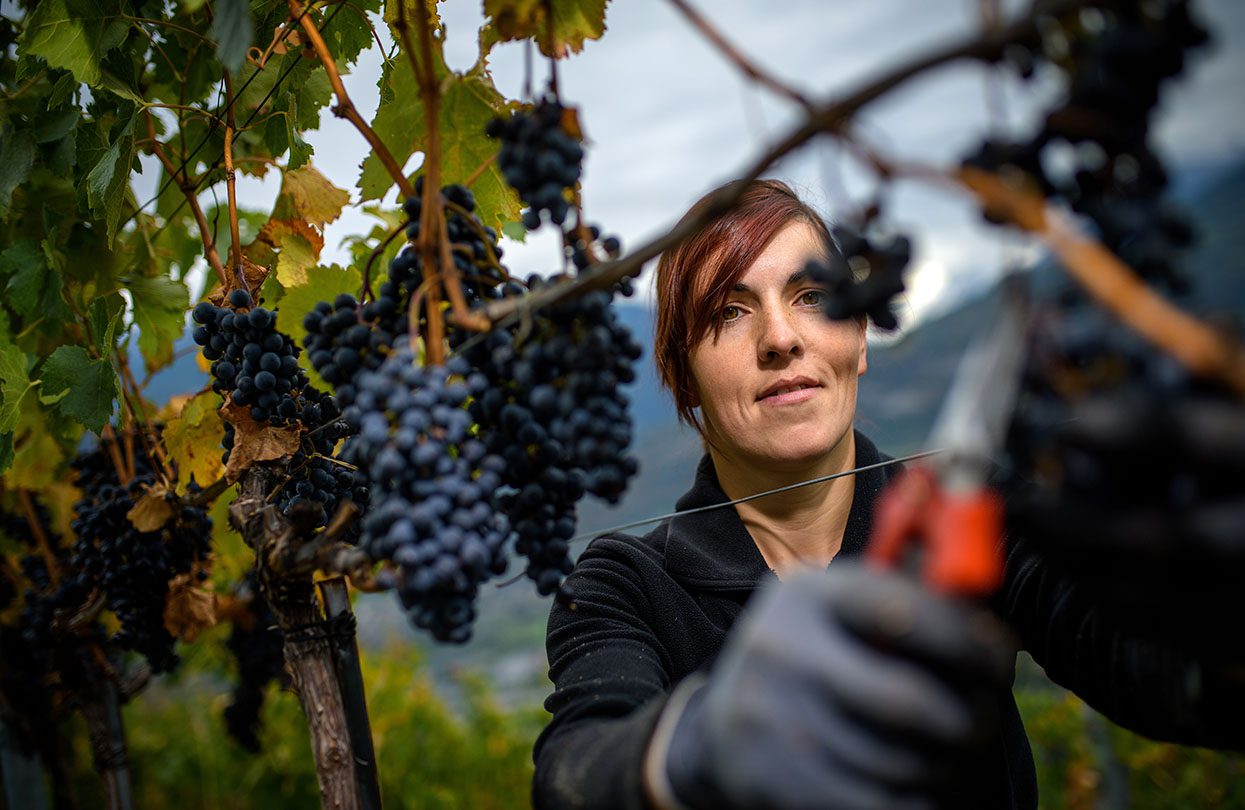
The beautiful vineyards in the Valais region, image credit Switzerland Tourism
Bonvin 1858 is the most ancient wine maison in Valais, contributing greatly to the fame of Swiss wines (it won Swiss Winery of the Year in 2014). Founded in 1900, the family-owned Maison Varone was the first winery to fill its wines into bottles instead of only using open containers. This ensured the commercial development of Varone wines in gastronomy and also with private customers in Switzerland and abroad. As the synergies between the two grew, a wine-park business emerged, an environment for vinophiles to discover not only the region’s wine, but also the exceptional landscape here.
The company was renamed and opened in 2010 as Les Celliers de Sion. Today, visitors can try traditional Valais food, witness the harvest, enjoy wine tastings, walk through vineyards, and take an e-bike tour of the destination. The main building, an architecturally breathtaking structure made of stainless steel plates, produces sustainable energy via solar roofing and houses a museum that details the production process from the tank to the wine.
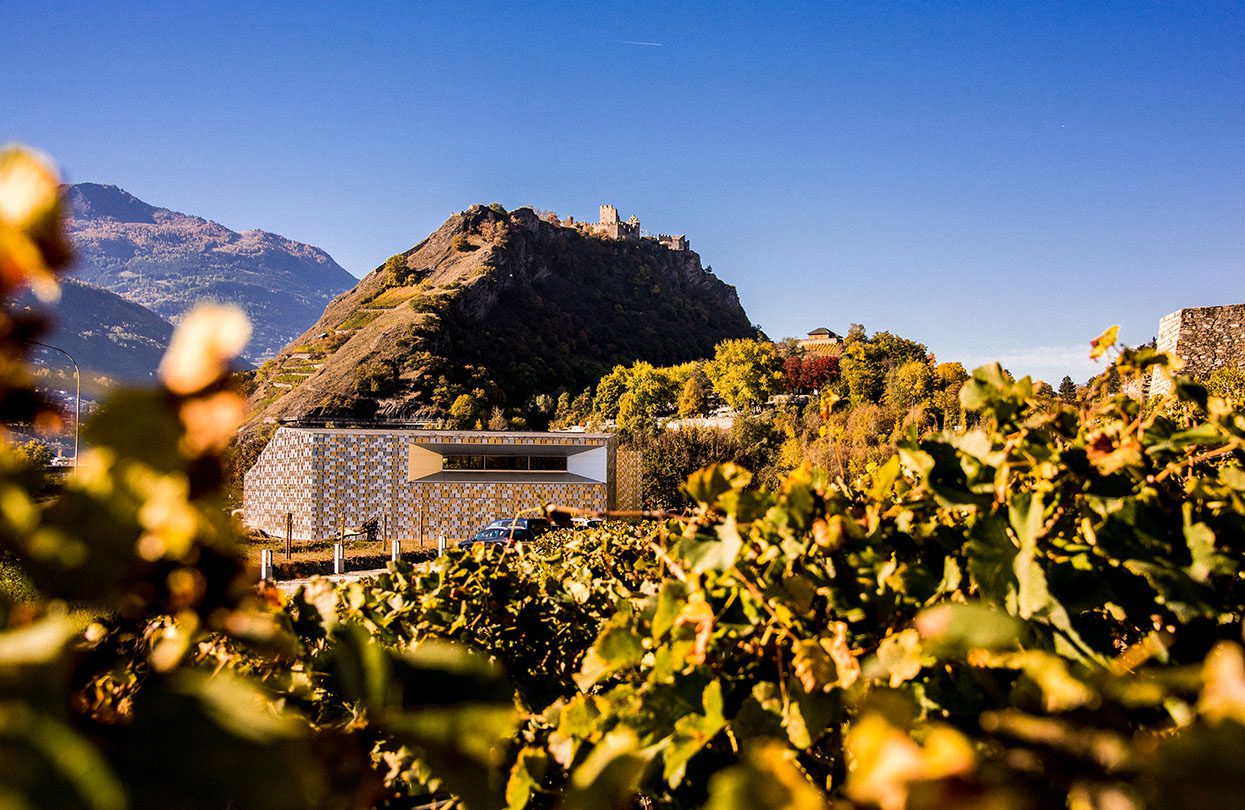
Les Celliers de Sion invites you on a unique discovery of the history and wines of the Bonvin and Varone estates, image credit Switzerland Tourism

Rediscover wine tasting using your 5 senses when at Les Celliers de Sion, image credit Switzerland Tourism
Expect to spend plenty of time in the glorious outdoors during a visit here. Download the app and follow one of a handful of routes around the south-facing, terraced vineyards, discovering delicious local produce and wonderful home-grown wines while touring on electric bikes. There are also a number of areas for sitting and enjoying some liquid refreshments dotted around the vineyards.
The Mazots du Clos du Château were former shelters and storehouses reserved for the winegrowers that now offer a private welcome area for people wishing to discover the wines of the domains of the Maison Bonvin at the place where they are grown, one that offers a breathtaking view of the Château de Tourbillon and the snow-covered peaks of the Val d’Hérens.
The Guérite Brûlefer is a charming little vineyard cottage situated alongside the Bisse de Clavau, and here the lures are the wines of the Domaine Bonvin and local Valais culinary products. On its shady terraces overlooking the Chateau de Tourbillon, visitors are immersed in the heart of the Sion vineyards.
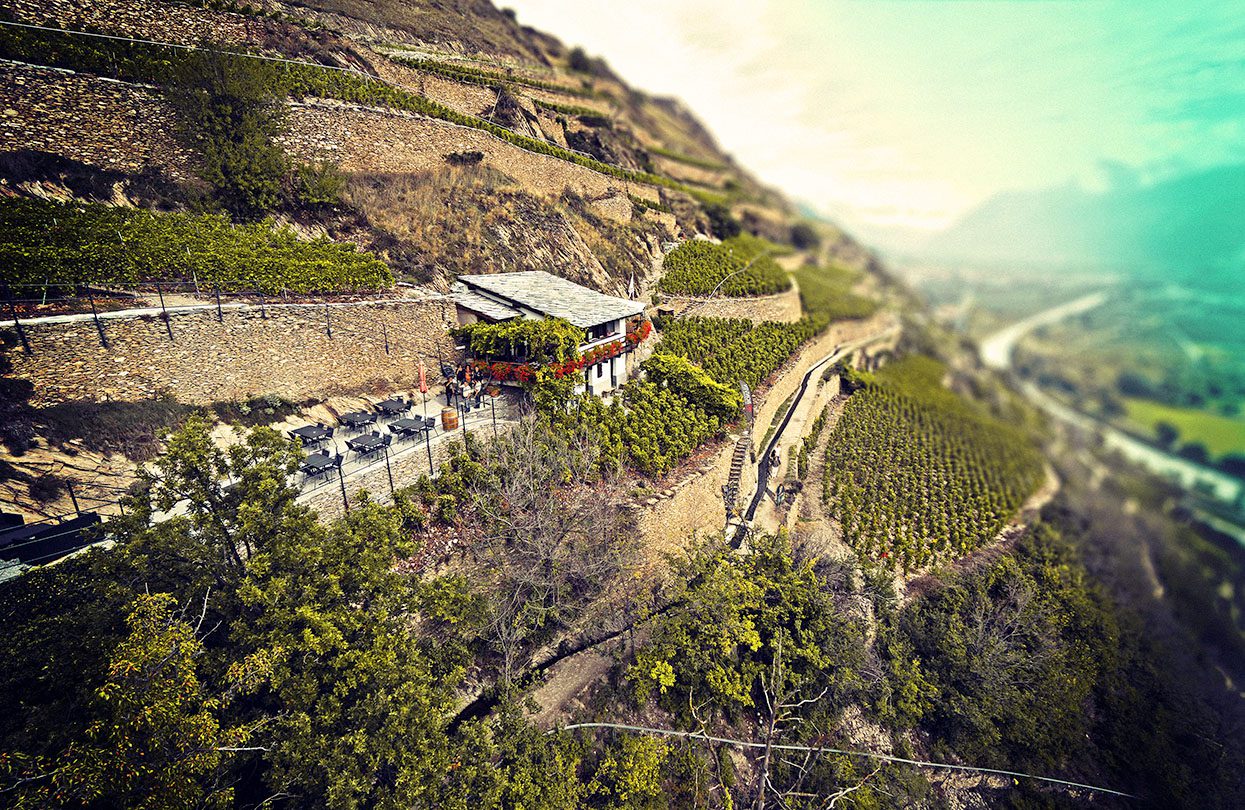
Magical stop along the Bisse de Clavau, la Guerite Brulefer invites you to discover the wines of Bonvin estate, image credit Switzerland Tourism
Cube Varone received the Swiss Heritage Society Award in 2013; this ancient, shady winegrower’s cabin close to the Bisse de Clavau is modern but rooted in tradition, where grand crus and an innovative menu await.
A yearly highlight, taking place this year on Saturday September 10, 2022 is the great Tavolata. Held at 5 pm at the foot of the vineyard, on tables that stretch as far as the eye can see, this spectacular, unmissable event features a wine tasting and evening meal, taken as dusk transforms into night, a passage of the day filled with shifting colours and laden with mystique.
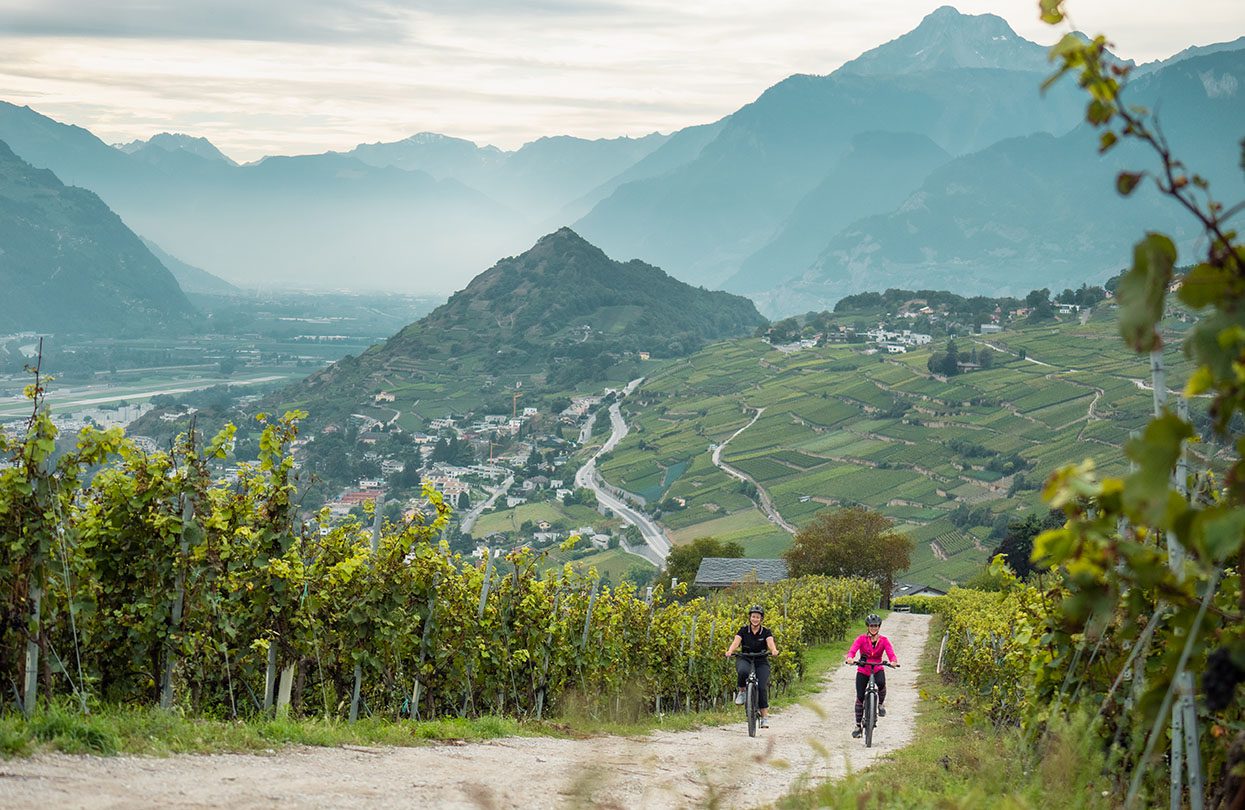
Explore the vineyard on the electric bikes and enjoy a majestic view of the Rhone Valley at Les Celliers de Sion, image credit Switzerland Tourism
Hiking in the Swiss Alps, a perfect way to discover Valais’s mountains, forests and glaciers
Nature’s colours are on full display during a hike on the Aletsch Glacier, a UNESCO World Heritage Site and Central Europe’s largest glacier, where a wander during the cool autumn weather promises clear views from multiple vantage points, and the full splendour of the ever-changing hues of the tree foliage.
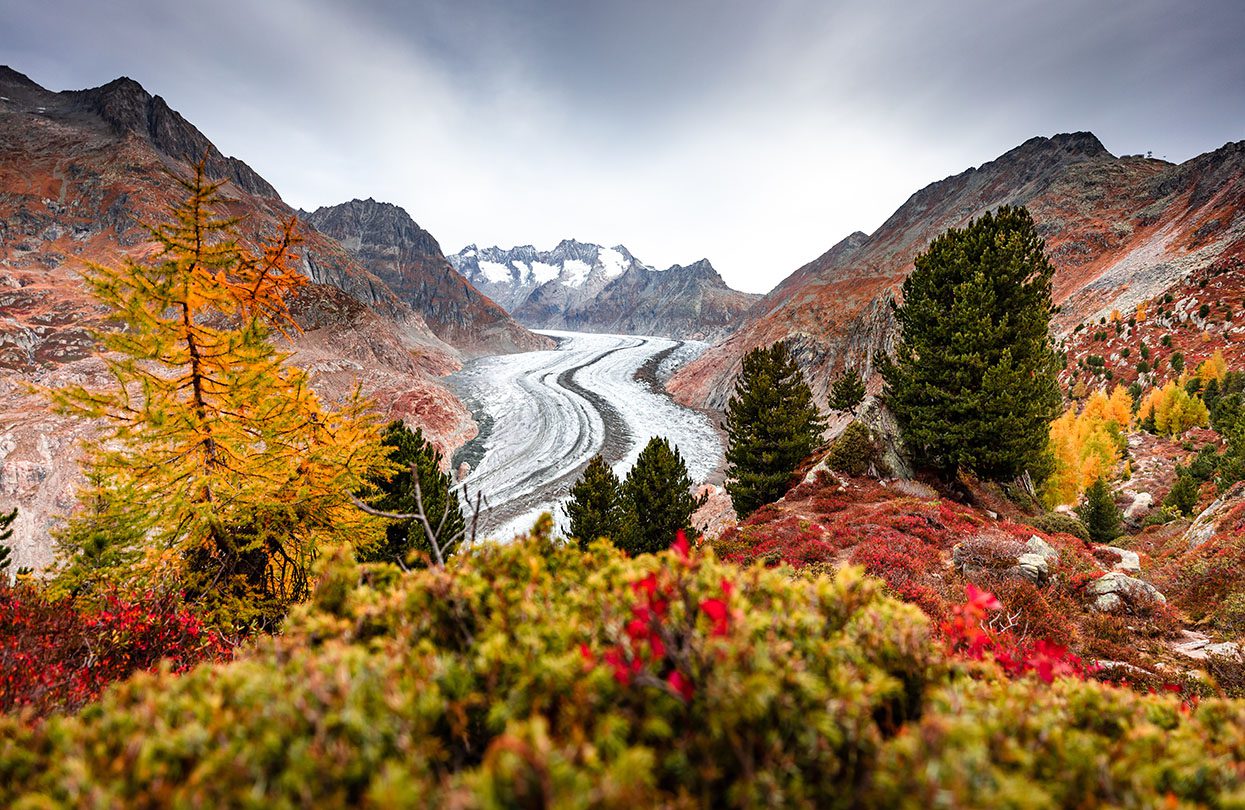
Aletsch Forest in autumn in the Aletsch Arena, image credit Switzerland Tourism
The ridge walk through varied landscapes takes walkers along stunning trails from Kühboden to the Aletsch Forest, and the vistas of the glacier and surrounding mountains are, simply put, magnificent. This route starts at the middle station of the Eggishorn cable car at Kühboden (Fiescheralp). A wide trail with great views leads to Bettmeralp, with the 4,000-metre peaks of the Mischabel massif and the Matterhorn constantly in view. The trail runs from the Bättmer Hitta mountain hut above the Bettmersee to the Moosfluh lookout point, and on to the Aletsch Forest down to Riederfurka and Riederalp with various places to eat and drink near the end. Spanning 12 kilometres in length, with an ascent of just under 500 metres, the walk should take less than four hours, a fine way to spend a morning before refuelling at lunch.
A classic route, the Aletsch Glacier Trail serves up endless views, an unforgettable experience on a European wonder of nature. This 12-kilometre route, again lasting a little under four hours, crosses the Grosses Gufer Glacier and continues down to Rote Chumma, with fresh glacier breezes providing a cooling effect. Carved into the rock, the wide mountain trail finally winds its way to Märjelensee lake, framed by picturesque cotton grass meadows.
Relax and discover the enchanting colours of Valais this Autumn
The joys of an Indian summer, that brief lull of time where the warmest season reaches into autumn, are a key attraction of the Région Dents du Midi, in the west of Valais. This part of the canton in autumn is an enchanting, gentle arena of shimmering colours, relaxation, and discovery, with rich culinary traditions, well-being experiences, and nature options.
Dents du Midi, an iconic mountain range, you won’t get tired of, image credit Switzerland Tourism
The region encompasses six charming villages perched high in the Swiss Alps, not far from the southeastern end of Lake Geneva. Located in the Val d’Illiez, these villages are part of Les Portes du Soleil, the world’s largest international ski area, with 1,000 square kilometres of natural beauty accessible year-round. During autumn, visitors can wander 800 kilometres of hiking trails and 600 kilometres of mountain bike, with quaint alpine restaurants and sunny terraces at strategic intervals along the way.
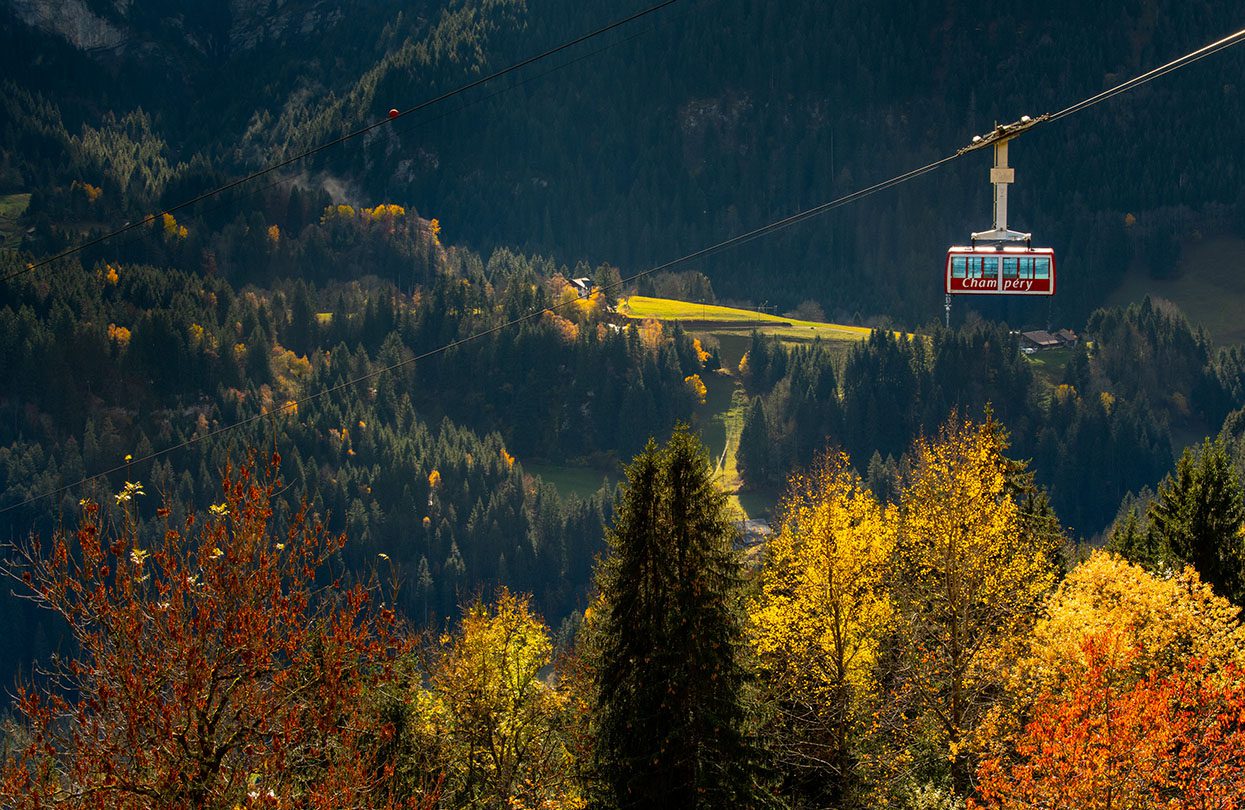
Autumn paints the landscapes of Region Dents du Midi with unreal and enchanting colours, image credit Switzerland Tourism
Since the first snowfall doesn’t typically arrive until November, most summer activities are available until the end of October, with plenty of flora and fauna ripe for exploration and interaction. Visitors might encounter animal reproduction, bird migration, forest mushrooms that are served with typical seasonal dishes such as the Chasse (game meat) and Brisolée (roasted chestnuts), as well as seasonal blueberries.
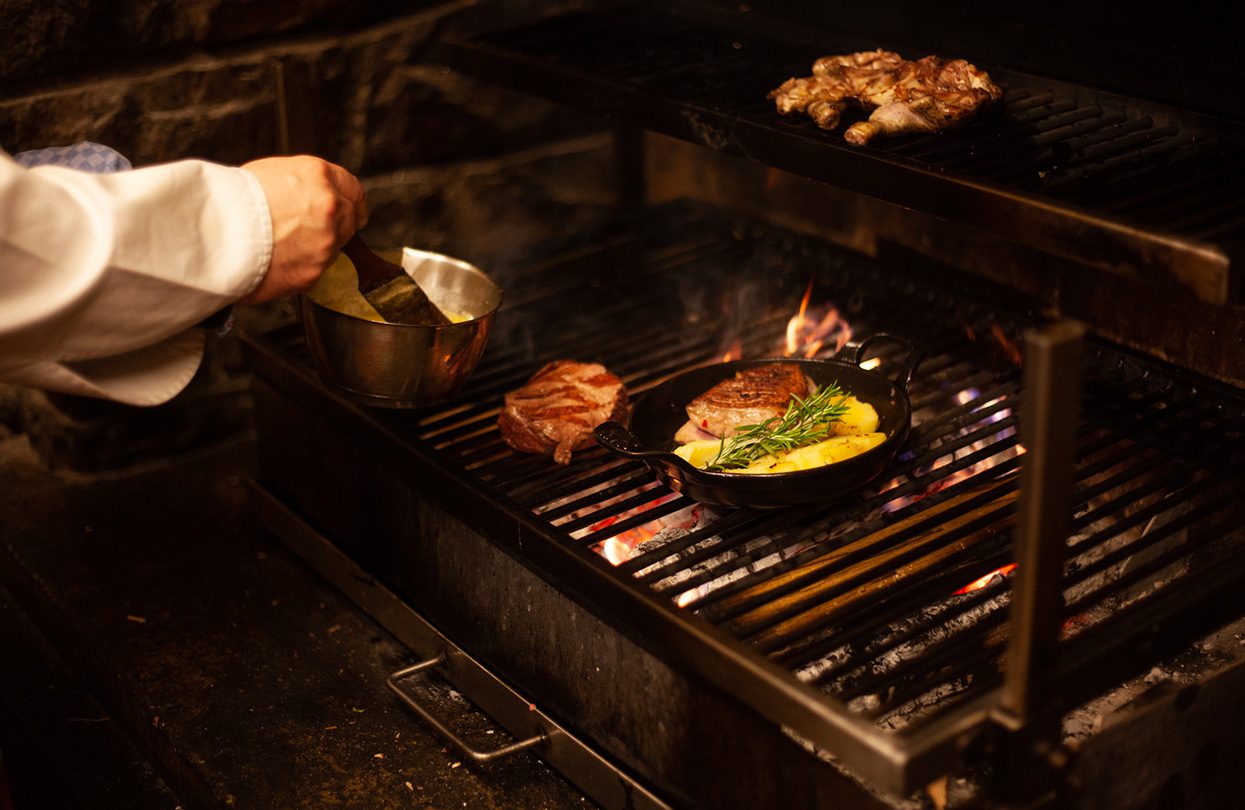
Typical seasonal dishes in Valais, image credit Switzerland Tourism
Autumn is the most colourful time of the year, with the changing foliage highlighted by the sharp, clear light that appears before winter. Near the village of Champéry, the Barmaz Plateau is an ideal destination for family outings, walks in the woods or picking mushrooms, with small inns offering food and accommodation until early October, and alpine farms offering quality homemade cheese.
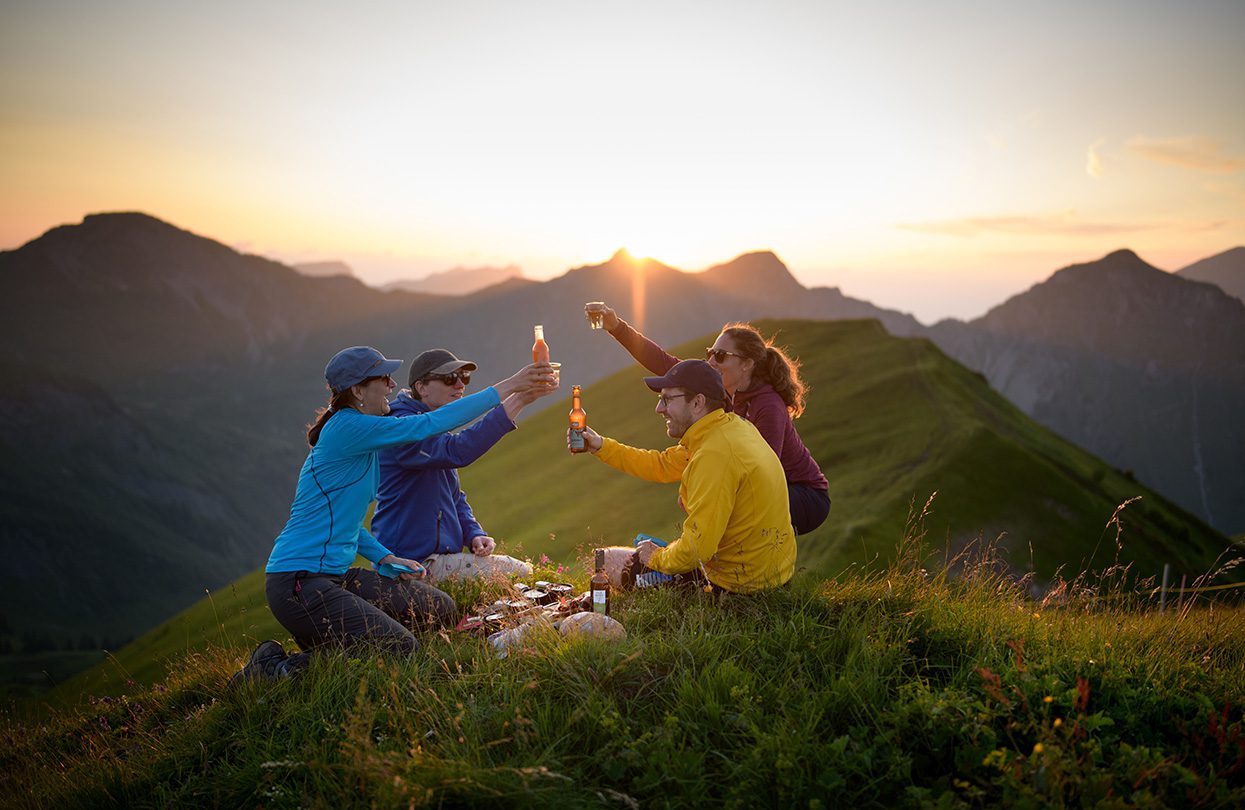
As the saying goes ‘After effort comes comfort’, share a delicious raclette on the summit when in Valais, image credit Switzerland Tourism

Good local food and drink make everyone happy, image credit Switzerland Tourism
For more relaxation, baths in Champoussin, Champéry, Val d’Illiez, and Morgins let travellers soak and recharge in heated waters, letting them rejuvenate for adventures that lie ahead. Such excursions include tours to pick wild herbs and prepare your own lunch or pastries using them, watching goats being milked, discovering how alpine cheese is made, and the chance to hear a stag bellow as it prepares to rut.
Explore the inside of Grande Dixence, the tallest dam in Europe
To the east, south of the ski resort Thyon, the power of nature is harnessed to marvellous effect to generate sustainable power. The Grande Dixence dam, the endpoint of a 16-kilometre trail-run race from Thyon every August, is a concrete gravity dam at the head of the Val d’Hérémence. At 285 metres in height, it is the tallest gravity dam in the world, the tallest dam in Europe, and the fifth-tallest dam on Earth.
As part of the Cleuson-Dixence Complex, the dam fuels four power stations, generating enough clean power annually to meet the needs of 400,000 Swiss households. The dam holds the Lac des Dix as its reservoir which, with a surface area of four square kilometres, is the second largest lake in Valais, and the largest lake above 2,000 metres in the Alps. Construction on the dam began in 1950 and was completed in 1961, before officially commissioning in 1965. With 75 water catchment points, the water that powers the turbines comes from a vast area, all the way from the Mattertal valley in the Zermatt region to the Val d’Hérens.
Since most of its water comes from glaciers, autumn is the best time to visit, with the lake often at full capacity in late September after the summer melt-off. What’s more exciting than all the statistics, is that visitors can explore the inside of Grande Dixence — which is heavier than the Great Pyramid of Giza, and whose concrete wall holds back 400 billion litres of water — on a guided tour, or walk the 700-metre crest linking the two slopes of the Dix Valley. Then, for the ultimate thrill, a 700-metre zip line launches into the void and skirts the concrete mammoth.
City tour, shopping, dining and cultural experiences at Brig
No trip to Valais would be complete with some time in Brig, a town whose fortune is intricately linked to the opening of commerce along the Simplon Pass by the local merchant prince Kaspar Jodok von Stockalper in the middle of the 17th century.
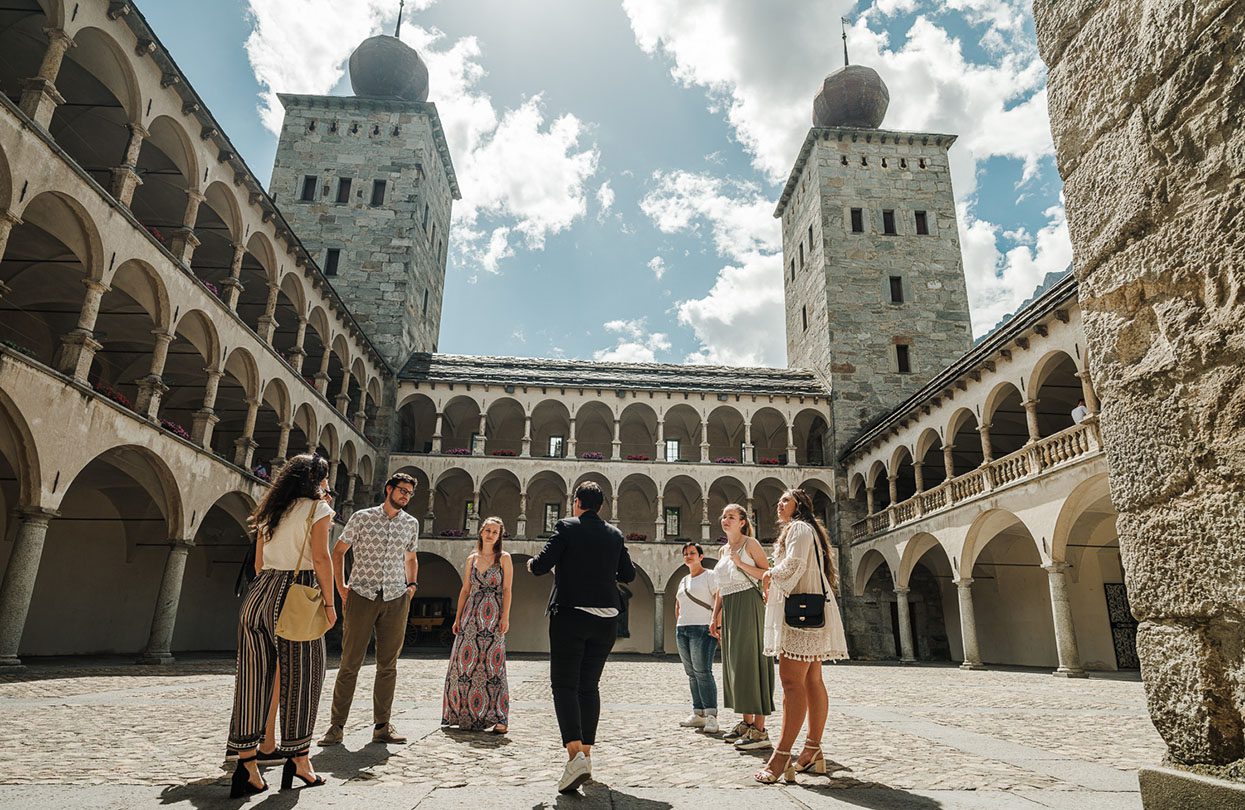
Guided tour of the baroque Stockalper Castle, image credit Pascal Gertschen
A starting point in the town is the stately Stockalper Castle, one of the most important Baroque palaces in the country; it offers guests guided tours that access many parts of the magnificent centuries-old mansion, with interiors that are as alluring and unique as Valais’ remarkable nature.

A fine café on the car-free town square, or a crispy pizza in the Italian pizzeria Brig Simplon has a wide range of dining options, image credit Pascal Gertschen
Elsewhere in Brig, Bahnhofstrasse teems with shopping, bars, and dining that ranges from traditional kitchens to Asian restaurants. Brig also boasts its own thermal baths and the lovely old town has stately houses, cosy inns and hotels, and an otherworldly ambience, one that weaves an enchanting spell that is sure to make your trip to Valais a true escape. 
Subscribe to the latest edition now by clicking here.
© This article was first published online in Sept 2022 – World Travel Magazine.
The post 5 Things You Must Do In Valais This Autumn Season first appeared on World Travel Magazine.
]]>The post City Escape To Zurich: 5 Outdoor Adventures For The Quintessential Swiss Vacation first appeared on World Travel Magazine.
]]>Summer traveller’s guide to Zurich. Looking for an outdoor adventure on your next city break? Look no further than Zurich! There is plenty to do outdoors, from swimming and boating in Lake Zurich and Limmat River to hiking in the Alps and exploring the forest trails. In addition, you can enjoy excellent gastronomy outdoors, with restaurants serving local specialities al fresco, old-fashioned riverside leisure spots and trendy rooftop bars with breathtaking views over the lake, all within walking distance. And if you’re looking for some exercise, why not try running or biking in this beautiful city?
Find your sense of being in Zurich’s waterways this summer
Summer in Zurich is all about freedom; the freedom to embrace and enjoy nature, to jump into the crisp, fresh waters of the lakes and river of the city and regain the sense of being alive. It is the pursuit of this basic need that has created an entire culture that, from dawn to dusk, revolves around the numerous water bodies in and around Zurich.
Take for instance the outdoor pools, or badis, in Zurich. These badis are a hive of activity at any given time. By day it’s yoga classes, sunbathers working on their tans while catching up with friends or folks diving off the wooden boards into the cool water during lunchtime; by night, you can find live music being performed or drinks flowing freely among those gathered around the poolside bar. The 18 outdoor swimming areas within Zurich’s city limits offer a variety of experiences for visitors and locals alike.
The historic Seebad Utoquai, located on Lake Zurich’s bustling lakeside promenade between Bellevue and Zürichhorn, has been providing guests with an opportunity for refreshing swims in this inviting waterway for over 120 years. In addition, a book box from Pestalozzi Library provides free reading material, while the restaurant here offers Mediterranean delicacies- all you need is your swimwear (and maybe some sunscreen). After enjoying these amenities, there will be no going back home early.

Badi Utoquai, image by Christian Beutler, Zürich Tourismus
Just a stone’s throw from Zurich Main Station, bathers can drift leisurely downriver the River Limmat at Flussbad Oberer Letten, featuring a 400-meter-long swimming channel with a 2-meter high diving platform, two beach volleyball courts, sun terraces and a restaurant and bar stocked with snacks and drinks.

Flussbad, Unterer Letten, image by Siggi Bucher, Zürich Tourismus
The Frauenbad at Stadthausquai, built in art nouveau style, adds a touch of femininity, making it one-of-a-kind on offer among other bathing facilities around town. Catering to only female guests, the open-air bathing facility has two over 30-meter-long pools, deck with sunshades, a small library stocked with reading material, a kiosk with sandwiches, salads & fruit juices and wellness services such as massage and yoga. Three evenings a week, this beautiful facility transforms into the “Barefoot Bar” for both men and women, with music, dancing and tranquil views of the Grossmünster, Fraumünster, and the River Limmat.
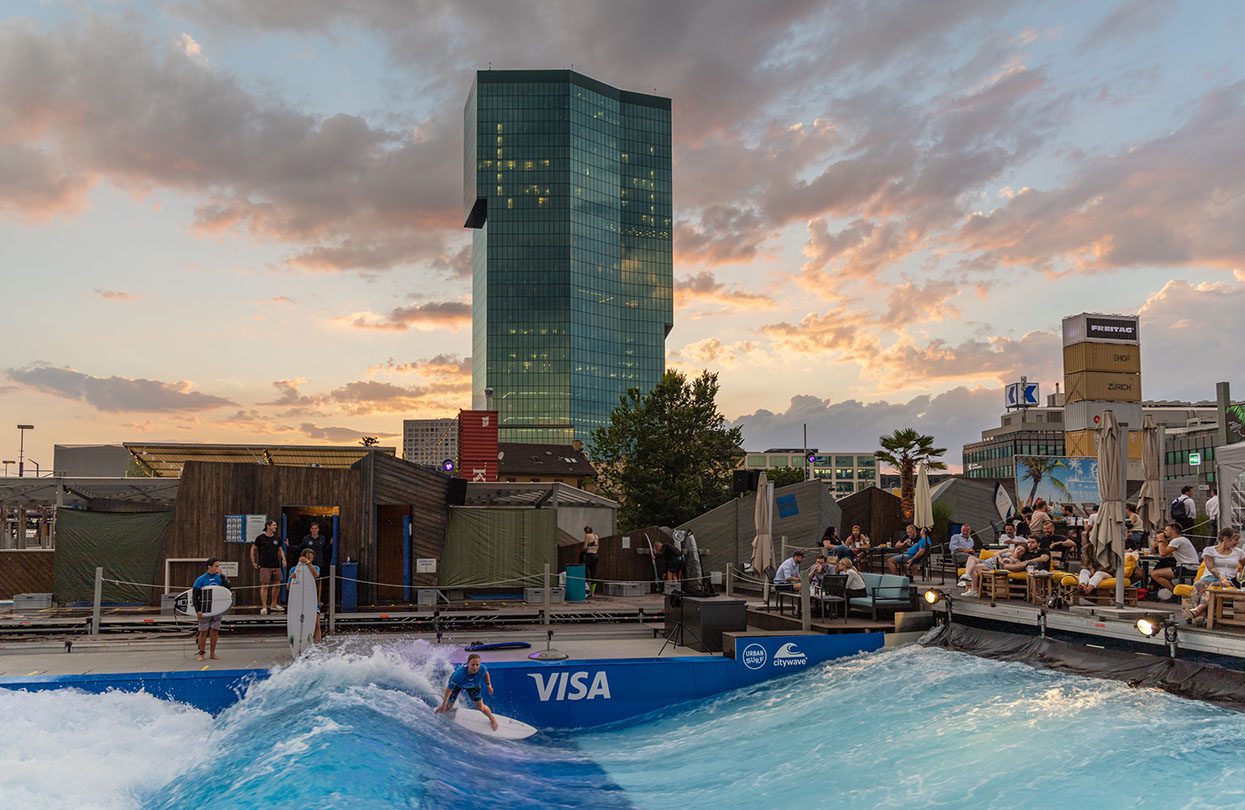
Urban Surf, image by urbansurf.ch
Located in the trendy Zurich-West quarter, the Urban Surf is an ideal spot for surfing, with a never-ending supply of water and professional surf instructors on hand. Urban Surf is situated at the feet of the Prime Tower and the Freitag Flagship Store, meaning that there is plenty to see and do in the area. The atmosphere is chilled and summery, ideally suited to relax and have fun.
Boat rides are a beloved activity in Zurich, and there are many ways to enjoy them. You can join a lake cruise that runs on a fixed schedule or rent a private boat at the Lago located at Utoquai. Pedal boats, or ‘Pedalo’, are also a popular option, and they’re open to everyone. Whatever way you choose to enjoy the boat rides in Zurich, you’re sure to have a great time.

Pedalo, image by Elisabeth Real, Zürich Tourismus
Explore the city on foot: running groups and running routes in Zurich
Zurich is a runners’ paradise. The city has many safe running routes and fitness trails that showcase the city’s thriving nature scapes, lake and tourist attractions. Zurich’s running routes, suggested by Zurich Tourism and On Running Shoes, range from 3km, 5km to 10km and even 42km. So, whether you’re a beginner or a seasoned pro, Zurich has the route suitable for you.
Zurich is home to a number of running groups, making it easy for residents and visitors alike to enjoy a morning or evening run with others. Züri rännt, for example, was founded in 2000 and has since become a passionate and lively community dedicated to the social aspects of running together. Similarly, City Running is Zurich’s biggest runners’ network, open to all levels of runners and offering free guided tours several times a week.
These groups provide not only a great way to stay fit and enjoy the outdoors but also a chance to meet new people and explore Zurich’s diverse neighbourhoods. Whether you’re an experienced runner or just getting started, Zurich’s running groups will surely give you a memorable experience. So why not lace up your sneakers and hit the Zurich streets this summer?
One of Zurich’s popular running routes is the 3km Sightseeing Jogging Run, which takes runners on a tour of the city’s highlights, including the old town, Zurich Lake, and the Opera House. The route begins at Seebad Enge, a popular open-air bathing facility, and leads through the Rentenwiese park to Bürkliplatz. From here, runners can cross the former moat and run back along the other side. Next, the route heads to Bellevue for a breathtaking view of Zurich Lake and the Alps beyond before continuing to Sechseläutenplatz and Utoquai. The final stretch takes runners past Seebad Utoquai and to Blätterwiese, where they can enjoy views of Zurich’s skyline and celebrate the morning’s achievement by taking a refreshing dip in the lake!

Running Route, Seebecken, image by Christine Benz, Zürich Tourismus
The Zurich-West 5km route is an excellent option for those looking to explore an urban setting. The route starts by the river Limmat and runs past Flussbad Unterer Letten, the city’s oldest riverside bathing facility. It then continues past the Migros Museum of Contemporary Art and the glass Prime Tower before ending at the Freitag Tower, made of 17 stacked shipping containers rising 26 meters. From there, runners can head back to the river, following the viaduct that now houses boutiques, restaurants and event spaces. To end, runners can enjoy an invigorating dip in the river. This route is excellent for those looking to experience Zurich’s urban renewal.
E-bike tours: a fun and easy way to see more of Zurich
As anyone who has spent time in Zurich will know, the city is an ideal place to explore on two wheels. Whether you’re a fitness enthusiast looking for a new way to stay active or simply want to see more of the city than you would by walking, a guided biking tour is a great option. Thanks to the many bike lanes and other cycling amenities, it’s also a safe way to get around.
You’ll get to see the best parts of the city and some hidden gems while getting a workout in. With a guided bike tour, you’ll have a local expert showing you the ropes, so you can simply relax and enjoy the ride. Stop along the way for photo ops, coffee and pastries, and experience the city like a true local. You’ll be surprised at how much there is to see and do!

E-Bike Tour, image by dominikbaur.com, Zürich Tourismus
E-bikes have become a popular mode of transportation in Zurich, thanks to their electrically generated power, making climbing hills and riding long distances much easier than a traditional bicycle. EGO Movement, a Swiss e-bike company, provides stylish e-bikes for tours of the city led by expert Zurich Tourism guides. These small group tours (max nine persons) are a great way to explore the city like a local and are offered in English and German. Private tours are also available upon request. And with Zurich Tourism’s convenient online booking system, it’s easy to sign up for a tour that fits your schedule.
To make bikes more accessible to visitors who wish to explore Zurich at their own pace, Züri Rollt, a project of a local NPO, offers free bike rentals from two central locations for a small refundable deposit of 20 CHF per day with e-bikes on rent for a fee of 20 CHF per day. So either you can go with the flow and pick up a bike on the spot or plan ahead by booking online for convenient access at any time.

Züri Rollt, image by Elisabeth Real, Zürich Tourismus
The ‘E-Bike Tour Public Art’ is a unique group tour that combines Zurich’s trendy quarter with great outdoor artwork. Check out modern sculptures, murals, quirky art installations and hidden treasures just waiting to be found by visitors on this one-of-a-kind excursion. There are some 1,300 public works of art to be found in and around Zurich. The city has an extensive bike paths and lanes network, and the Schweiz Mobil website provides a helpful map so cyclists can plan their routes in advance.
Explore Zurich’s gastronomy with its rooftop and garden terraces
The biking and jogging tours of this fine Swiss city only add to the appetite – it’s time for you to explore all things food-related in stylish Zurich at locations that will set your social media profile ablaze. Zurich’s gastronomy scene is world-renowned, attracting food lovers from near and far. The city is home to a wealth of Michelin-starred restaurants and lesser-known eateries that are no less delicious. Gastronomy isn’t just about eating, however. Zurich is also home to several world-class wine producers, and many of the city’s restaurants offer extensive wine lists.
View this post on Instagram
Zurich’s uniquely stylish rooftop and garden terraces, perfect for those long summer evenings, offer stunning views of the cityscape, making them ideal for romantic dinners or simply unwinding after a day exploring the city. Gastronomic offerings here are diverse, so whether you’re looking for fine dining, a casual meal or cocktails, you’re sure to find something to suit your taste.
The sophisticated La Réserve Eden au Lac Zurich Hotel is famous for its lakeside location, spectacular views and La Muña, the fantastic restaurant on the sixth floor with two rooftop terraces. A Peruvian and Japanese-inspired menu is served on their terrace and is perfectly paired with an impressive wine list. From this rooftop destination, you can enjoy 360° views of Lake Zurich, the historic city centre and the Alps. La Muña is the ideal destination for a sunny lunch, sunset cocktail or romantic dinner.

La Muña, La Réserve Eden au Lac, image by Gregoire Gardette, La Réserve
The Nest at Storchen Zürich is a must-visit modern and stylish rooftop lounge for those looking to enjoy the view with their friends. With an elegant bar that offers stunning visuals of both city lights and river banks during evening hours – this lounge has something perfect no matter what you’re craving.
Roof Garden is an elegant rooftop restaurant and bar on the top floor of the Globus department store at Bahnhofstrasse. The menu offers French Mediterranean dishes with fine wines for those who want to indulge in true luxury and good taste. So, this place has it all if you’re looking for a romantic sunset overlooking Zurich or need some downtime after shopping at the luxurious department store below.

Frau Gerolds Garten, Bar, image by Elisabeth Real, Zürich Tourismus
Next to Zurich’s Primetower is Frau Gerolds Garten, an urban experimental landscape home to various bars, eateries, and shops. The shipping containers around the garden are the building blocks for this unique space, with the outdoor eatery offering local and seasonal gastronomy. The garden is also a location for balmy summer nights, with its raised garden beds and greenery. This urban garden is a feel-good oasis that encourages community spirit and with its abundance of unique dining options, the green zone is sure to please even the most discerning foodies.
Day trips from Zurich allow you to enjoy the best of Switzerland
Zurich is an ideal base for exploring the Swiss Alps. Day trips from the city allow you to enjoy the best of Switzerland: the excitement of the mountains and the comfort of an urban centre without spending the entire vacation packing and unpacking luggage while on the move. With so much to see and do in Zurich, you’ll never have to worry about missing out on any of the city’s many attractions. From museums and shopping to gastronomy and events, there’s something for everyone in Zurich. So whether you’re looking for an adrenaline-filled day of skiing or a leisurely hike through the countryside, make sure to add multiple guided day trips to your Swiss adventure.
Day trips from Zurich to Mt Rigi are popular for visitors to Switzerland. Mt Rigi is known as the ‘Queen of the Mountains’ and offers stunning views of the Alps. The trip up to the summit is by aerial cableway, followed by a ride on Europe´s first cog railway. The journey takes one hour and thirty minutes from Zurich. Once at the top, visitors can hike over meadows with Alpine flowers, enjoy alpine gastronomy such as Rigi Alpkäse fondue and mountain beer at the various cosy restaurants in the area.
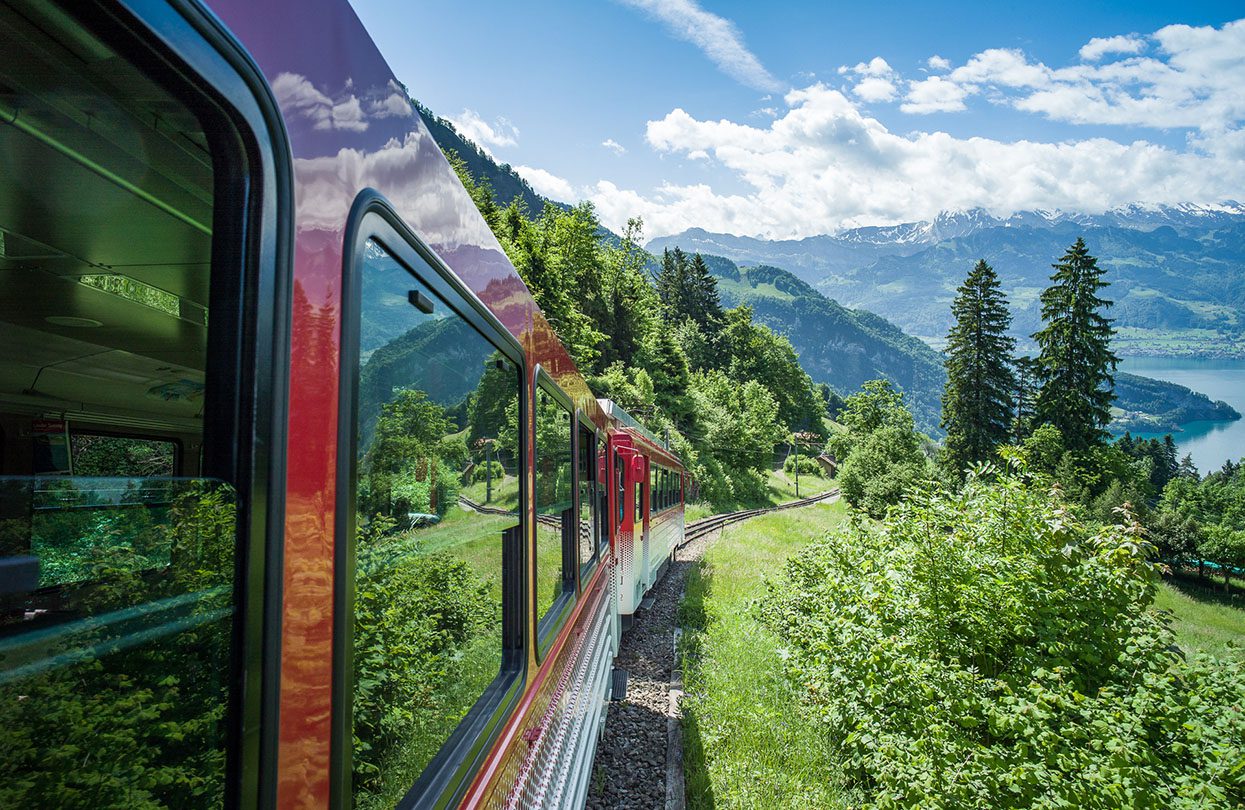
Rigi, Bahn, image by Gaudenz Danuser
When you need a revitalising break, head to Mineral Baths & Spa Rigi Kaltbad for some pampering. With an outdoor pool with sweeping Alpine panorama, luxurious facilities and an excellent selection of massages, it will be a challenge to say goodbye to Mt Rigi. The descent is by cog railway to Vitznau and then a cruise to Lucerne. The old town of Lucerne is among the most beautiful in Switzerland and well worth exploring.
Day trips to Stoos from Zurich are popular for a variety of reasons. First and foremost, the views of central Switzerland from the village are simply stunning. In addition, the ride on the Stoosbahn, the world’s steepest funicular railway, is an exhilarating experience. The cabins are state-of-the-art and rotate to keep level as the rail climbs up 1.7 km, overcoming a height difference of 744 m. Zip up the mountain at 10 m per second! Finally, the village of Stoos is located 1,300 m above sea level, making it a good starting point for hikes, especially the famous ridge hike on top of the mountain. So whether you’re looking for an exciting thrill ride or a peaceful escape from the city, a day trip to Stoos is sure to please.
Heading on a day trip to Jungfrau Top of Europe from Zurich is fun. At 3’454 meters, the Jungfrau train station is the highest in Europe, and provides breathtaking views of the Aletsch Glacier, the largest and longest glacier in the Alps. Visitors can enjoy the snow all year round, making it the picture-perfect destination for a summer day trip. The journey up to Jungfrau is an adventure in itself, with stops at charming mountain villages along the way.

Rheinfall, image by Gaetan Bally, Zürich Tourismus
There are many more summer day trips that can be taken from Zurich. One such trip is to Rhine Falls, the largest waterfall in Europe. This spectacular sight is located just a short distance from Zurich, and many tour companies offer trips to the falls. Another popular summer destination is Rapperswil, a village situated on the south coast of Lake Zurich. This charming village is known as the city of roses, as over 20,000 roses grow there in the summer months. In addition, Rapperswil has many restaurants, making it a dainty place to spend a summer day. You’ll never have a dull moment with so much to see and do in both the city and the countryside. 
Subscribe to the latest edition now by clicking here.
© This article was first published online in July 2022 – World Travel Magazine.
The post City Escape To Zurich: 5 Outdoor Adventures For The Quintessential Swiss Vacation first appeared on World Travel Magazine.
]]>The post Savour The Swiss Alps This Summer At Mt Titlis first appeared on World Travel Magazine.
]]>Switzerland, an adventure for all ages. Rising out from the Uri Alps, between the cantons of Obwalden and Bern, Titlis tops out at 3,238 metres above sea level, and is a mountain easily accessed from the alpine town of Engelberg. Titlis is a commanding presence in these parts, a peak that promises plenty of outdoor activity throughout the year, but one that is especially attractive in the summer for its host of sporty options. While known by many as the site of the world’s first rotating cable car — the Titlis Rotair debuted in 1992 — Titlis also receives plaudits for a trio of fantastic summertime adventures.
Zipline Trübsee Flyer at Mt. Titlis
The Trübsee Flyer at Titlis is a zipline that riders will find thrilling not only for the unbridled excitement of the ride, but also the view that greets them on the speedy journey. Here, after buckling up into the safety harness and counting down to the start, guests will take to the air to survey a uniquely Swiss panorama of jagged mountain peaks, rolling green hills, rows of towering pine trees, clear blue skies punctuated by languid clouds, and to the right, the broad expanse of lake Trübsee.
The zipline chairs, of which there are two that can travel the line at the same time (letting visitors share the fun), are secured to a steel cable, and the ride unspools over 500 metres, starting from just above the Trübsee Alpine Lodge to end 40 metres lower, next to the adventure playground by lake Trübsee.

Trübsee Flyer, image by Switzerland Tourism
This is a summer ride that promises a rollercoaster of emotions, from the anticipation of the adventure as you approach the platform and are strapped into the harnesses by the diligent staff, to the feelings of elation and freedom when rushing through the air, to the sense of limitless joy as you take in the singularity of the moment, the scenery, the opportunity to do something extraordinary in this region of immense natural beauty.
Life on the Lake at Mt. Titlis
At the foot of Titlis mountain, and set above the village of Engelberg, whose centre is a monastery that dates to the 12th century, Trübsee is a picture-perfect alpine lake with calm waters, encircled by mountains, a vista that words fail to do justice. This is where, at 1,800 metres above sea level, to find the Trübsee Alpine Lodge and where several picturesque hiking routes start. It’s also the site for rowboat excursions. There are six rowing boats for hire on Trübsee, and each of them has space for four people, making them perfect for a family or small group of friends.
The water is always calm (but life jackets are provided as standard), so this activity is suitable for casual adventurers, family groups, and even enthusiastic rowers that want to get their hearts pumping with some cardio exercise. The boats are free to use, though the local authority suggests donations of Swiss francs 10 (about S$14) per hour to be placed in the donation box on the jetty — these funds help toward the maintenance of the jetty.

Rowing boats for hire on Trübsee, image by Switzerland Tourism
Rowing on the lake is a supremely peaceful endeavour, quiet, refreshingly low-tech, simple, almost elemental in its enjoyment, and linked to nature with a sense of intimacy: The ability to stop, admire the landscape, take pictures, and bask in the serenity makes it an unforgettable adventure for all generations.
Experience the thrill of climbing Via Ferrata routes in Engelberg
Translating from the Italian for iron way or way of iron, a via ferrata is a climbing route that often includes iron steps bored into rock face. Travelling along one is a guarantee for excitement, a way to commune with the mountain while traversing it safely.
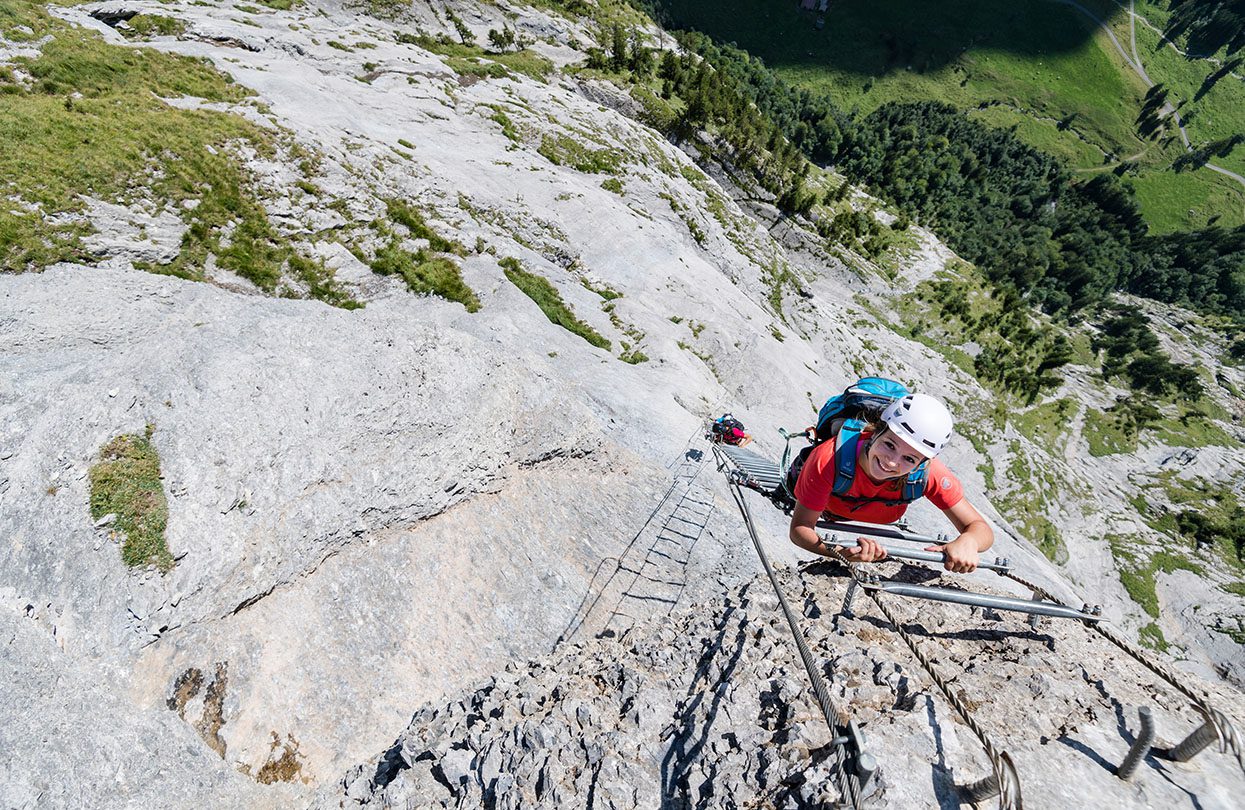
A via ferrata is a climbing route that often includes iron steps bored into rock face, image by Switzerland Tourism
While via ferratas appear throughout the world, Engelberg, an insider gem for vertical sporting adventure where the altitude ranges from 1,000 metres at the valley floor to more than 3,000 metres at the top echelons, boasts a whopping six via ferratas. (It also has eight climbing gardens, many boulder spots and an array of alpine climbing routes). The six via ferrata routes range in difficulty, allowing everyone from beginners to experts to test them out.
The route over the Brunnistöckli (2,030 metres above sea level) is designed as a trial via ferrata, suitable for children with mountain experience accompanied by adults. Running 1.6 kilometres in length, and taking a little over an hour to complete, it has a short approach, and ascends almost 200 metres in altitude. Two suspension bridges guarantee a nice experience for the whole family.
Linked to this route, the Zittergrat is an easy introduction to the more difficult via ferrata routes. It is considered a supplement to Brunnistöckli but was specially set up as a short and difficult practice via ferrata, south-facing, strenuous, but excellently secured.
More challenging, the 5.2 kilometre, three-hour via ferrata to the Graustock (2,661 metres) allows a direct ascent of the mountain over an exposed ridge with breathtaking expansive views of its north face and the Engelberg valley. From the summit, the panorama takes in the peaks Titlis, Spannort, Rigi, Mittelland and Pilatus and the Bernese peaks Wetterhörner, Schreckhorn and Finsteraarhorn.
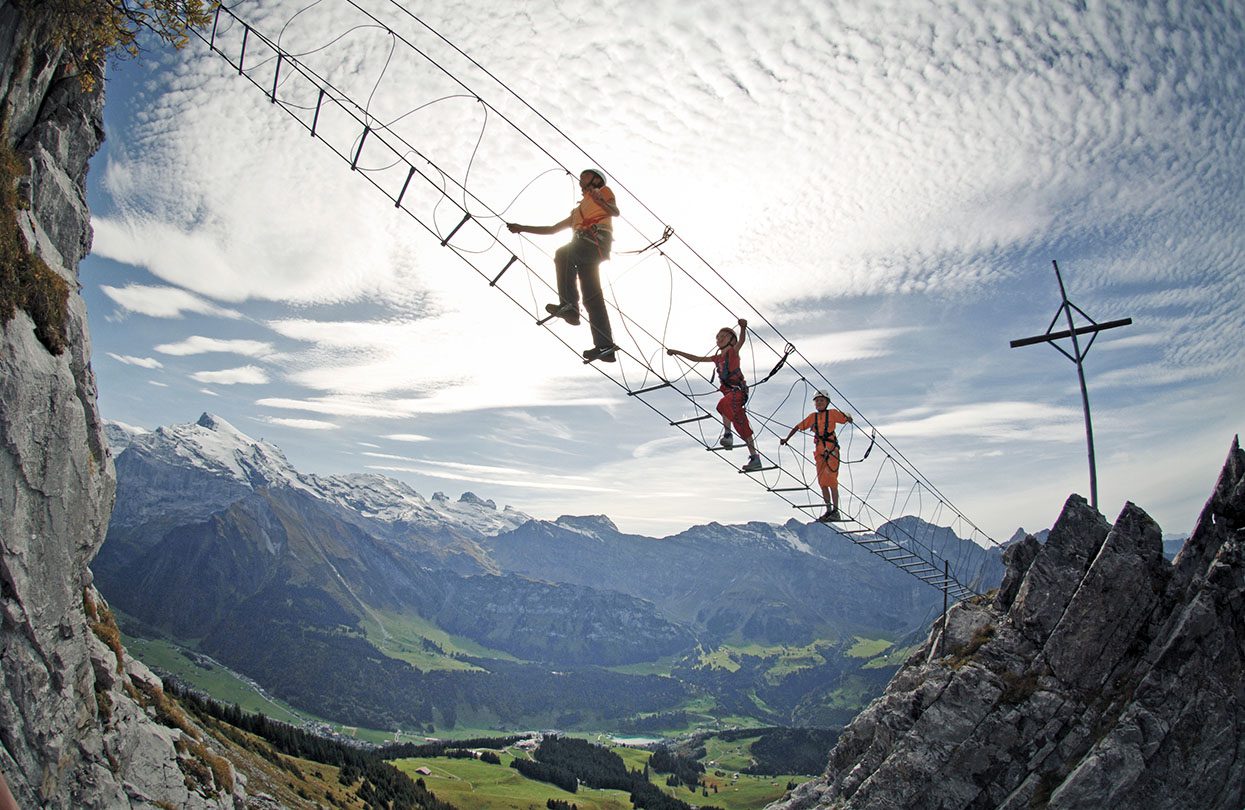
Via Ferratas in the Brunni area, image by Switzerland Tourism
The most challenging route is the Fürenwand, a steep and high wall that used to be an extremely demanding technical climb, suited only to the accomplished climbers. With the introduction of the via ferrata, the route has become more accessible, and the entire trip of 6.8 kilometres takes 4.5 hours to complete. This trip is hard work for sure but, as with everything on and around Titlis, it’s unquestionably worth the effort.
Titlis Cliff Walk, a daring expedition for thrill-seekers
Looking for an adrenaline rush? Titlis Cliff Walk, an extraordinary feat of engineering, is the perfect destination for thrill-seekers. With a suspension bridge that is the highest in Europe, this 100metre catwalk is not for the faint-hearted. But if you’re up for the challenge, it’s an unforgettable experience.
Soar 3,041 metres above sea level and walk 500 metres off the ground on this steel pathway. With stunning views of the Swiss Alps, it’s an exhilarating experience not to be missed. But be warned – it takes nerves of steel to cross the 1 metre wide, 100 metres long Titlis Cliff Walk! There is no feeling quite like that of taking the 150 heart-pounding steps of the Titlis Cliff Walk. For those who can conquer their fear and step out onto the narrow bridge, the view is truly breathtaking.
From the viewing platform, 44 peaks are clearly visible, ranging in altitude from 2900m to 4545m. The Uri Alps surround the glacier below, and the picturesque views are simply breathtaking. On a clear day, it is said that you can see all the way to Italy.
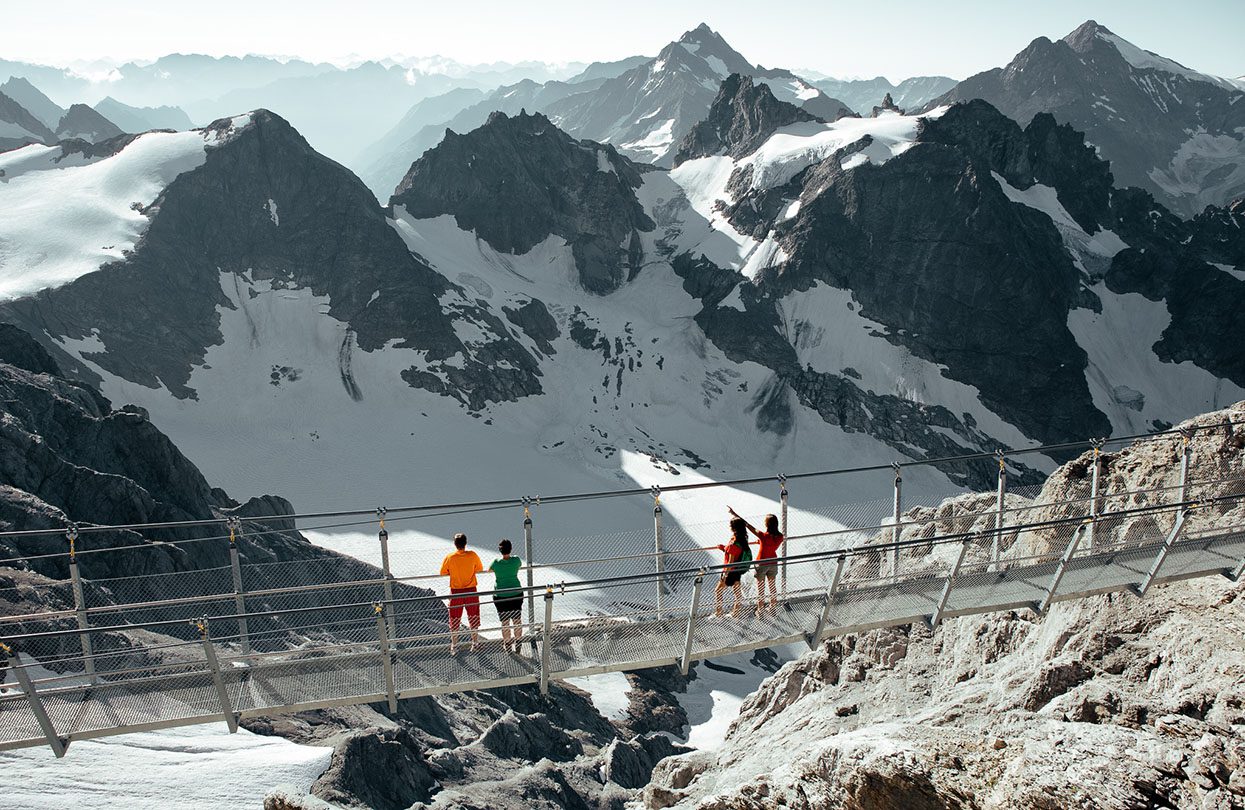
Titlis Cliff Walk in summer, image by Switzerland Tourism
The 30-minute ascent from Engelberg to Titlis Cliff Walk covering two cablecar rides is just as exciting as the destination. The first cablecar starts from Engelberg at the base of the mountain, crossing a pine forest and continues along a huge rocky cliff face to the midway station Trübsee at an altitude of 1800m. From the midway station the ride continues up to 2428m high station Stand. From there the final ascent to Mt. Titlis is aboard Titlis Rotair, the world’s first rotating cable car that gives 360° views across the central Swiss Alps. Whether you’re an experienced thrill-seeker or someone who prefers to keep their feet on solid ground, the Titlis Cliff Walk is sure to leave a lasting impression.
Titlis Glacier Park, snow fun in the summer
In Switzerland, snow fun is not just for wintertime – at Titlis Glacier Park, you can enjoy flaky, fresh snow all year round. Located at more than 3,000m above sea level, the park offers a unique snow experience in the heart of the Alps. With its stunning views and wide range of snow-based activities, Titlis Glacier Park is the perfect place to enjoy a summer snow day.
What’s more fun than sliding down a snowy mountainside on your own two feet? With snow tubing, of course! You can enjoy this summertime favourite at any time with nothing but sunshine to keep you company. The sleek design and liberating feel of the track make it an excellent activity for all ages. And with no need for previous experience, it’s the perfect way to get your snow fix without any hassle.
Whether you’re a novice or pro, there are plenty of ways to have fun at the mountaintop. The Glacier Park’s summer activities include snow play equipment like Sit-Skis, Snake Gliss or Minibobs that will transport riders quickly down the novel track while the ‘magic carpet’ conveyor belt effortlessly takes you back to the top.
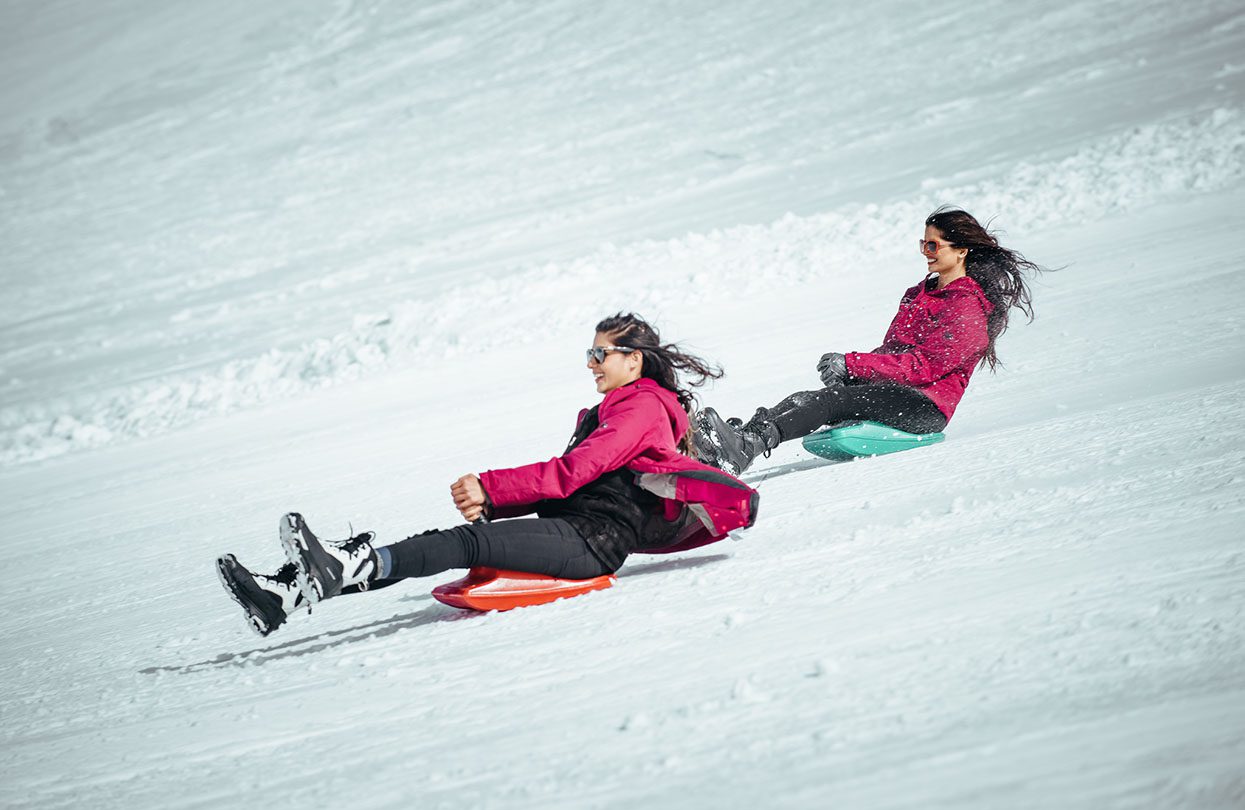
Titlis Glacier Park, image by Switzerland Tourism
Summertime in the Swiss Alps is all about outdoor adventure and enjoying the natural beauty of this pristine part of the world. At Mt Titlis, you can enjoy a range of activities, from ziplining to snow tubing, with plenty of majestic mountains and sparkling lakes in between. So soak up the fresh air and stunning scenery while getting your heart rate up this summer – just be sure to leave time for a leisurely stroll through charming Engelberg as well. 
Subscribe to the latest edition now by clicking here.
© This article was first published online in July 2022 – World Travel Magazine.
The post Savour The Swiss Alps This Summer At Mt Titlis first appeared on World Travel Magazine.
]]>The post Bike, Hike And Explore Your Way Through An Unforgettable Summer Holiday In The Vaud Region first appeared on World Travel Magazine.
]]>Summer in Vaud Region, Switzerland. An immense canton in terms of population and size, Vaud is a visual treat, one replete with dramatic, quintessentially Swiss terrain — the Alps, the Swiss Plateau, and the Jura Mountains. With France on its western border, Vaud is one of only four cantons where French is the official language. It is also a land where summer activity is firmly focused on the outdoors.
Glacier 3000, summer fun in sunshine and snow
Few places in the world promise winter activities all year round, but such is the lure of Glacier 3000, a destination blessed with sunshine and snow, and clearly designed with fun in mind, hence the multitude of options offered to visitors.
This polar paradise of powder is located at the highest point of the Vaudois Alps, rising to an elevation just above 3,000 metres, anchored by a futuristic building that was designed by the Swiss architect Mario Botta and that comes with inspirational views of the surrounding mountains, including the Eiger, Jungfrau and Matterhorn.
Perhaps the most eye-catching part of a visit here is the Peak Walk by Tissot, the only suspension bridge in the world that connects two mountain tops. The bridge measures 107 metres long and 80 centimetres wide, and links the peaks of View Point and Scex Rouge; it is free of charge, open all year-round, and standing on it, feeling as free a bird, adventurers will drink in stirring Alpine views in every direction.
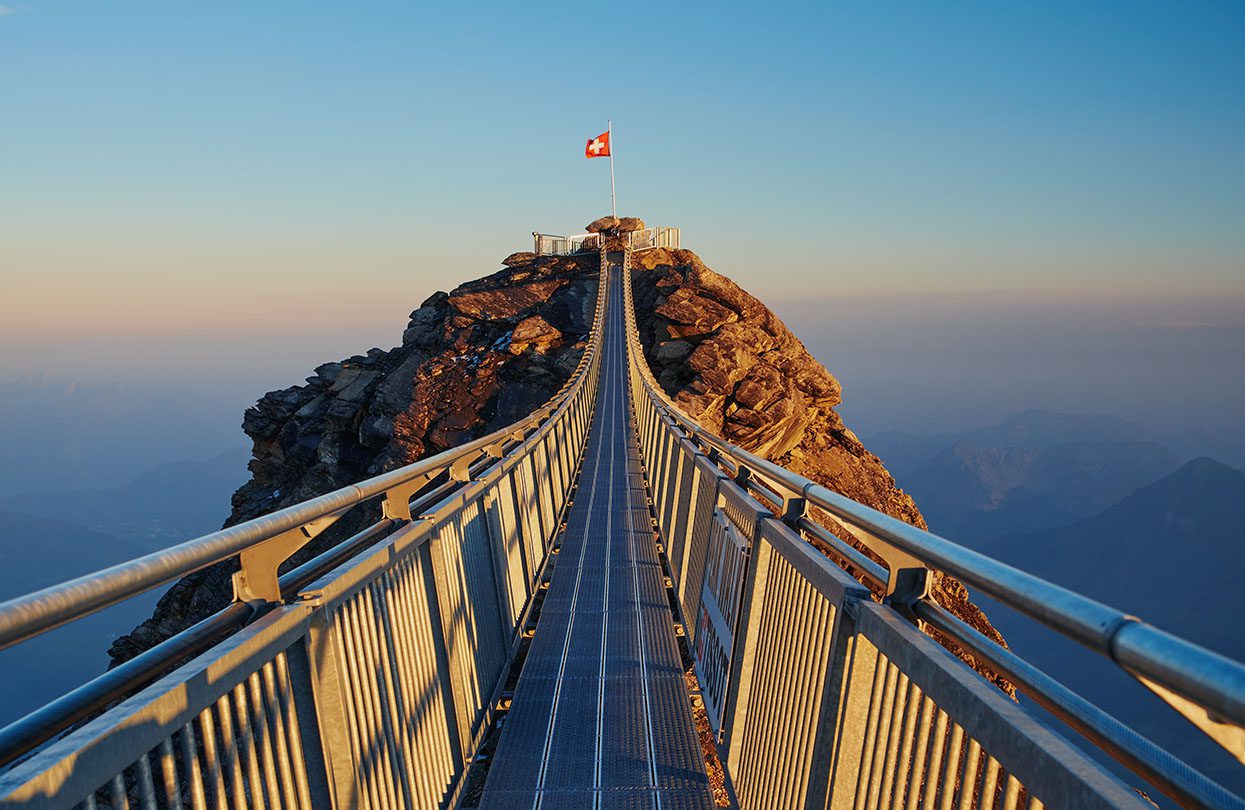
Peak Walk by Tissot, image by Visualps.ch
The Ice Cathedral is a seasonal natural phenomenon, a cave that forms when spring and summer water that fills the cave drains in the autumn to produce a 20-metre cavern with ethereal ice walls that reflect light in otherworldly ways.
For families, the highlight of any visit to Glacier 3000 is often the dogsled ride, pulled by Huskies in the spectacular glacial landscapes, generating joy for young and old. More thrills are in store during the Alpine coaster, with 520-degree circle turns, ten curves, six waves and three jumps that deliver action-packed speeds of up to 40 km/h along the one-kilometre stretch. This is high adventure on the highest-situated toboggan run in the world, with moments of weightlessness and amazing vistas that will take the breath away of even the most seasoned traveller.
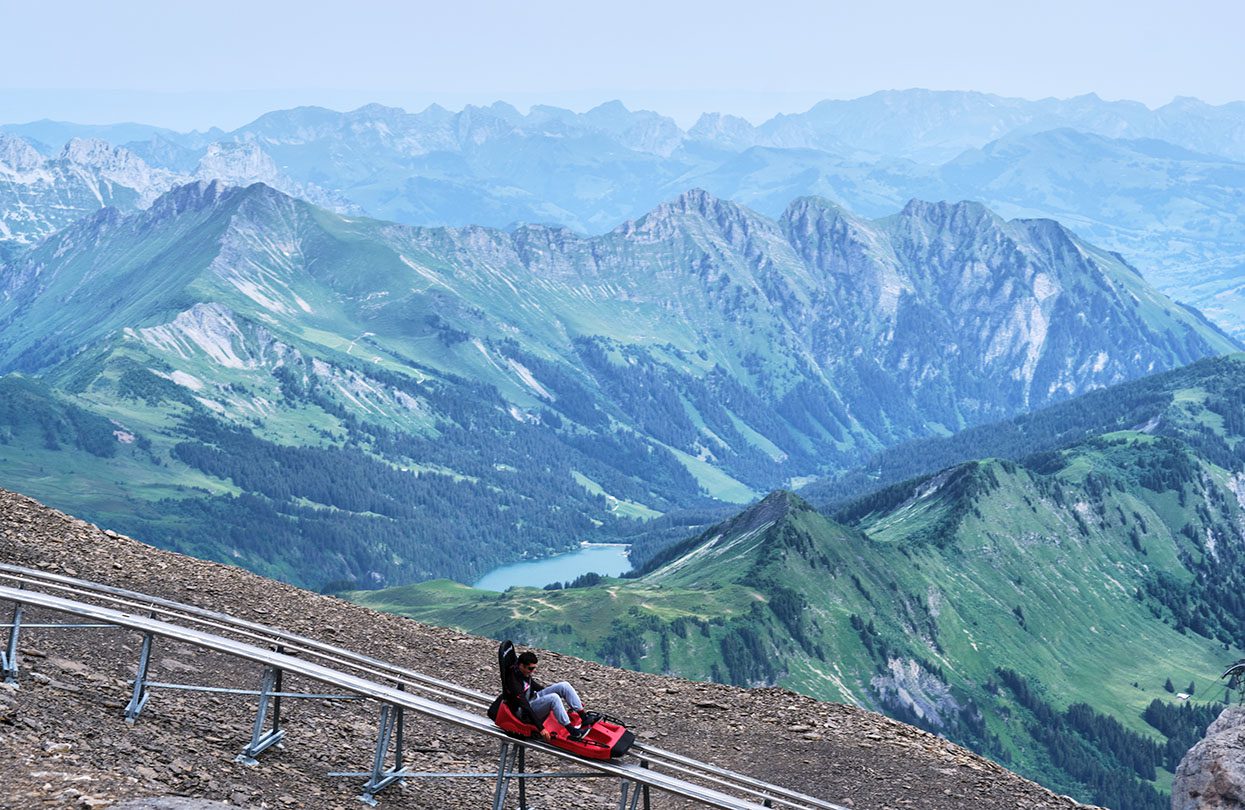
Alpine Coaster at Glacier3000, image by Visualps.ch
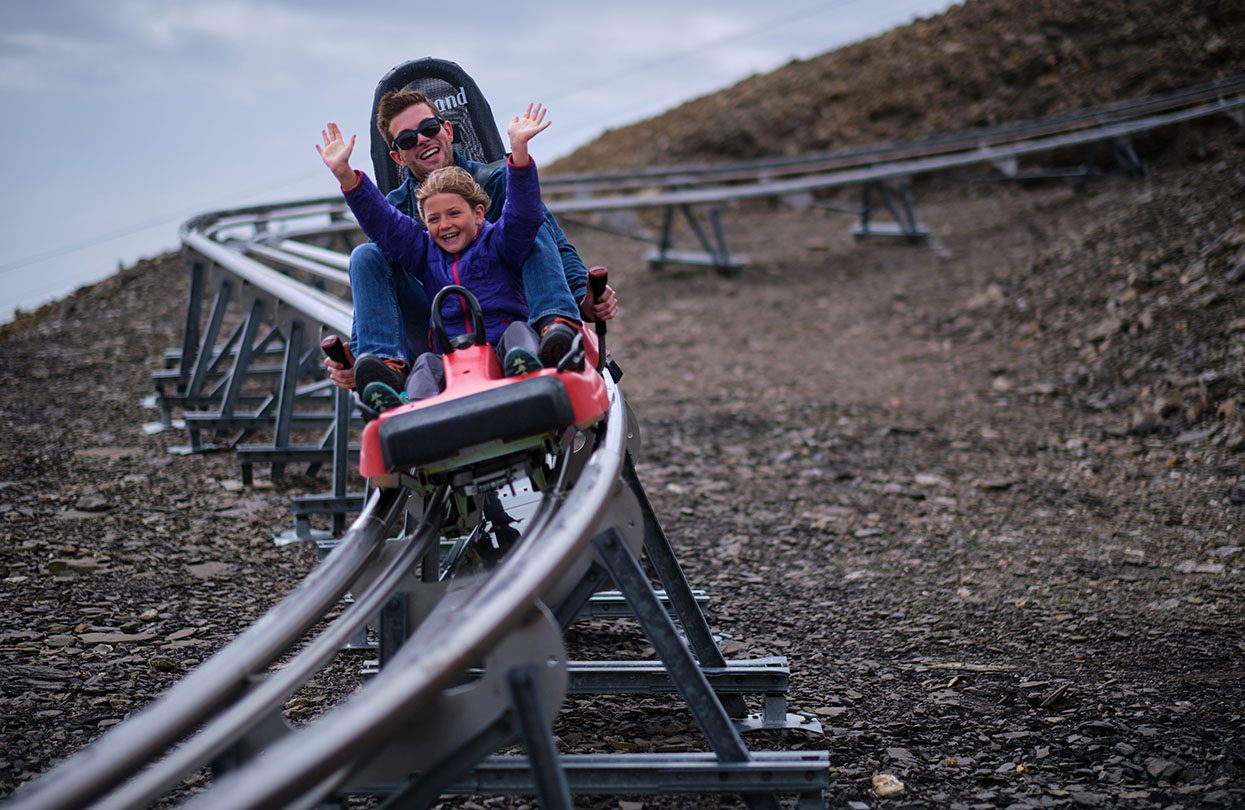
Alpine Coaster at Glacier3000, image by Visualps.ch
There are many other excursions that await at Glacier 3000, from riding in the Snow Bus (a snowcat that crunches over the crisp snow and can hold up to 20 people for forays into the glacial landscapes) to walks on the glacier, from skiing, snowboarding and cross-country skiing to taking a scenic flight above the powerful, snow-capped mountains. The obvious question at Glacier 3000 is whether the fun will ever end?
Switzerland’s cheese & chocolate trains!
Running into early summer and restarting at the end of summer, another unique opportunity presents itself in this slice of Swiss paradise. The adventure starts with the GoldenPass-MOB scenic train journey from Montreux or Zweisimmen, where the destination Château-d’Oex lies. Here visitors will uncover the secrets of making a Swiss alpine cheese: At the restaurant Le Chalet, the farmer makes one Le Chalet Bio cheese per day from 400 litres of fresh milk cooked over an open wood fire. The demonstration is performed in the traditional manner, and the rustic setting adds to the charm of the experience, with guests also enjoying a delectable fondue.
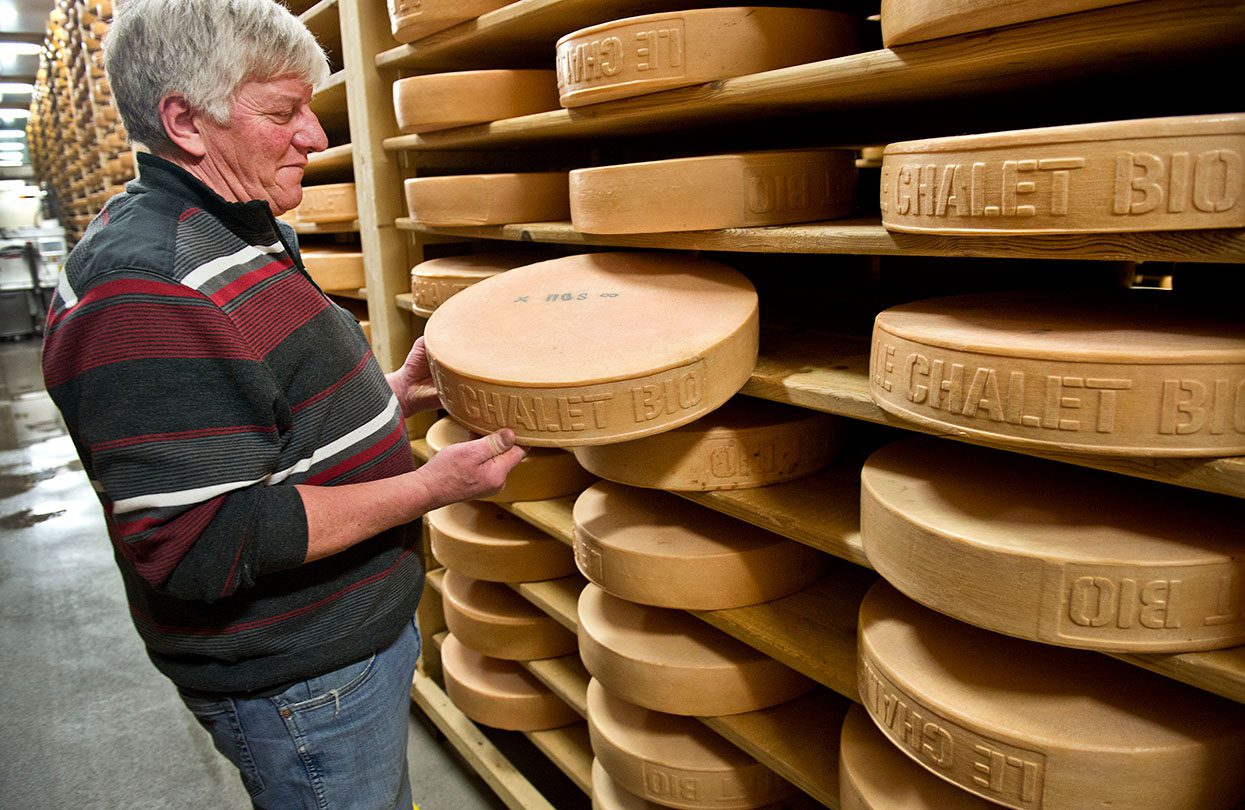
At the restaurant Le Chalet, the farmer makes one Le Chalet Bio cheese per day, image by Montreux Riviera
For a visual thrill, a GoldenPass-MOB trains miniature railway on the first floor sits above diners, and all guests receive a souvenir bag as a memento of this special excursion. Close to the restaurant, in the centre of this alpine village, the day continues at the Espace Ballon, where the exploits of balloonists are explained. The exhibition pays special attention to Brian Jones and Bertrand Piccard, who on March 1, 1999 departed from Château-d’Oex to become the first people to circumnavigate the world in a hot-air balloon without stopping, a feat that took 15 days.
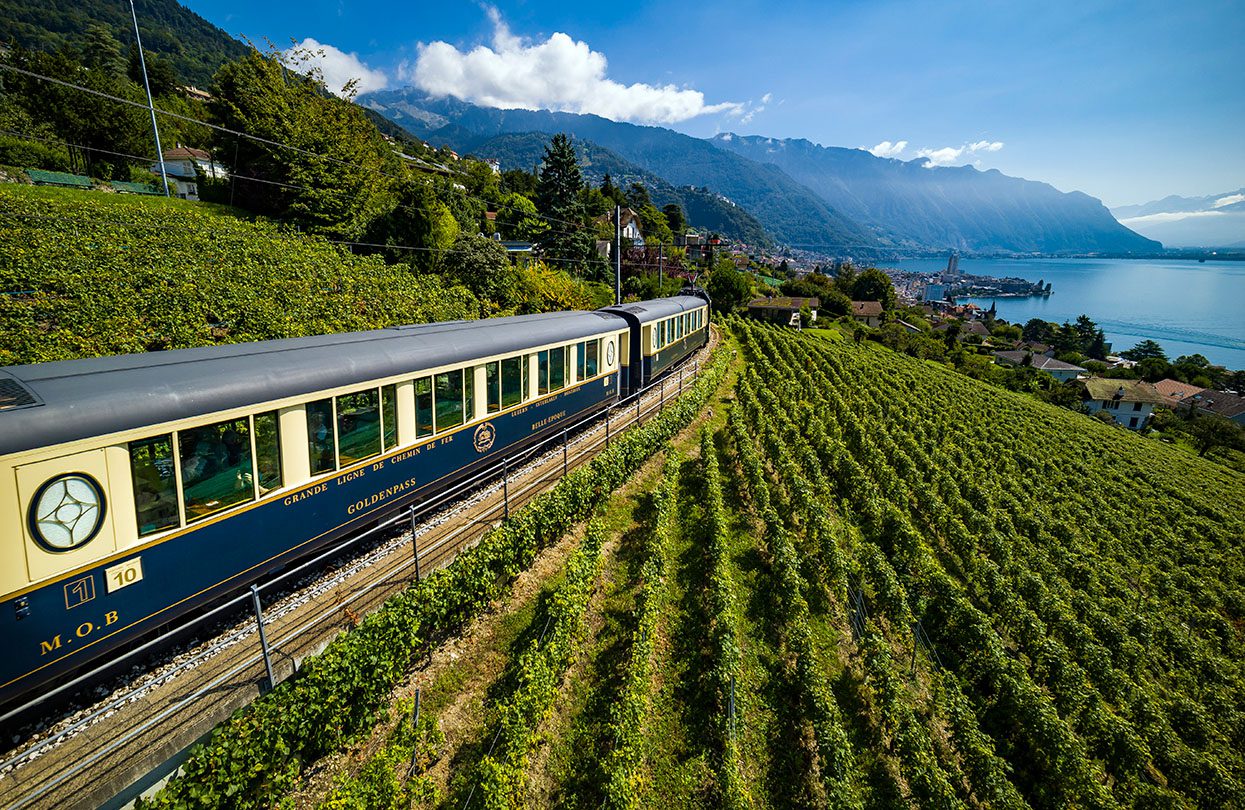
GoldenPass-MOB scenic train journey from Montreux or Zweisimmen, Image by Valentin Flauraud
Another culinary delight involves travel by train, in this case the Chocolate Train, a trip that lets travellers enjoy the stunning Vaud scenery. Running from early May to late September, this adventure begins with a train trip aboard a Belle Epoque carriage from Montreux to Montbovon, transferring to a luxury bus.
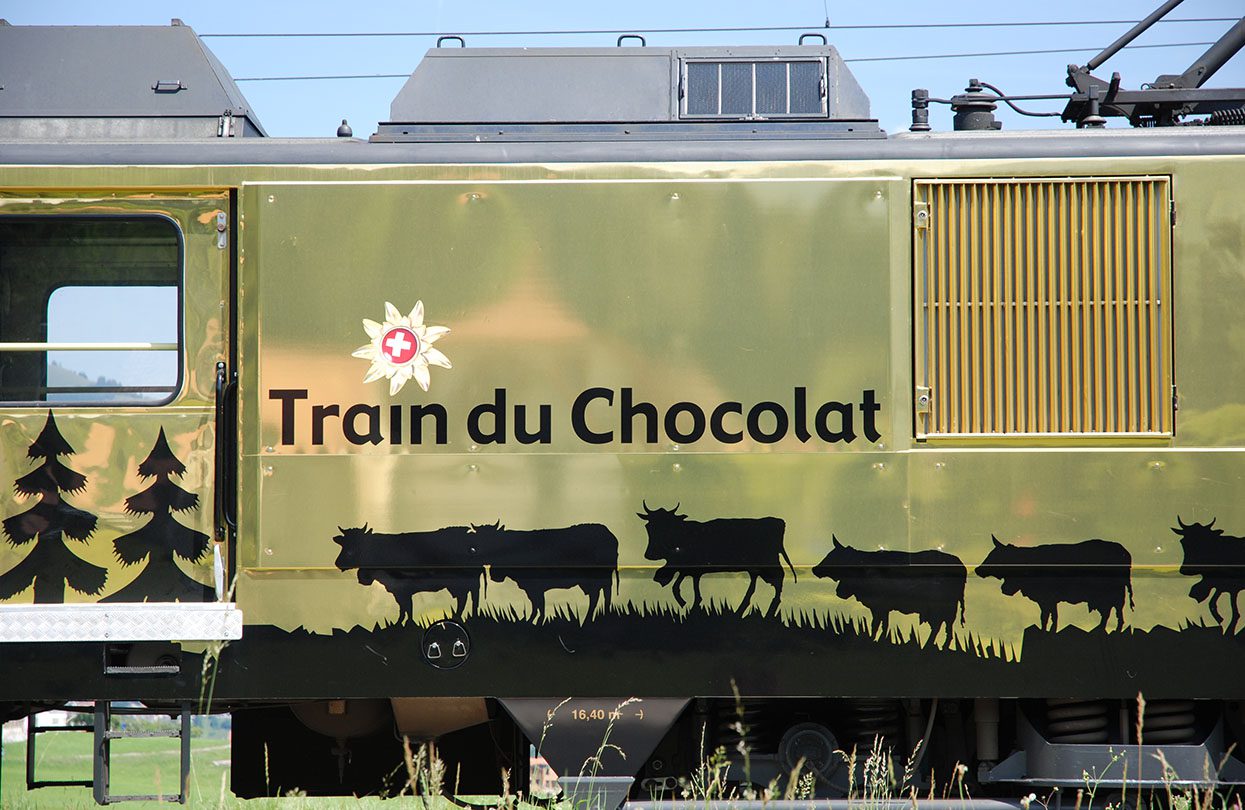
Train du Chocolat, Image by MOB
The first stop is the medieval town of Gruyères, with cobblestone streets and ancient ramparts, and for which the famous creamy, nutty cheese is named. Here, you will be able to watch how the cheese is produced at La Maison du Gruyère cheese factory before setting off to explore the village. The journey continues on to Broc, where the Maison Cailler chocolate factory is an interactive, multi-sensory exploration into the history of the intoxicating, irresistible world of chocolate. To sweeten the experience, the visit ends with a chocolate tasting.
Hike through an alpine garden at Les Rochers-de-Naye in Montreux
The scenery is the real star of another train escape to the mountain Les Rochers-de-Naye, where the 55-minute rack-train ride — a toothed rail system used for steeply inclined sections of track — promises jaw-dropping views across the Alps and Lake Geneva as it departs from Montreux.
The mountains top out at 2,000 metres above sea level, and while they are primed for skiing and winter sports in the colder seasons, summer makes them a perfect location for hiking and exploration. A natural attraction at Les Rochers-de-Naye is La Rambertia, a striking alpine garden filled with mountain plants. Here, wanderers will encounter 1,000 alpine species including two types of the Swiss mountain flower Edelweiss and 600 other local varieties.

Hiking at Les Rochers-de-Naye Image by Grégoire Chappuis
For those that want to venture further, the Via Alpina is an iconic Swiss long-distance hiking route with 20 daily stages through the Alps of northern Switzerland, and highlights that include 14 Alpine passes, a wide range of alpine culture, flora and fauna, and countless postcard-worthy views.
Bike rides through undulating landscapes, vertiginous mountain passes, rolling vineyards, and verdant countrysides when in the Vaud region
To get the heart pumping even faster, take to two wheels. Vaud boasts a variety of landscapes to suit cyclists of any level, with rides taking in undulating landscapes, calming lakes, vertiginous mountain passes, rolling vineyards, and verdant countrysides. Vaud is a preferred region for SwitzerlandMobility, an app that helps to coordinate outdoor activity with public transport options, and most sports shops in the region offer e-bikes for hire, making wheeled adventures available to all.
Bike routes start at the 11-kilometre Lac de Mayen route that loops along forest paths and across meadows, past refreshment stalls that sell home-made tarts and spots by the lake where marmots and ibex live. The ultimate feat is the 665-kilometre Alpine Bike 001 trip, and there is no better way to experience the country’s beauty than biking through the Alps on this technically challenging 16-day journey that will test your fitness as it traverses old Roman trails, forest and alpine roads, high-mountain passes, remote valleys, and unsurfaced roads where the sound of cowbells and scent of hay and meadow flowers are your companions.
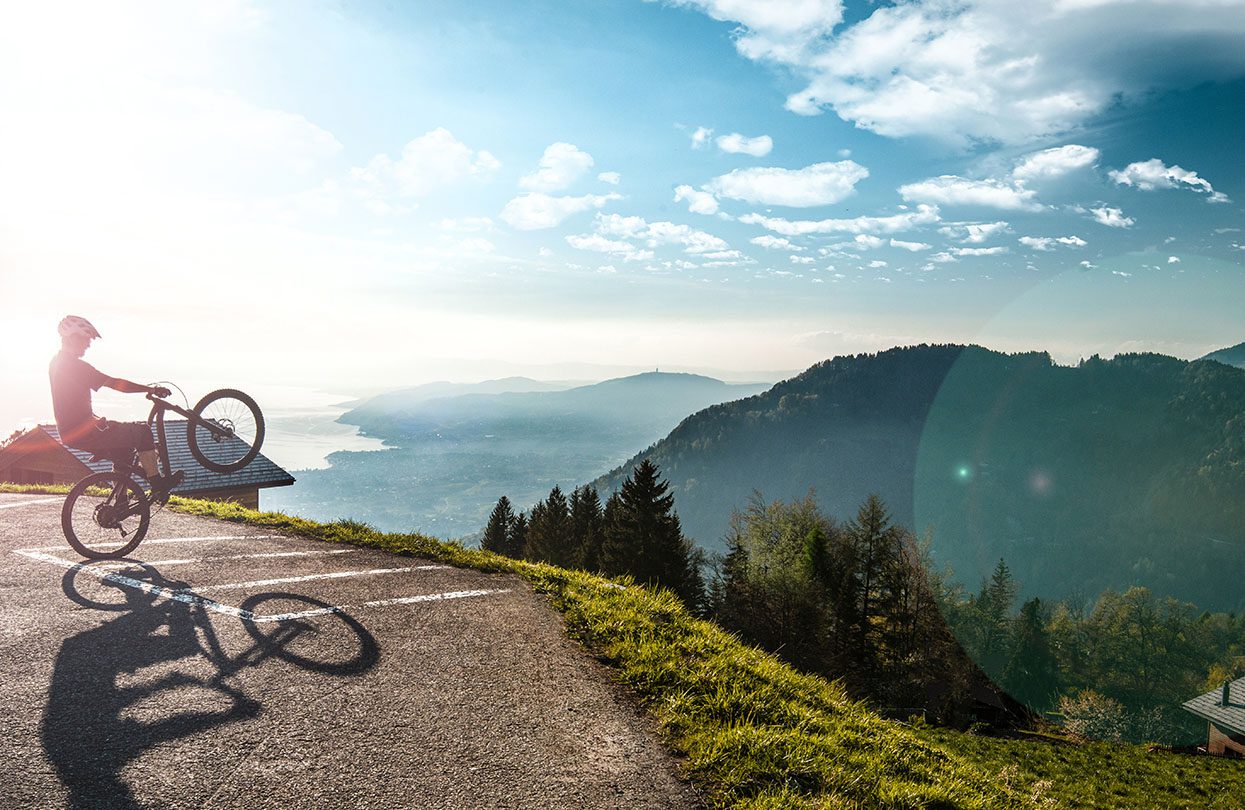
Bike tour in the Vaud region, Image by Maude Rion
A shorter option is Le Classique, a 66-kilometre circuit with two mountain passes, the Pillon and Mosses, and breathtaking landscapes. Starting in the villages of the Pays-d’Enhaut, the tour passes through the Gruyère-Pays-d’Enhaut Regional Nature Park, with peaks over 2,000 metres to the right and left. From the village of Les Granges, the craggy peak of Gummfluh comes into view, while at Rougemont the landmark is the 2,285 metre Rübli.
For a break from the ride, visitors can wander the streets of Rougement, with its centuries-old chalets and spectacular church and monastery built by the monks of Cluny. The ride continues on through the Saanenland in the canton of Bern, through the villages of Saanen, Gstaad, Feutersoey, and Gsteig before returning to Vaud. From here, the only way is up, with an ascent through forest to the summit of Pillon (the starting point of the Glacier 3000 cable car), a refreshingly cool stop in summer. The descent from the summit of 1540 metres leads to the village of Les Diablerets and then up to the second pass, to the Col des Mosses with a 400m climb. As the end of the trip nears, stop at the village of Etivaz, a hamlet where the famous alpine cheese L’Etivaz AOP is made.
Mountain bikers will find their nirvana at the Downhill Bikepark, which features a descent from the foot of Tour d’Aï to the village of Leysin, a 700-metre drop with bends and ramp jumps. Different tracks come with differing scalabilities, and the natural makeup of Leysin’s mountain terrain allows it to be tackled in multiple disciplines — cross-country, descent, enduro and dirt biking — that are all guaranteed to get the adrenalin going.
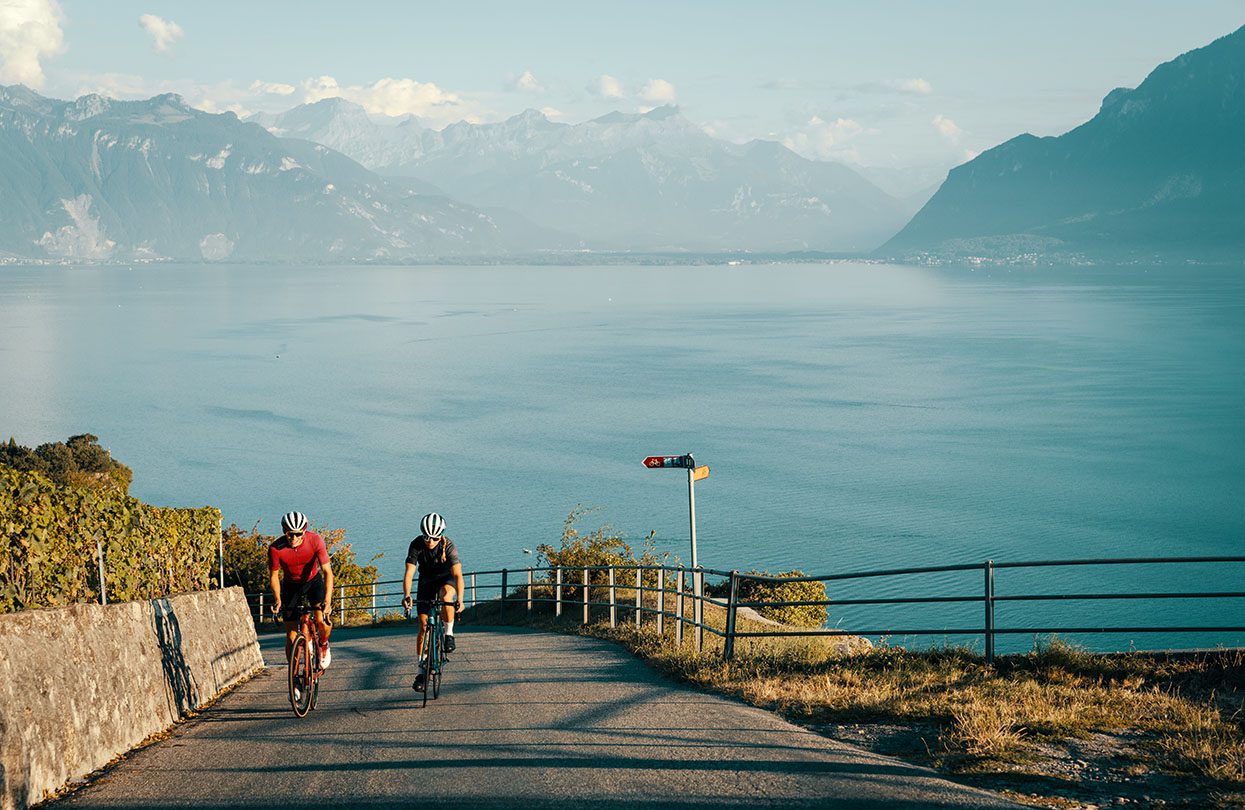
Bike ride in Lavaux, Image by Switzerland Tourism
More calming is the e-bike fun in Lavaux, an 830-hectare swathe of terraced vineyards that unfurl for 30 kilometres along Lake Geneva. This bucolic, serene e-bike tour is led by a certified Lavaux World Heritage guide, and the package comes with the rental of an e-bike, helmet, safety vest and lockers, the services of the guide, and a rousing finale with a bottle of Chasselas wine served in flutes. Add-ons include a gourmet picnic basket in the heart of the vineyards and the tasting of local wines accompanied by local cheese, bread, and charcuterie.
And at the end of it all, when travellers need some well-deserved down time, they can stay at a resort synonymous with relaxation and vitality. The Grand Hotel des Bains is linked to renowned spa of Yverdon-les-Bains by a glass tunnel, and a sense of well-being has prevailed here since the eighteenth century, with access to the hot springs, four pools, jacuzzis, and Turkish baths. The architecture reflects the Belle Epoque style, with a striking rotunda that dates to 1896 and 115 elegant rooms that are as breathtaking as Vaud’s resplendent outdoors. 
Subscribe to the latest edition now by clicking here.
© This article was first published online in July 2022 – World Travel Magazine.
The post Bike, Hike And Explore Your Way Through An Unforgettable Summer Holiday In The Vaud Region first appeared on World Travel Magazine.
]]>The post Outdoor Sports, Mountain Climbing And Bond World At Schilthorn first appeared on World Travel Magazine.
]]>A towering presence in southwestern Switzerland’s Bernese Alps, Schilthorn is the highest mountain in the range north of the Seifnenfurgge Pass. This is a peak of imposing grandeur, one that dishes out up panoramic views of supreme summits like the Eiger, Jungfrau, Mönch, and Titlis, vistas across the Bernese Alps and Jura mountains up to the Vosges range, and on a clear day onto Germany’s Black Forest and Mont Blanc, the iconic mountain that straddles France and Italy.
Accessed most easily by cable car, Schilthorn can also be reached by intrepid explorers on foot, via well-marked hiking paths that climb from the town of Gimmelwald, a trip that takes about five hours. Schilthorn is also the site, since 1928, of the Inferno, the world’s longest downhill ski race that is a gruelling mix of slick downhill runs and testing uphill terrain, an ultimate challenge for the amateur skiers from across the globe that descend here each year to compete.
What is clear is that this part of Switzerland is primed for outdoor sporting activity, blessed with majestic terrain — lakes, rivers, waterfalls, forest, cliffs, and mountains — that is served by outstanding infrastructure, making getting around effortless.
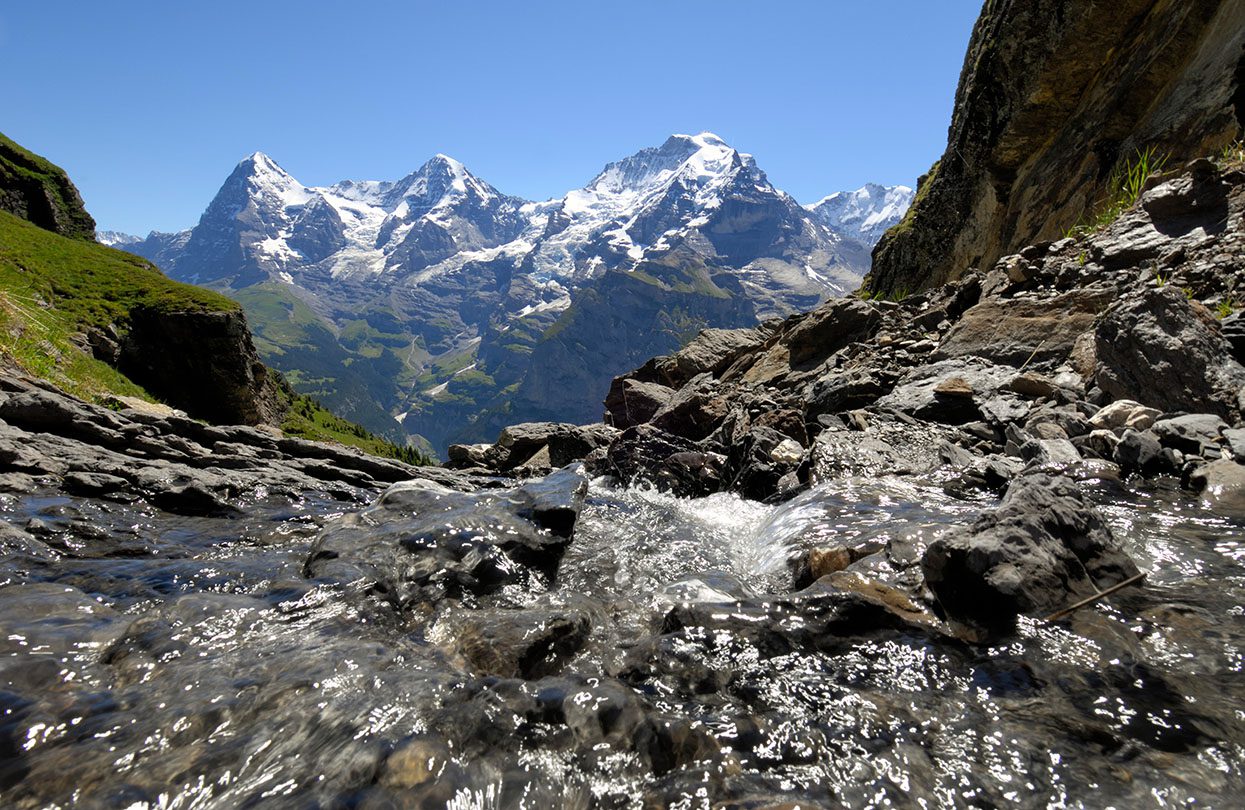
Inspiring views of waterfalls and mountains, coupled with fresh alpine air when in Switzerland, image by Schilthorn Tourism
The easiest route to the mountain is via train, bus and cable car, starting at Interlaken Ost station, transferring to a bus that ascends to Stechelberg, a village at the base of Schwarzmönch (meaning black monk) mountain, and finally the cable car ride up to Schilthorn; holders of the Swiss Travel Pass enjoy a sizeable discount on the cable-car tickets, a bonus of the pass. The 32-minute cable-car ascent supplies a bird’s-eye view that handsomely illustrates the magnificence of the Alps, with stops en-route at the charming highland towns of Gimmelwald and Mürren, the 2,684-metre peak of Birg, and views across the Lauterbrunnen valley.
Hiking & Trail Running between Schilthorn and Mürren
A simple option for travellers in search of some exertion — and one that requires no equipment save for a comfortable pair of shoes, and is suitable for visitors of all fitness levels — is the hiking and running around Schilthorn, a peak that tops out at 2,970 metres above sea level.
There are scores of routes between Schilthorn and Mürren, with inspiring views of waterfalls, lakes, mountains, coupled with fresh alpine air and small, welcoming restaurants where travellers can take a break and enjoy a drink or snack or meal.
A quick introduction, perfect for walkers of all ages, is the Flower Trail, which circles Allmendhubel (a small hill above Mürren) in around 20 minutes. Popular with parents who have young children because of its wide path suitable for strollers, it’s an excursion that allows visitors to observe up to 150 different mountain flowers as well as herbs and views of meadows. The circular trail starts at the panorama restaurant on Allmendhubel and is an extension of the Flower Park adventure playground, making it an easy diversion from play time with the youngsters.
Starting at Mürren station, the Blumental Panorama Trail takes a little over an hour, and presents adventurers with quintessential Swiss pastoral landscapes. Winding its way from Blumental to Allmendhubel (or in the reverse direction, which is a marginally easier walk), the route takes in the serenity of cattle grazing in alpine meadows. A relatively easy tramp, the journey from Birg to Grauseeli and back to Birg stops at Grauseeli, an alpine lake whose placid surface mirrors the mountains around it, supplying beautiful photo opportunities of natural landscapes at their unspoilt best — still water, verdant shores, and jagged peaks reflected on the glass-like lake surface.
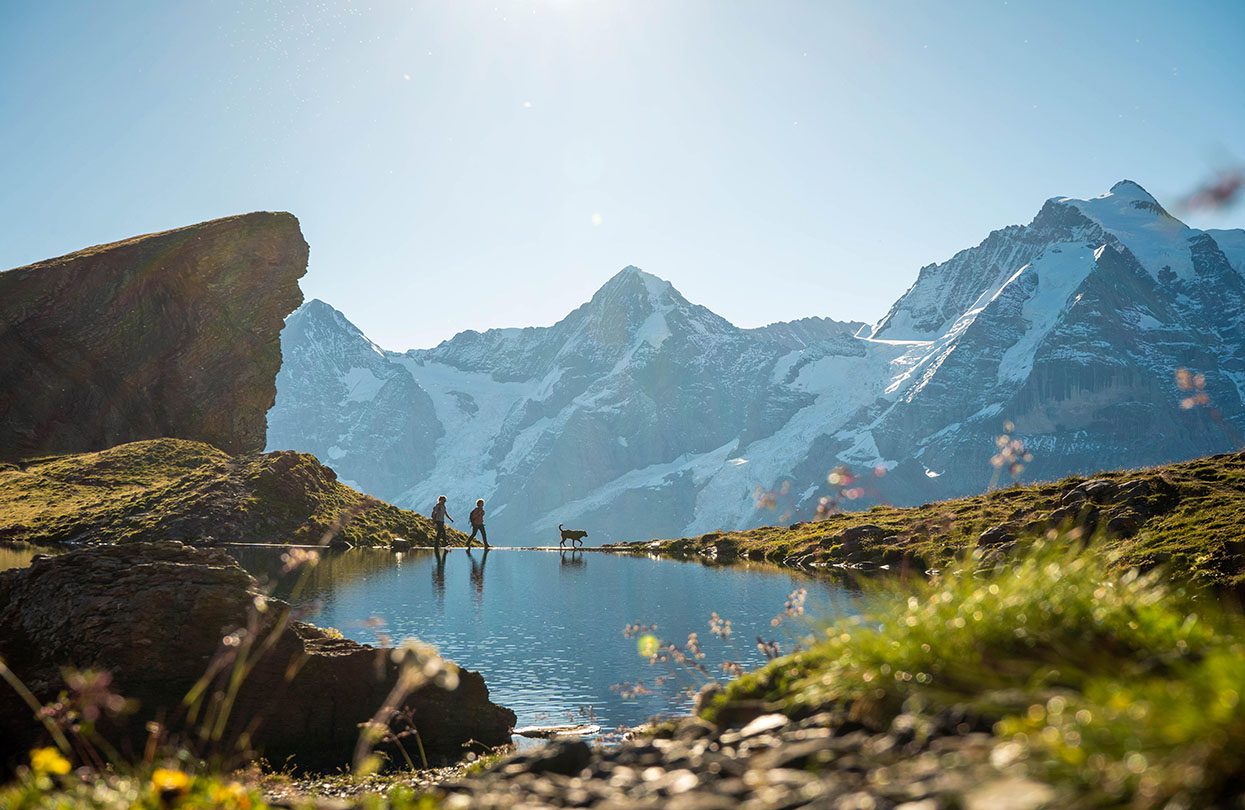
Grauseeli, an alpine lake whose placid surface mirrors the mountains around it, image by Schilthorn Tourism
For a little more arduous tramping, the mountain has a number of trails that are good for intermediate walkers, trips that take between two to three hours. The Northface Trail, a well-posted route, is notable for its breathtaking views of the north faces of the Bernese Alps, often snow-capped because of their directional exposure.
Along the trail, 12 information panels document the history of the mountains. The Mountain View Trail weaves through alpine meadows and through dense forests as it journeys from Allmendhubel to Grütschalp. Expect regular views of the Eiger, Mönch and Jungfrau peaks during this spectacular trip.
For those up for the challenge, a couple of routes will get the heart pumping and legs working even harder. The summit ascent from Birg involves 350 metres of vertical ascent during a trail that takes less than two hours; the exertion is worth the sublime Alpine panoramas.
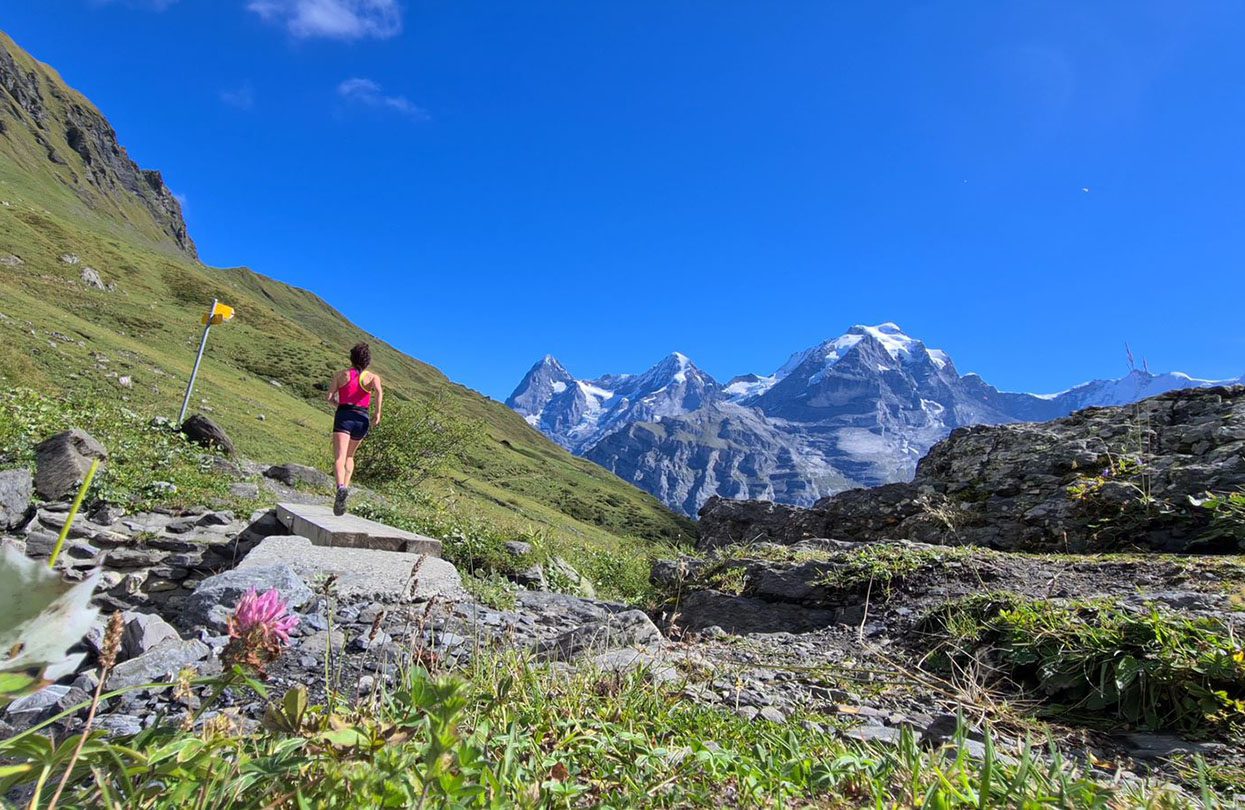
Trail running in across Grimmelwald, image by Schilthorn Tourism
The most demanding hike is the eight-hour marathon from Gimmelwald to Stechelberg via Tanzboden and Oberhornsee. Squarely aimed at experienced hikers, this long trek promises unforgettable views, including those at Oberhornsee, a turquoise Alpine lake cradled by mountain peaks that embodies the archetype of Swiss mountain landscapes.
Adrenalin rush at Via Ferrata
For more outdoor thrills, an adventure on a via ferrata is not to be missed, an adrenalin rush like no other. Via ferrata is an Italian term, meaning ‘iron way’ or ‘way of iron’, and typically lead upwards, climbing from lower to higher elevations. Here, at Schilthorn, the trip is all downhill. The iteration here begins high in the Lauterbrunnen Valley, at Mürren, 1,640 metres above sea level, and the trip usually lasts around three hours, a walk that is best described as a hybrid between mountain walking and free, normal walking.
Here, while traversing a combination of iron rungs attached to the rock face, suspension bridges, and ladders, participants descend 400 metres vertically between Mürren and Gimmelwald on a route that is 2.2 kilometres in length, and includes the Nepal Bridge that is 80 metres long (suspended over a chasm that is 300 metres deep!).
Safety is a key aspect of the course, with adventurers locked in via ropes and carabiners as they tackle the course and marvel at the views of the 4,000-metre high Bernese Alps. While this can be completed alone for climbers with experience, first-timers and novices should not hesitate to book a guide for this adventure.
The route, classed as K3, includes steep, rocky terrain, ladders, metal rungs, and even in the easier parts of the route, climbers are assisted by cables. Climbers are kitted out with climber belts, a helmet, and a dedicated climbing set designed specifically for via ferratas.

The via ferratas going down from Mürren and Gimmelwald, image by Schilthorn Tourism
To get a deeper understanding, and appreciation, of the tectonics that shaped this region, visit the Trümmelbach waterfalls: Ten glacial waterways — including those of the Eiger, Jungfrau and Mönch — drain internally to create a waterfall that processes 20,000 litres of water per second. It’s an eye-opening spectacle, and a loud one, with the roar of the water deafening.
At times the falls, that appear over numerous levels, resemble an underground river. Access to the site is via tunnels, stairs or a lift and summer is the ideal time to visit, after the winter snow pack has melted, feeding the thundering cascades.
Piz Gloria, the 360° panorama restaurant and Bond World
During down time, the mountain provides diversions to keep visitors entertained. The peak itself was a key shooting location for a James Bond film in the late 1960s. On Her Majesty’s Secret Service used the peak’s revolving restaurant with a conical silver exterior and 360-degree views as the setting for an allergy research clinic run by Bond’s arch foe, Ernst Blofeld.
In the film, the clinic was called Piz Gloria, a name that the restaurant decided to retain, and today this elevated eatery thrills visitors with a 45-minute complete rotation that takes in 200 alpine peaks including Eiger, Mönch and Jungfrau. Fine food accompanies the sublime views, with themed choices like 007 Burgers and the James Bond Brunch (an all-you-can-eat meal that is served daily until 2pm) in addition to international options and regional favourites like Zürich-style sliced veal, and meat and cheese platters.
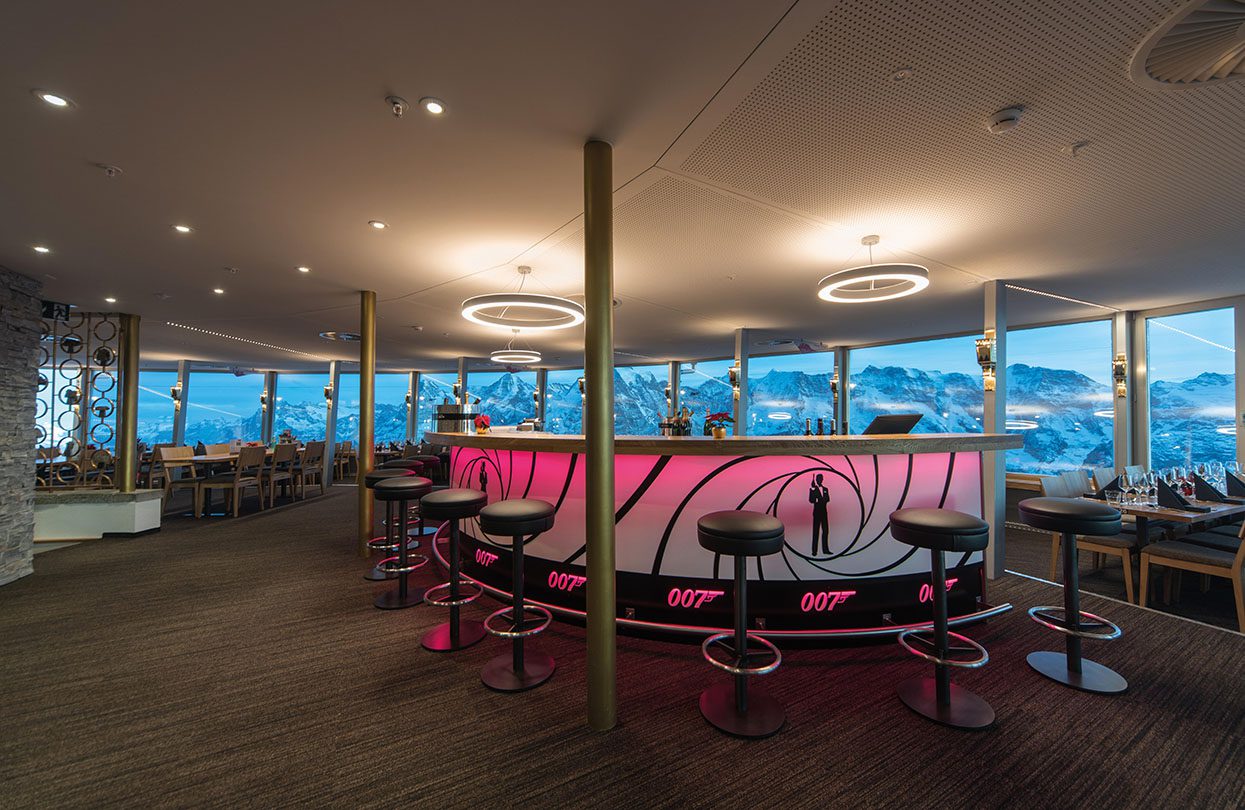
Piz Gloria, the 360-degree restaurant, image by Schilthorn Tourism
Almost half a century after the filming finished, a space below the dining room was reconfigured into Bond World, an interactive exhibition dedicated to the movie that acts as a window onto the life of the beloved British secret agent and his adventures on and around Schilthorn.
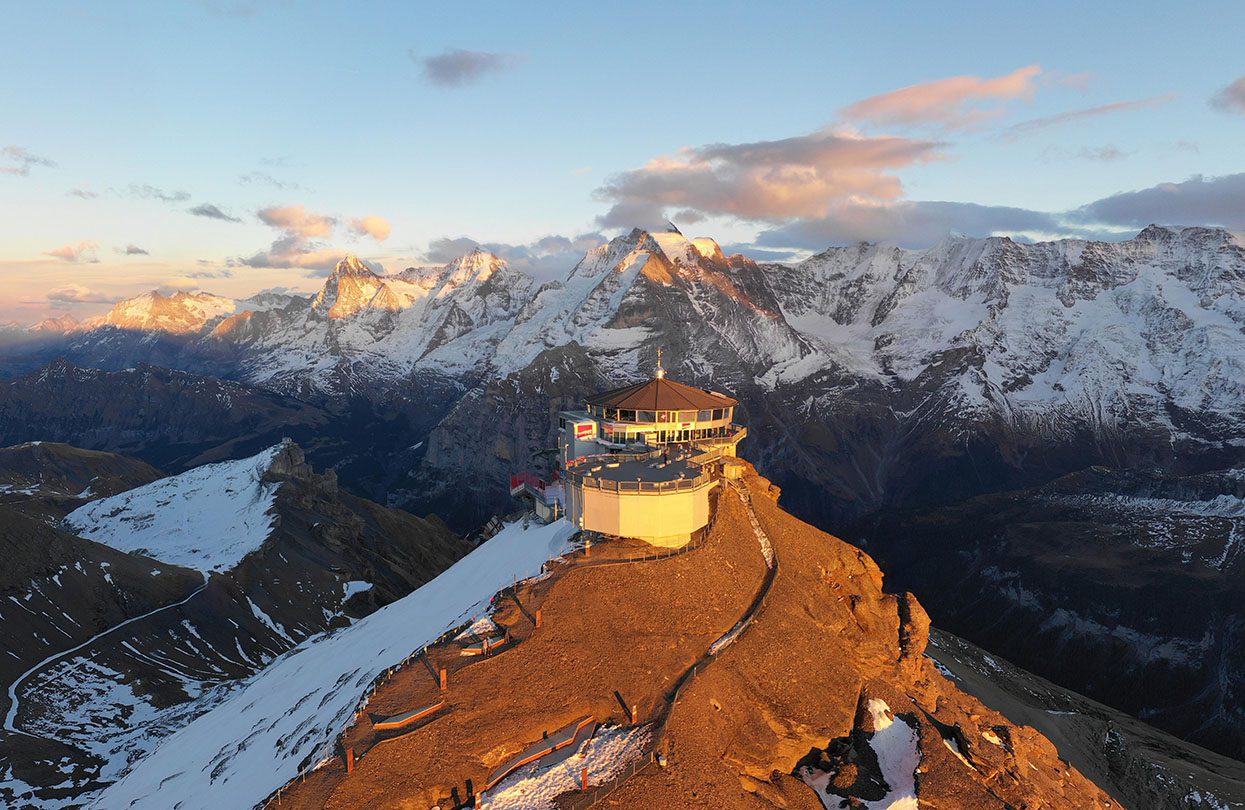
Piz Gloria, at the top of Schilthorn, image by Schilthorn Tourism
With free admission, it features seven key scenes and an encyclopaedia of film-related trivia, and allows visitors to get a glimpse of the original screenplay, try out their own James Bond skills with a frantic bobsleigh ride, or take a helicopter simulator flight in the original chassis of a decommissioned Air Glaciers Alouette III.
Next door, the Bond Cinema offers a relaxing interlude after the bustle and energy of Bond World. The cinema’s wow-inducing, 12-metre-wide, curved screen alternates ultra-sharp images of scenes and stunts from the James Bond classic that was filmed here with sensational aerial footage of the magnificent mountain world right at Schilthorn’s doorstep.
And on a ridge just outside Piz Gloria, the world’s first Walk of Fame comprises 15 information panels that pay tribute to the cast and behind-the-scenes contributors of On Her Majesty’s Secret Service, a celebration of a time in a place steeped in natural awe and wonder.
Schilthorn is the perfect place for those who love the outdoors. Visitors can enjoy hiking and trail running between Schilthorn and Mürren, or experience an adrenalin rush at Via Ferrata. Those looking for a more relaxing activity can visit Piz Gloria, the 360° panorama restaurant with Bond World. With its commanding aura and connected seamlessly to great public transportation, Schilthorn provides visitors numerous opportunities for outdoor activity.
Everything you need to know to visit Schilthorn, Piz Gloria, Bond World and Allmendhubel
Where can I stay when visiting Schilthorn
It’s possible for anyone to choose between many different accommodation options when visiting the Schilthorn region. It is easier to get to Schilthorn from Mürren, the touristic centre would be Interlaken, or you can stay in nearby towns like Wengen or Grindelwald. Some of the hotels here include:
Mürren – Eiger Mürren Swiss Quality Hotel, Hotel Alpenruh and Hotel Blumental
Interlaken – Victoria Jungfrau Grand Hotel & Spa, Hotel Royal St Georges Interlaken MGallery Hotel Collection*, Lindner Grand Hotel Beau Rivage and Carlton-Europe Hotel Vintage Adults Hotel.
Grindelwald – Romantik Hotel Schweizerhof, Aspen Alpine Lifestyle Hotel, Boutique Hotel & Restaurant Glacier, and Hotel Bergwelt Grindelwald.
Wengen – Beausite Park Hotel Wengen
Merligen – BEATUS Wellness & Spa Hotel
View Schilthorn Livecam
Schilthorn’s livecam offers breathtaking views of the Swiss Alps, and it’s the perfect way to check out the destination virtually before your journey even starts.
Whether you’re looking for a winter wonderland or a summer paradise, Schilthorn has something for everyone. So why not take a break from your busy life and enjoy the simple things in life? Schilthorn is waiting for you. 
Subscribe to the latest edition now by clicking here.
© This article was first published online in July 2022 – World Travel Magazine.
The post Outdoor Sports, Mountain Climbing And Bond World At Schilthorn first appeared on World Travel Magazine.
]]>The post A Canton Of Contrasts: Experience The Best Of Switzerland In Valais first appeared on World Travel Magazine.
]]>Located in the southwest of Switzerland, and bordering France to the west and Italy to the south, the canton of Valais is notable for its variety. For starters, it is one of only three of the nation’s 26 cantons that is bilingual, with French and German as its official languages. The scenery equally reflects that sense of diversity, with grand mountain ranges that receive plenty of rain and snow — including the iconic, pyramid-shaped peak of the Matterhorn — and dry valleys along the central Rhône that produce wine. What is common throughout the canton is the vast array of options for those that enjoy being outdoors.
Hiking at Aletsch Glacier
Hiking is immensely rewarding in Valais, with a number of breathtaking routes across the region, including walks around Zermatt that come with heart-stopping vistas of meadows and the Matterhorn. The Aletsch Arena, a ski resort on the Aletsch Glacier, a UNESCO World Heritage Site, is a walk that begins with a ride up to Moosfluh viewpoint from the Gletscherbahn Moosfluh valley station. From here, the ridge leads west via Hohfluh to Villa Cassel, an imposing former hotel that is now used as a conservation centre.
Continuing on the walk, travellers will encounter five stations that demystify the glacial region, with informative, acoustic and playful presentations on the themes of Wilderness and Civilisation, the Nature Reserve and Alpine Farming, Water Shortage and Reservoirs, the Gratzug and Poor Souls (based on a local folk legend), and Nature Conservation and Tourism. A number of stunning lookout points elevate this easy trail into an extraordinary experience.
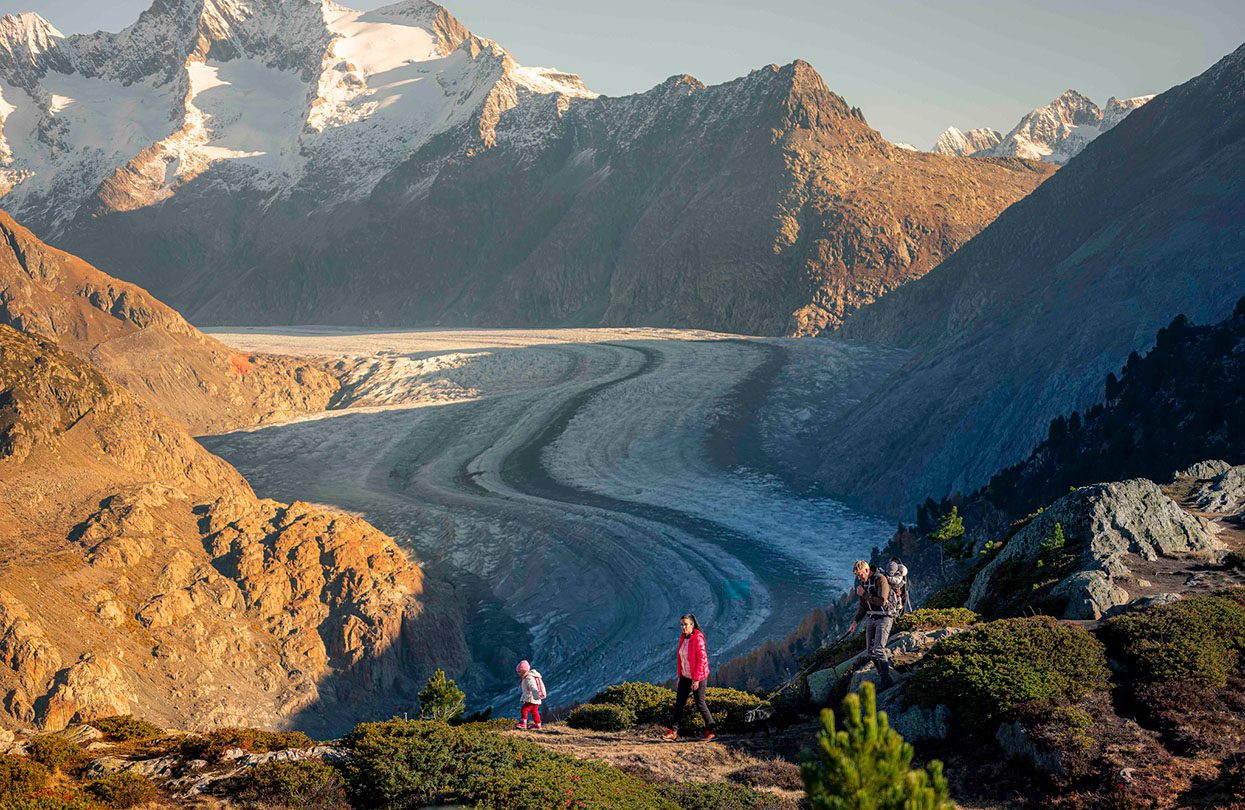
Aletsch Glacier, a UNESCO World Heritage Site, image credit Switzerland Tourism
Glacier walk at Laengfluh Glacier, Saas-Fee
Another thrilling adventure awaits on the glacier and Marmot Trail at Saas-Fee, an Alpine village in the Saas valley near the border with Italy. Here, the furry marmots wander and play in the areas of the mountain called Spieldboden and Stafelwald. During the sunny summer months, they enjoy being fed peanuts and carrots, tasty and deserved treats after a six-month winter hibernation in their caves; bags of peanuts are sold at the Saas-Fee Tourist Office and in the Spielboden restaurant.
The period from early June to late September is also the best time for a tour over the Fee Glacier. Incredible describes the walk on ridges and slopes of ice that come with views of dense, verdant forests in the valley below. The trip begins with crampons, poles and a climbing harness at Spielboden mountain station, and the ascent to the peak involves all adventurers to be secured to the mountain guide’s rope.
Crossing mammoth séracs (columns of glacial ice) and crevasses, travellers will wind their way up to the highest point on the glacial plateau, the Panoramaplatz, where the views are as far-reaching as the name suggests. The easy descent leads to the Längfluh station, to a sun terrace where guests get the chance to unwind after their glacial getaway. This trip requires no prior ice-walking experience and minimal fitness, but the rewards are exceptional.
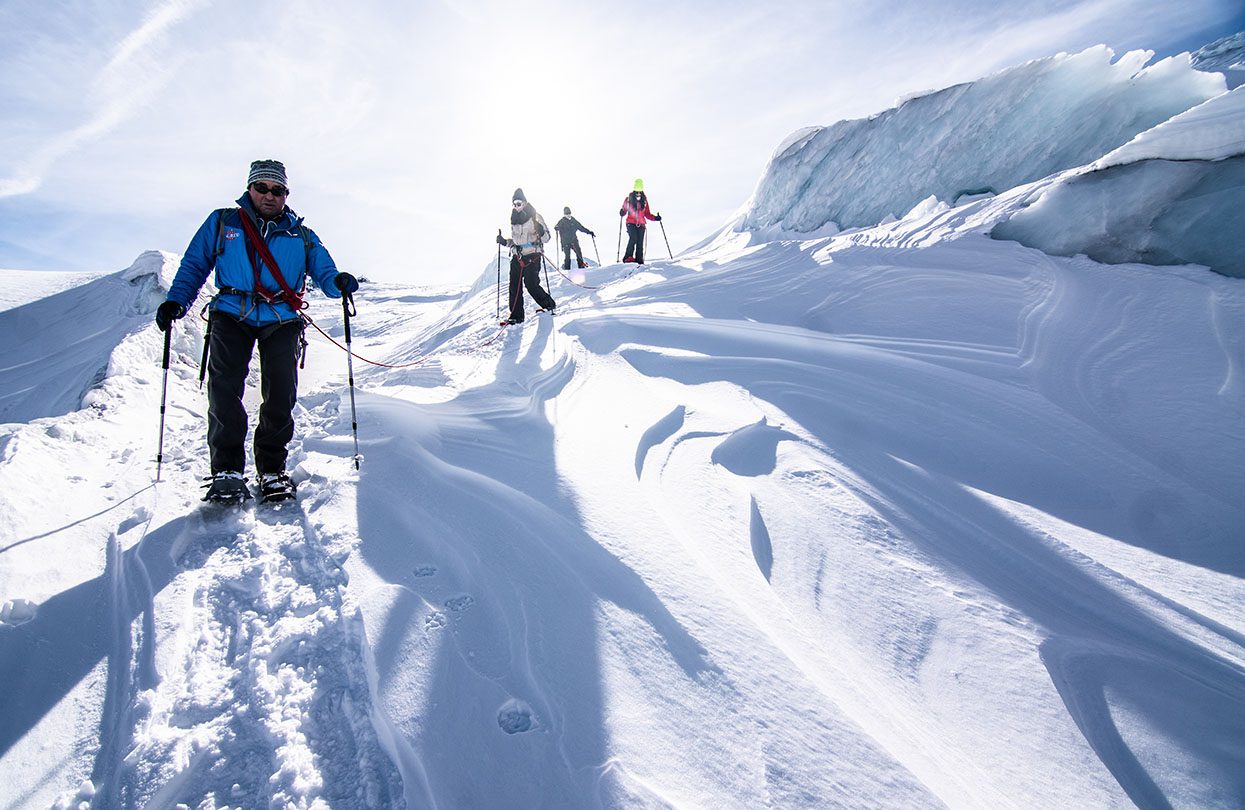
Saas-Fee Serac tour, image credit Switzerland Tourism
Thermal canyon walk in the Dala Gorge
Different terrain presents itself during the thermal canyon walk in Dala Gorge, a theme trail that devotes its attention to Leukerbad’s famous mineral water and also a spectacular walkway that hugs the sinuous lines of the Dala gorge, site of the hot springs. The themed route kicks off in the village centre, crossing Leukerbad resort with information panels highlighting the various hot springs in the resort, the medicinal properties of the thermal water, and its importance for the local economy.
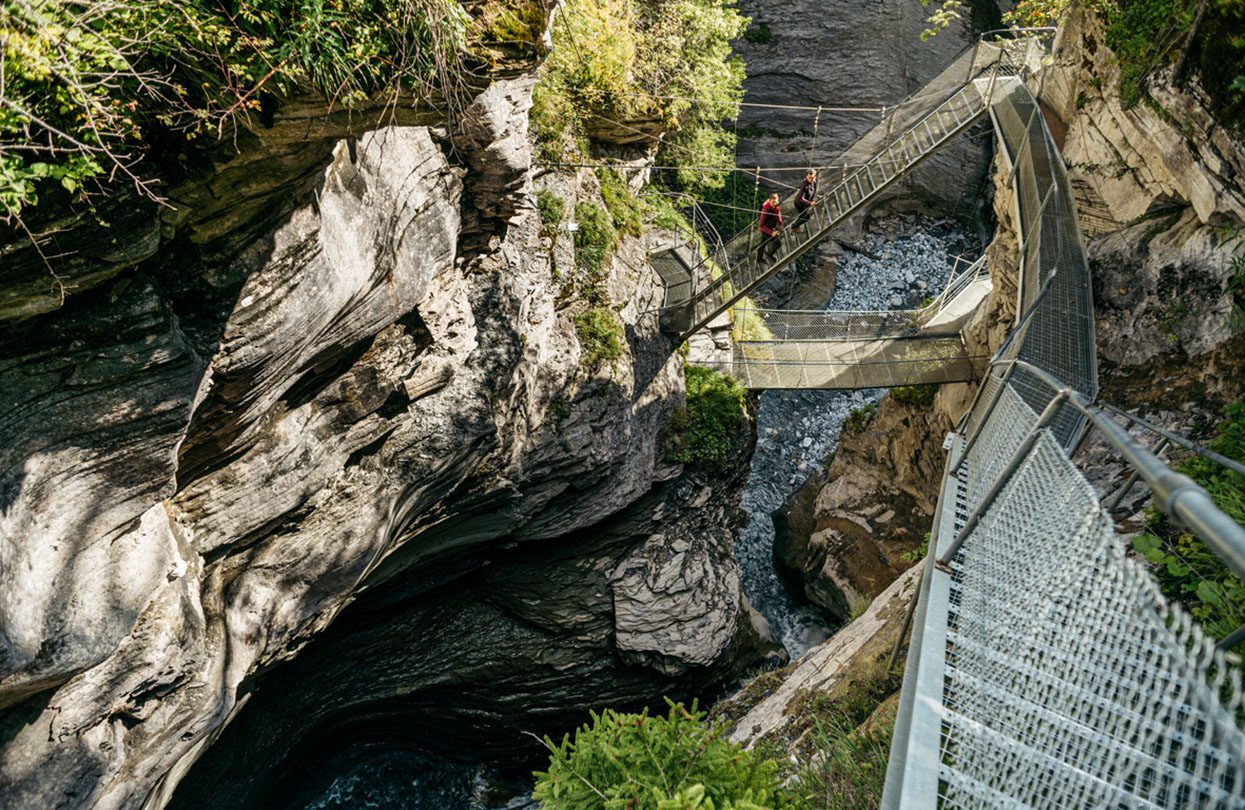
Spectacular walkway that hugs the sinuous lines of the Dala gorge, image credit Switzerland Tourism
The theme trail transforms into a canyon walk at the entrance to the Dala Gorge. This Instagram-worthy walkway, first opened in 2004, is a secured steel structure that reaches deep into the heart of the gorge, with the thermal springs bubbling up in the river bed below. Look for rust-brown streaks on the cracks and fissures of the canyon walls and by the river’s edge below, indicators of the high iron content of the mineral-laden waters.
The walkway itself is 600 metres long, leads through the gorge to a 35-metre waterfall, and is wheelchair accessible; those that want to see the source of the waterfall can climb up stairs to the crystal-clear pool above. To extend the hike, the ravine returns to Leukerbad via the northern side of the gorge and the hamlet of Buljes, with the option to continue on the lower part of the village of Leukerbad, a total length of 2.8 kilometres, that takes about 90 minutes. A visit here can be book-ended with a soak at the public baths at Leukerbad, warmed to 51 Celsius and surrounded by mountains, and lunch at the Panorama Restaurant at Gemmi Pass.
Nature trails along ‘bisses’ at Nendaz and Veysonnaz
Here in the Valais, a network of historic mountain water irrigation channels spreads across the region, some dating to the 13th century. Known as bisses, they form a web of beautiful waterside walks that weave through the countryside, sometimes high above valleys, sometimes through charming alpine villages, and sometimes affording the chance to see Alphorn blowing demonstrations.
Nendaz and Veysonnaz are two bases for wandering and getting truly up close to the gorgeous Swiss countryside on these bisses. The walks are easy, suitable for children and adults, and there are eight in the area, delivering almost 100 kilometres of footpaths. Set between 700 and 2,300 metres above sea level, they are simple, low-impact summer hikes blessed with clean alpine air.
Bisse de Salins, Bisse de Vex is a pretty loop along two bisses that offers magnificent views over the Nendaz valley and the chance to discover the lesser-known village of Clèbes. Coming in a shade under 10 kilometres, the walk takes a little more than three hours, with variation in altitude of 660 metres. A more rigorous proposition is the Bisse de Chervé, 11 kilometres in length with a change in altitude of 293 metres, and estimated time of completion of just over three hours.
A magnificent high-altitude walk that offers inspiring views of the Cleuson dam, it is accessed from the top of the Combatseline chairlift. This walk is the highest, most alpine of all bisses walks, with the entire path above 2,200 metres and filled with grandeur throughout. The turquoise waters of the Cleuson dam come into view about 45 minutes into the walk, and the same narrow path leads to a stunning view over the dam lake, gradually opening to a wider path at a location called La Gouille. From here, hikers have two options — to climb up to St-Laurent mountain cabin or descend along a track that skirts the lake before reaching the dam wall, and down further to the village of Siviez. Visitors have the opportunity to take a guided tour of the dam on Fridays during the summer, an eye-opening window to this engineering marvel.
Explore the historic Simplon Pass
The Simplon Pass connects Brig and Valais with Domodossola in Northern Italy, and has a lively past. It was used as early as the Stone Age, but because of its narrow Gondo Gorge, considered impassable by civic architects, it was a popular route for mainly smugglers and mercenaries. But the visionary Brig merchant prince Kaspak Jodok von Stockalper began to use the pass in the middle 17th century to transport salt from the Mediterranean on the backs of mules, making him a fortune in the process. (That wealth is evident in the huge, baroque Stockalper Palace in Brig). Vehicular traffic started there in the time of Napoleon, but it wasn’t until 1906 that rail arrived, with the opening of a tunnel through the Simplon, 19 kilometres long and, until 1982, the longest tunnel in the world.
The pass is truly beautiful, with roads that take visitors over the long curves of the mountains. Halfway up, the Ganter Bridge traverses the Ganter Valley, and the bold, modern, sleek, multi-span reinforced concrete bridge has a setting that is almost otherworldly, high above the valley floor and flanked by mountains.
At 2,005 meters, on the summit of the pass, stands the Hospiz of the Bernardine monks, a simple rectangular building in a spectacular setting with a panorama of the Bernese Alps. On the southern side of the pass, the road towards Italy enters Simplon Village, where the typical stone plate roofs on the buildings recall nearby Italy, as does the village square. The road continues via galleries and tunnels through the narrow Gondo Gorge, granite walls along its side, and the village of Gondo houses gold mines open for visits.
The Stockalper Trail, the 35-kilometre long, fully preserved mule passage that dates from the 17th century holds great cultural significance, and today is a bonafide hiking route from Brig over the Simplon Pass to Gondo. It can be covered in three days, with overnight stays along the Simplon Pass and in Simplon Village, where the renovated Alte Gasthof (or Old Inn) has two museums dedicated to the Simplon’s cultural landscape. And at the starting point, in Brig, the stately Stockalper Castle offers guests guided tours that access many parts of the magnificent centuries-old mansion, interiors that are as alluring and unique as the region’s remarkable nature. 
Subscribe to the latest edition now by clicking here.
© This article was first published online in July 2022 – World Travel Magazine.
The post A Canton Of Contrasts: Experience The Best Of Switzerland In Valais first appeared on World Travel Magazine.
]]>The post Jungfrau Region: Outdoor Sports, Adventure And Fun first appeared on World Travel Magazine.
]]>There is no better way to experience the pure beauty of nature than by hiking and biking through it. And in the Jungfrau Region, you’ll be spoiled for choice.
The Jungfrau Region is home to Switzerland’s most stunning mountain vistas, making it the perfect place to hike. In summer, the weather is best suited for days spent outdoors with a host of activities that can be combined with hiking. The wait is over. Lace up your hiking boots or grab a mountain e-bike and hit the trails that wind through the Jungfrau Region!
Easy hike (2.9km) from First to Lake Bachalp, a tranquil alpine lake, fondly called the ‘Blue Jewel’
When surveying for a picturesque place to start your Jungfrau Region hiking adventure, opt for Lake Bachalp. Nestled amongst the soaring peaks of the Jungfrau Region, the Bachalp is an alpine lake located 2,265m above sea level, offering breathtaking views from a tranquil setting. Surrounded by pastures, wildflowers and mountain peaks of Wetterhorn, Schreckhorn and Finsteraarhorn, the lake is accessible via a short hike from First.
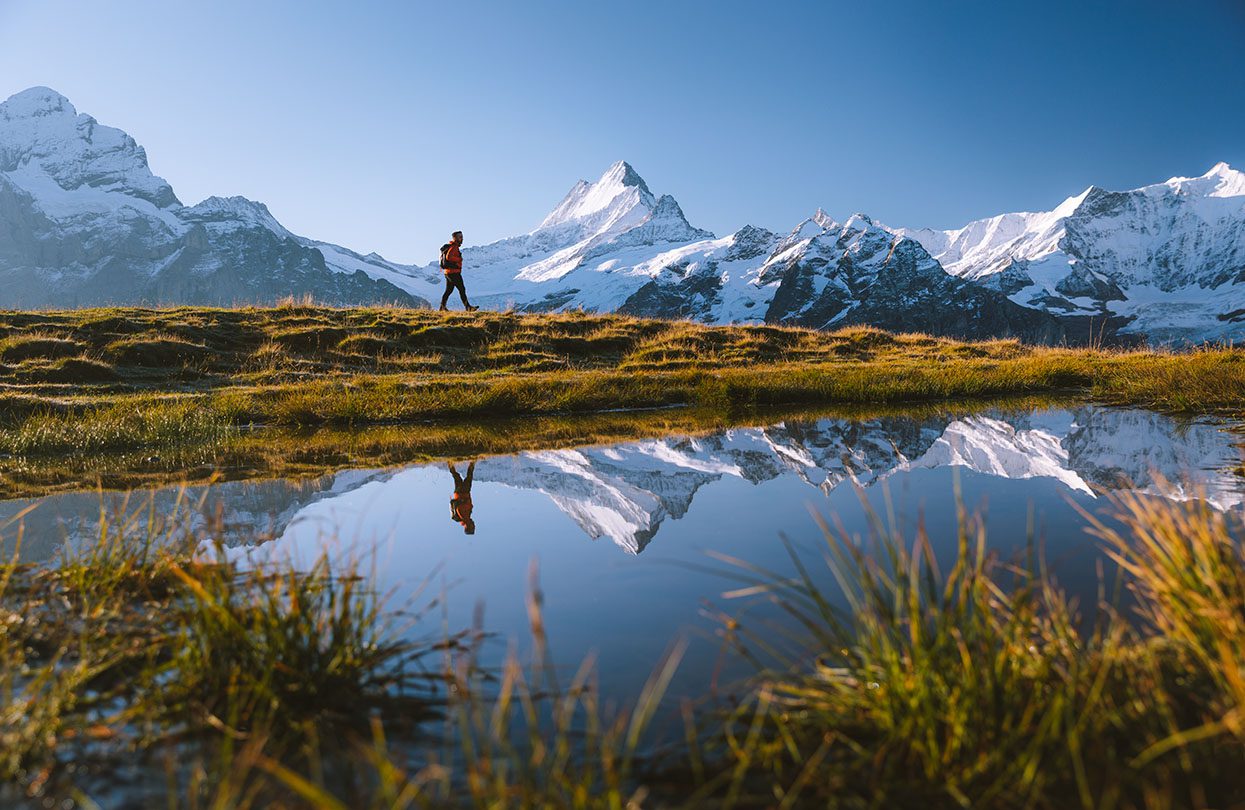
Hiking along the Lake Bachalp, image by David Birri, copyright Jungfrau Region Tourismus AG
With a round trip of just under 6km, this easy mountain trail is well-suited for all experience levels, with benches spread out along the path for a quintessential alpine picnic. So float above the clouds, dip your toes in the mirror-smooth waters of the alpine lake and take in the peaks of the Alps while time passes by unnoticed – a perfect zen moment. A near-perfect day here requires just one thing – your presence.
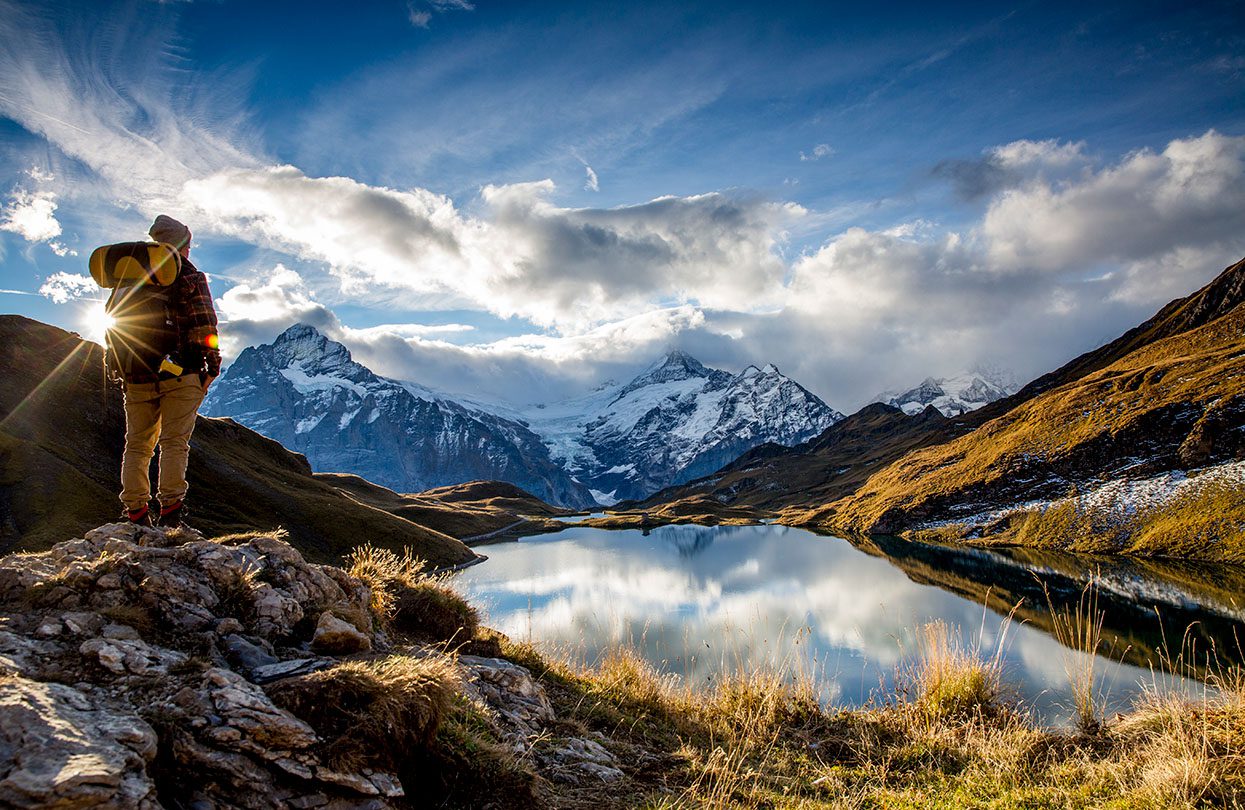
Hiking along the Lake Bachalp, image copyright Jungfrau Region Tourismus AG
The 25-minute cable car ride up to First from Grindelwald is one of the most scenic ways to start a hike in the Jungfrau Region. The gondola like cable cars take you past Bort and Schreckfeld mid-stations, offering cinematic views in all directions. The cable cars run throughout the day, thus spending a few hours exploring the area is easy.
The First Cliff Walk by Tissot is an incredible experience that everyone should try when at First. The views from up high are simply enchanting, and the walkway gives you a real sense of triumph. Situated at over 2,000m above sea level, the First Cliff Walk by Tissot is perched to the side of the mountain, offering breathtaking panoramas. The elevated metal walkway wraps around the cliffs like a catwalk, and the single rope hanging bridge is absolutely exhilaration.
Adventure, fun and entertainment from First to Grindelwald
Marmot Trail is an excellent place to mix outdoor sports and adventure with rest and recreation. The path leads from First to Schilt and continues on to the barbecue area in Oberläger, making it an ideal spot for a picnic lunch. Along the way, you can enjoy panoramic views of the mountains and forests, and if you’re lucky, you might even spot a marmot or two. The trail is well-marked and suited for all fitness levels, thus perfect for a family hike. And when you’re ready to rest, the barbecue area offers plenty of seating and stunning views of the valley below. So whether you’re looking for an adventurous hike or a peaceful picnic spot, the Marmot trail is sure to satisfy.
After hiking and picnicking, you may be ready to try your hand at some fast-paced family fun. Riding the cable car back to the village after a day of hiking in the Jungfrau Region is a pretty tame way to end your adventure. Why not take your family on the ultimate thrill ride by flying down to Schreckfeld on one of the Alpine ziplines?
First Flyer and First Glider are some of the safest ways to experience the rush of zipping down 800m at top speeds of up to 84 km/h. The views of the pastures below are stunning, and there are moments when you’re ziplining literally 50 meters above the ground. You’ll be back for more once you’ve had a taste of the rush.
Life is all about views, wheels and thrills as you continue down the 3km stretch from Schreckfeld to Bort. Get introduced to First Mountain Cart, a hybrid between a go-kart and sledge, equipped with wide-set wheels, hydraulic brakes and a guarantee of summer-long merriment for children and adults.
The day is still young, and there’s much to explore. Adventure awaits on the countryside paths of the Swiss Alps, just waiting to be discovered. Continue the exploration and scooter down to Grindelwald from Bort on a Trottibike. These hybrids between scooters and bicycles are great fun, and you’ll get to enjoy the crisp Alpine air and up-close views of meadows and farmhouses along the way.
Explore the Jungfrau Region on an e-mountain bike with over 30 charging locations
The Jungfrau Region is ideally suited for an e-mountain bike adventure with numerous trails winding through the mountains, offering incredible scenic sights along the way. Combine the beauty of the mountain panorama with outdoor action and adventure. Whether a beginner or an seasoned rider, it is easy to find trails that suit your experience level.
Electric-assist mountain bikes have now become the norm for leisure riders. Their tiny motors amplify your pedalling power so you can go farther and faster on the mountain trail. With the assistance of these e-mountain bikes, explore more of the great Swiss outdoors and make challenging climbs less daunting.
There is an added comfort when biking in Grindelwald. Recharge the batteries free of charge at any of the 30 BOSCH e-bike charging stations in the Jungfrau Region. So if you find the e-bike running low on power, there’s no need to worry. Just stop by one of the stations and give the bike a boost.
Take on the challenge of the Grindelwald-First mountain bike trail over asphalt and gravel road. With sweeping views of the Swiss Alps, this thrilling ride is not to be missed. The trail’s difficulty level, marked as ‘moderate’, covers a distance of 26.47km, making it achievable for most cyclists. Furthermore, the trail’s short duration of 3hrs 30 mins means you can enjoy additional activities along the way from Grindelwald to First, including the First Cliff Walk by Tissot.
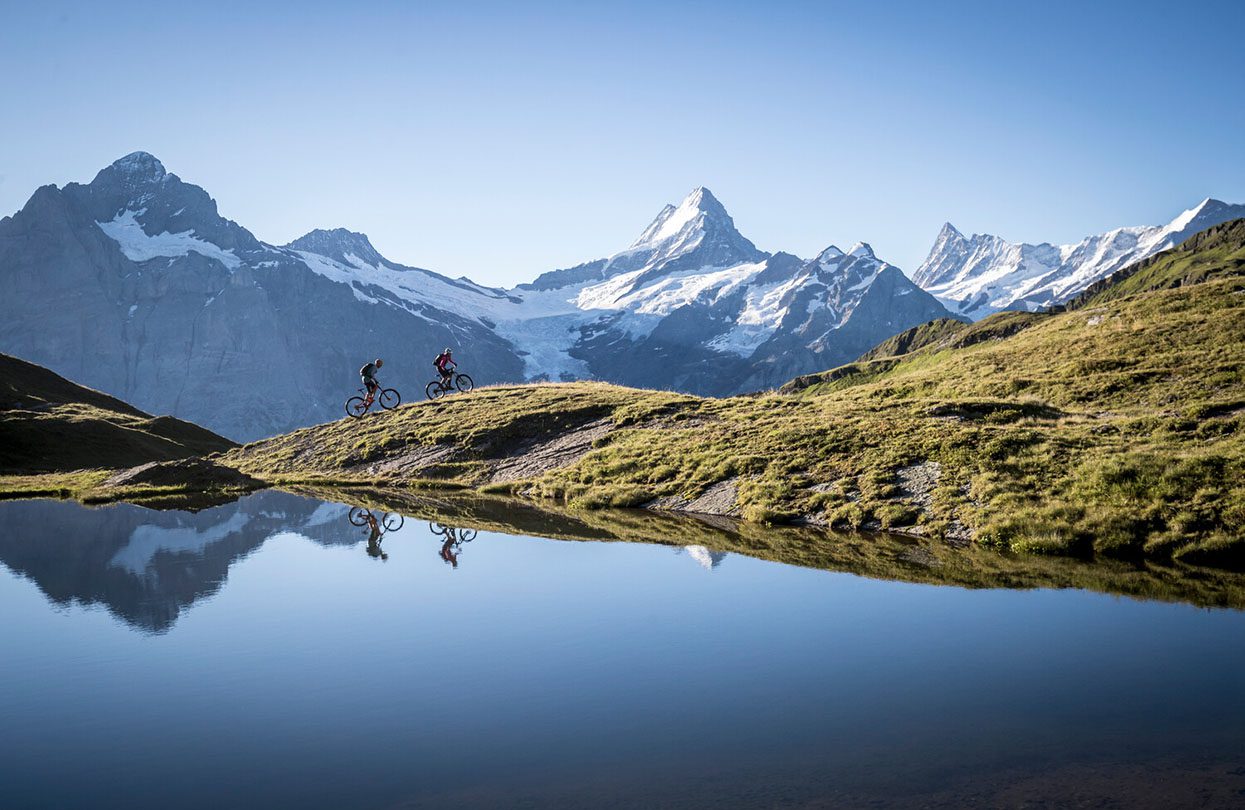
Mountain biking in Grindelwald, image copyright Jungfrau Region Tourismus AG
And when you’re ready for a break, there’s no better place to quench the thirst than Berggasthaus First. Located 2,167m above sea level at First cableway station, this mountain inn offers both indoor and outdoor panoramic terrace seating. With spectacular views of the surrounding mountains, it’s a superb place to enjoy a summer day. And since mountain biking can work up quite an appetite, you’ll be glad to know that Berggasthaus First serves Swiss cuisine, including refreshing drinks.
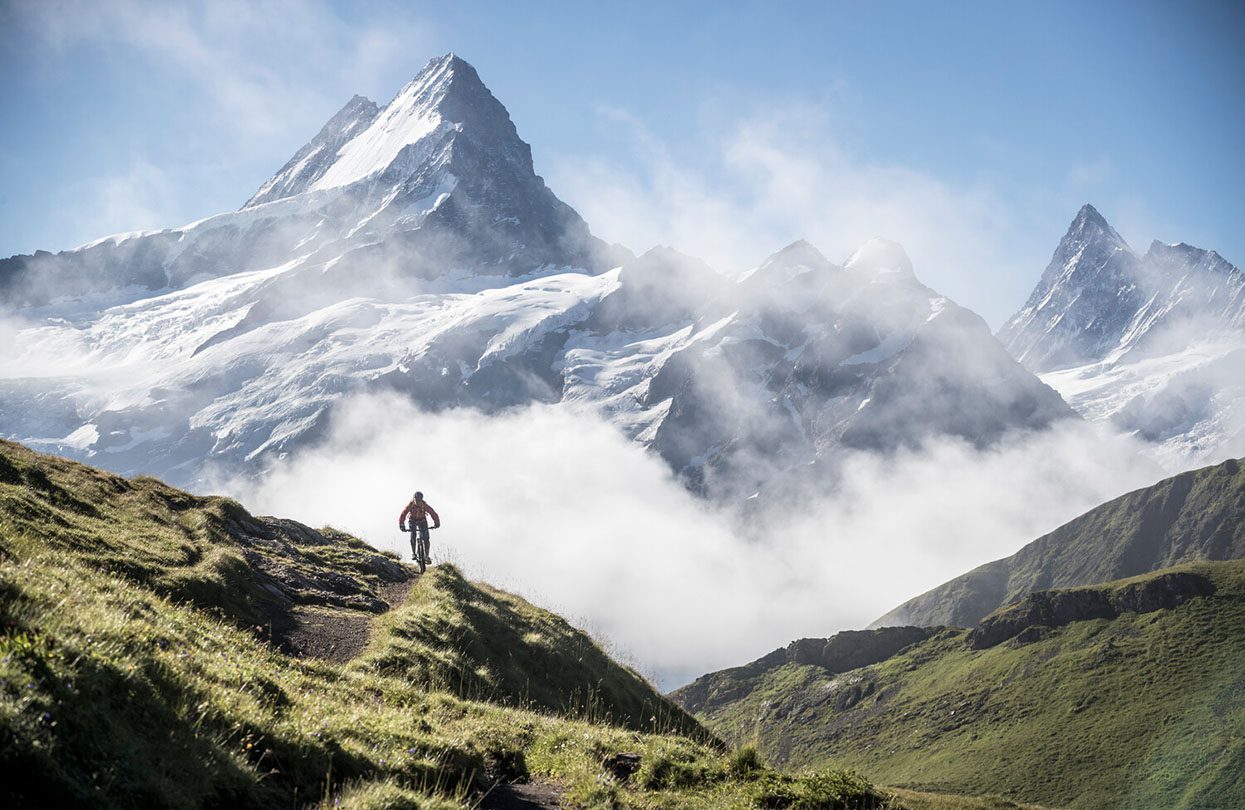
Mountain biking in Grindelwald, image copyright Jungfrau Region Tourismus AG
After a rejuvenating break, it’s time to change track and opt for the longer, dramatic route back to Grindelwald via the signposted mountain bike trail at Lake Bachalp. 13km of downhill riding awaits, with a mix of rock slabs, stepped passages, meadows and woods proffering plenty of interest along the way. The trail is mainly smooth to ride, making for an enjoyable descent of 1,200 metres to Grindelwald.
Downhill on the Eiger Trail (6km) with sweeping views of Grindelwald
After a few days of biking around Grindelwald, it’s time to switch gears and go for a hike. There’s something about being in the mountains that makes you want to slow down and take it all in. Maybe it’s the fresh alpine air, or the gradual incline of the trail. Either way, hiking is a great way to appreciate the natural beauty of Grindelwald.
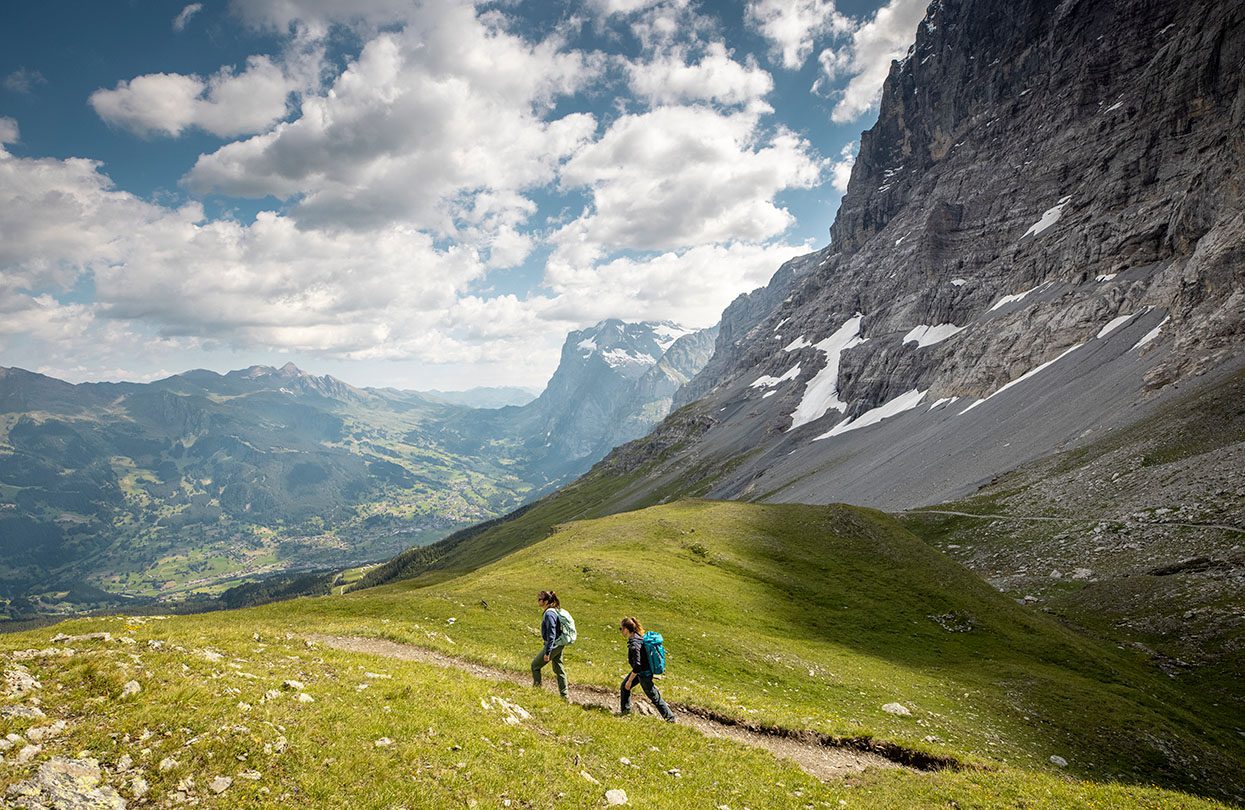
Hiking along the Eiger Trail, image copyright Jungfrau Region Tourismus AG
The Eiger Trail is one of the preferred hikes in the region for a good reason. It’s an easy 6.1 km downhill hike that starts at an elevation of 2,322 m and ends at 1,615 m. The trail offers magnificent panoramic views of the Lauterbrunnen valley, Murren, Grindelwald, and the Eiger North Face. It’s also a great way to get close to the majestic Mount Eiger.
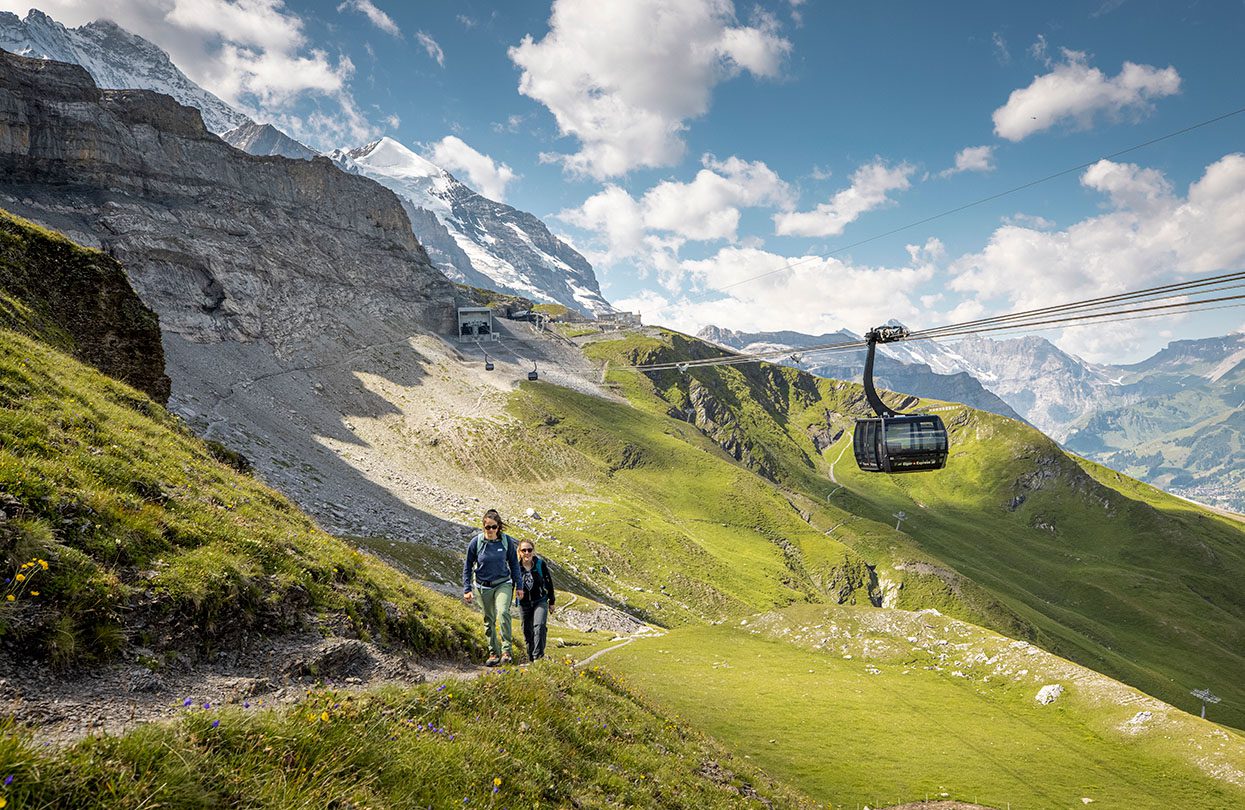
Hiking along the Eiger Trail, image copyright Jungfrau Region Tourismus AG
Along this trail, you’ll appreciate wild streams, waterfalls and steep alpine meadows; pristine nature at its best. Hikers can also relish the fresh mountain air and get some exercise while enjoying the incredible views in the process. The Eiger Trail starts above the Eiger Glacier Station (Eigergletscher) and ends at the Alpiglen station, with the Wengernalpbahn Railway taking you comfortably back to Grindelwald for your next Swiss adventure.
Panorama Trail hike (4.6km) from Männlichen to Kleine Scheidegg
The Panorama Trail from Männlichen to Kleine Scheidegg lives up to its name, with million-dollar views on all sides. This comfortable, one-hour hike is suitable for all ages and ability levels, gives you jaw-dropping views of both the Lauterbrunnen Valley and the towering mountain peaks of Eiger, Mönch and Jungfrau.
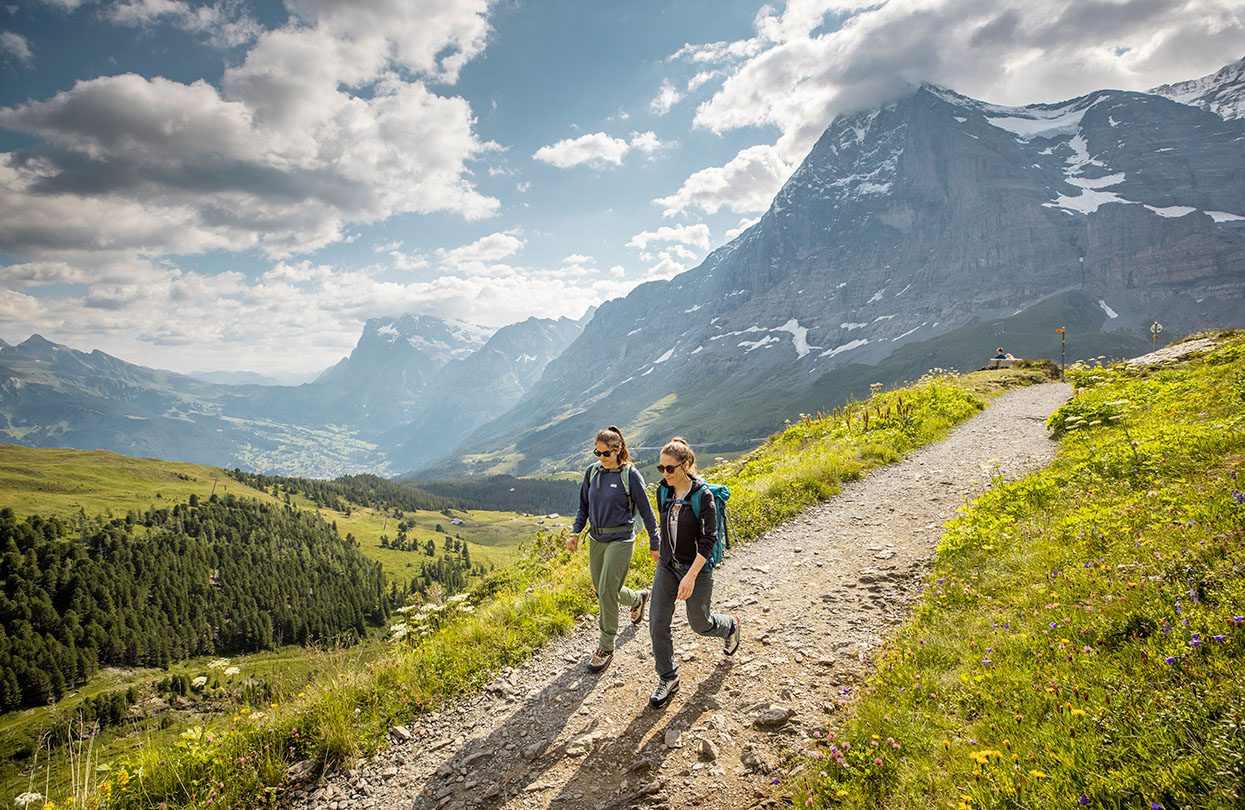
Hiking along the Panorama Trail, image copyright Jungfrau Region Tourismus AG
To reach the trailhead, take the 19-minute cable car ride from Grindelwald to Männlichen. Then simply follow the well-marked 4.6km trail as it winds its way to Kleine Scheidegg. As the journey takes shape, you’ll be rewarded with endless panoramic views that will leave you speechless.
Hike the Lauberhorn Trail from Kleine Scheidegg to Wengen
The easy hike to Wengen from Kleine Scheidegg provides plenty of opportunities to explore the outdoors and take in the pristine Swiss countryside. The hike is also a great way to get into the rhythm of relaxation, as the car-free village of Wengen is a profoundly peaceful place where the only sounds you’ll hear are those of church bells or cow bells. It’s an ideal place to muse over life’s greater meaning as you savour the views down to the Lauterbrunnen Valley. This hike from Kleine Scheidegg takes just under 3 hours and covers a distance of 8.16km, with a descent of 1,045m.
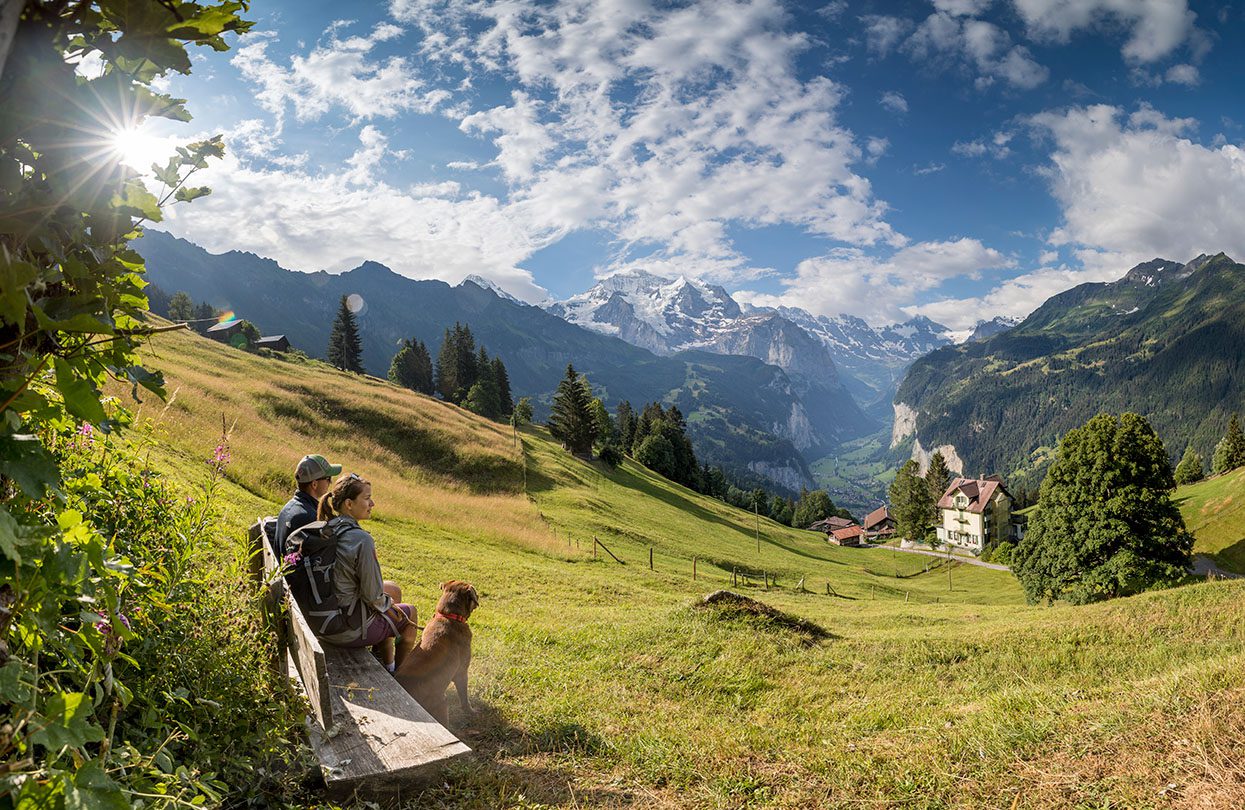
Hiking along the Kleine Scheidegg – Wengen Trail, image copyright Jungfrau Region Tourismus AG
Hike on the Glacier, Chill in an Ice Palace and Relax at the Top of Europe
Hiking mountain trails is one thing, trekking across gentle glaciers is another. No visit to the Swiss Alps would be complete without taking a walk on one of the many glaciers. These slowly moving rivers of ice are an awe-inspiring sight, and hiking on them is an experience that you’ll never forget.
Take a breather from hiking & biking for at least one day, if not two and head to Jungfraujoch. Top of Europe at Jungfraujoch is one of Switzerland’s most popular tourist destinations, and it’s easy to see why. At 3,454 metres, it is the highest point in Europe, and the views from the summit are simply dazzling.
On one side, you can see the Swiss Mittelland stretched out towards the Vosges mountains, while on the other side is the magnificent Aletsch Glacier, Europe’s longest glacier. The high alpine wonderland of ice and snow, a UNESCO World Heritage Site, is an unforgettable break from the summer days spent exploring the Swiss villages in the valleys below.
The Ice Palace at Jungfraujoch is a unique attraction that needs to be on your Swiss itinerary. Within the mirror-smooth passages of this ethereal place, you’ll find delicate sculptures of animals and everyday objects, all formed from ice as a fantasy. It’s as if they’ve been frozen in time! The Eagles, penguins, and bears look so natural that you’ll think they have been frozen during a moment of play.
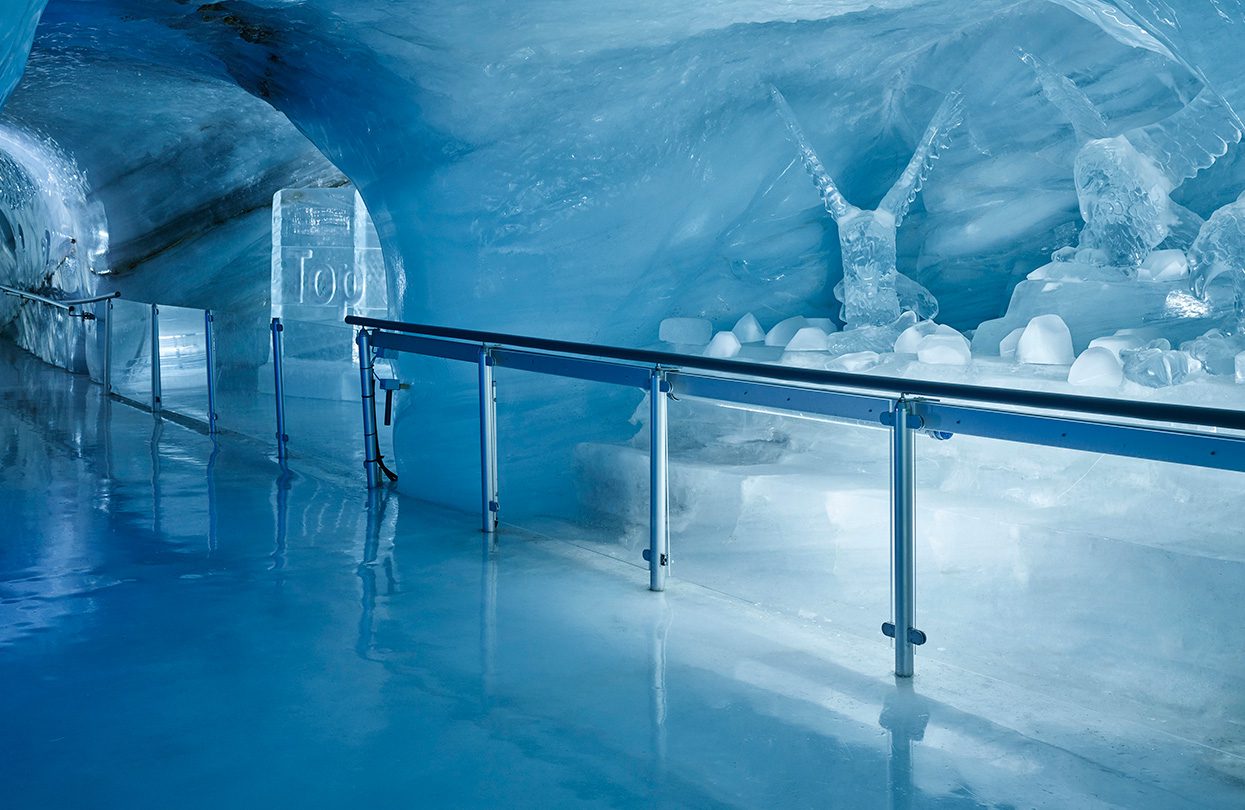
Eispalast Jungfraujoch Top Of Europe, image copyright Jungfraubahnen
Is hiking across a glacier with the family on your bucket list? This is an out of the world experience possible in Switzerland. The Mönchsjochhütte, a mountain hut at 2,650m standing at the origins of the Great Aletsch Glacier, is an epic place to start your adventure, offering grand views of the Swiss Alps.
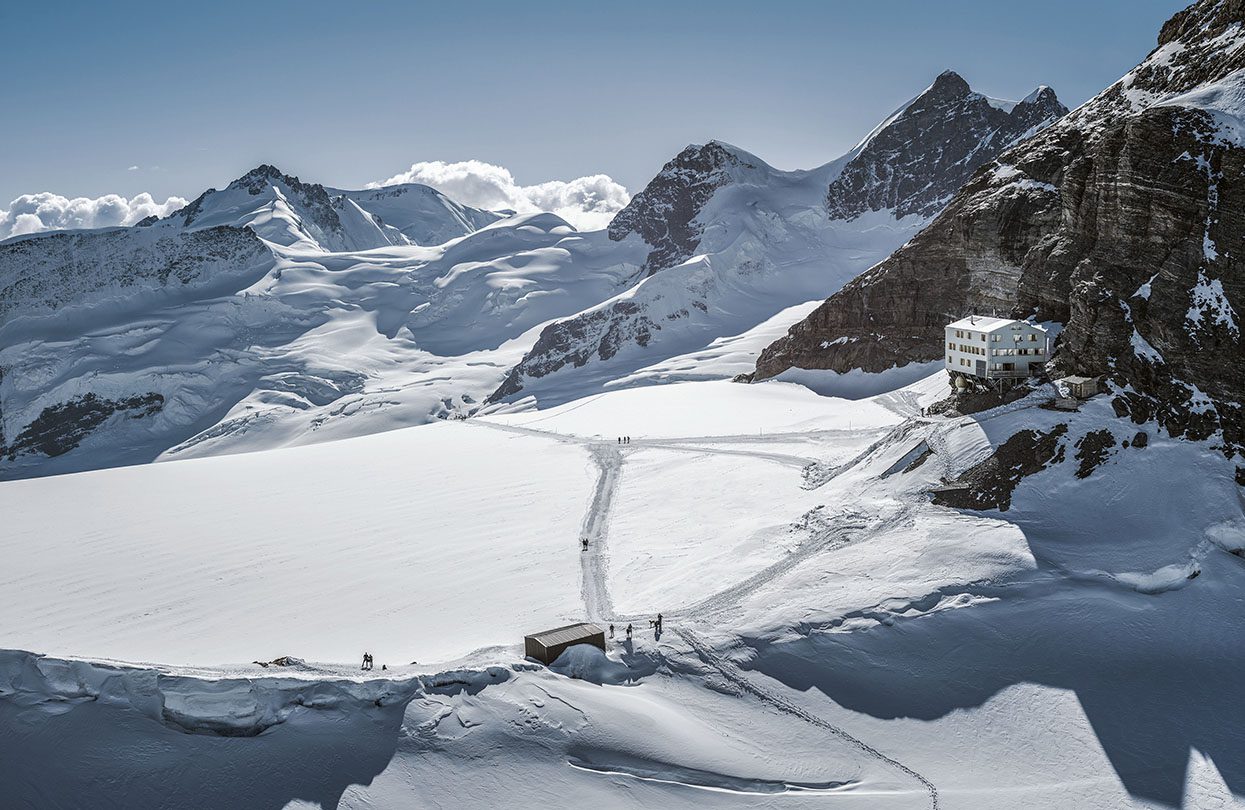
Moenchsjochhuette Jungfraujoch Top Of Europe, image copyright Jungfraubahnen
The snow-covered trail leading from Jungfraujoch to the hut is marked and prepared by a snowcat, making it easy to follow. The Mönchsjochhütte is a terrific way to experience the alpine glacier world in the midst of the UNESCO World Natural Heritage Swiss Alps Jungfrau-Aletsch. As a treat, reserve in advance and book an opportunity to stay overnight in the dormitory within the hut! The hut is open from March to October, and your stay includes sunrise and sunsets from the Top of Europe! So whether you’re looking for an exhilarating hike or a relaxing snowshoe walk, this is the place for you.
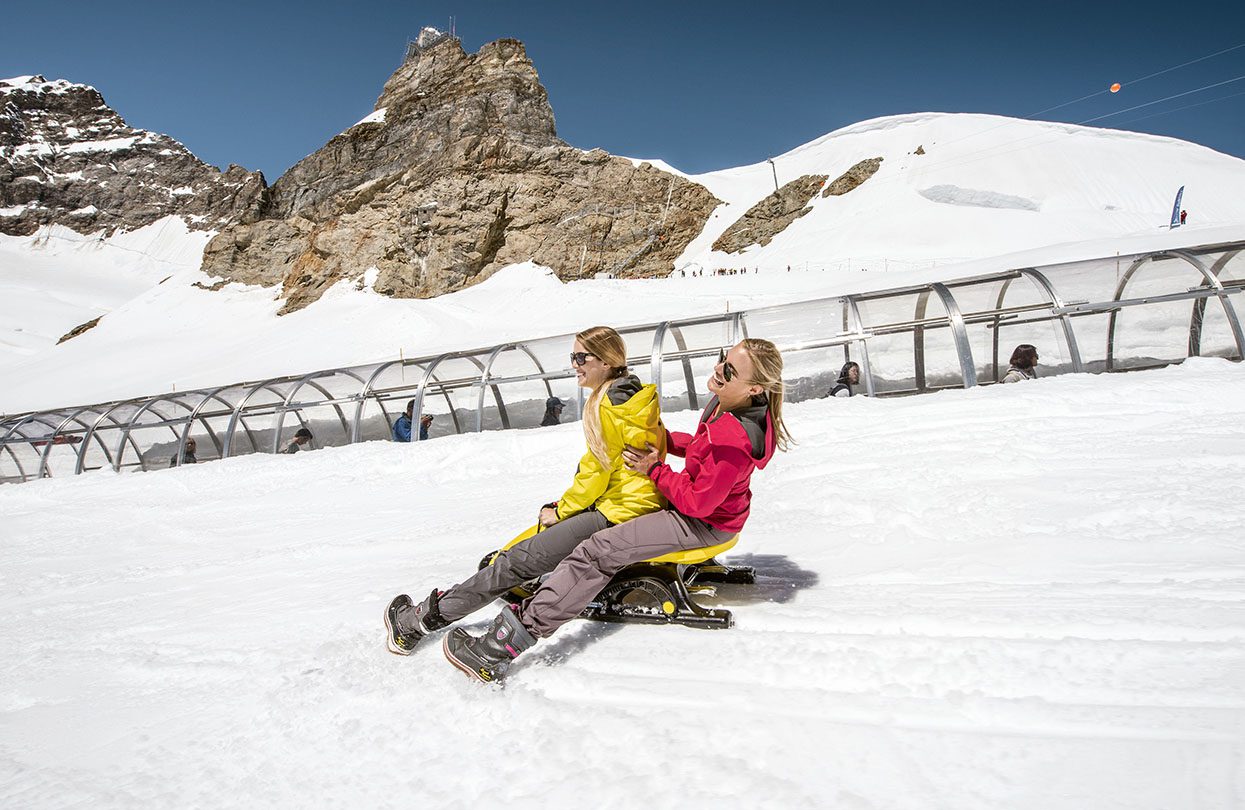
Snow Fun Jungfraujoch Top Of Europe, image copyright Jungfraubahnen
It’s the middle of summer, and why shouldn’t you be out playing in the snow! The Snow Fun Park at Jungfraujoch is the perfect place to frolic in the snow all through summer. With a Tyrolienne zipline, sledging, tubing, skiing, and boarding, there’s an adventure sports activity for every inclination. The views are incredible, and the temperatures are consistently around zero degrees. You’re guaranteed to have a blast 3,500 meters above sea level.
Explore a 250 million year gorge carved by glaciers
After spending time on mountain tops, hiking on glaciers and biking across trails, head to the Glacier Canyon Grindelwald and experience a natural work of art that has been in the making for 250million years.
The glacier that carved this 1km long, 300m deep gorge is now gone. However, the canyon is a fantastic sight to behold, with the rushing water of the Lütschine below adding to the spectacle of this dramatic landscape. The 1km long trail takes you through various sections, each with its own theme, such as geology, glaciers, water, and myths – making it an exciting experience for all ages. And because it’s all undercover, you can enjoy it no matter what the weather is like outside.
The young at heart will enjoy the 170m2 Spiderweb, a unique walkable net that has been stretched out 7 meters above the rushing water. This net structure lets visitors walk between the gorge as the water flows safely below the feet.
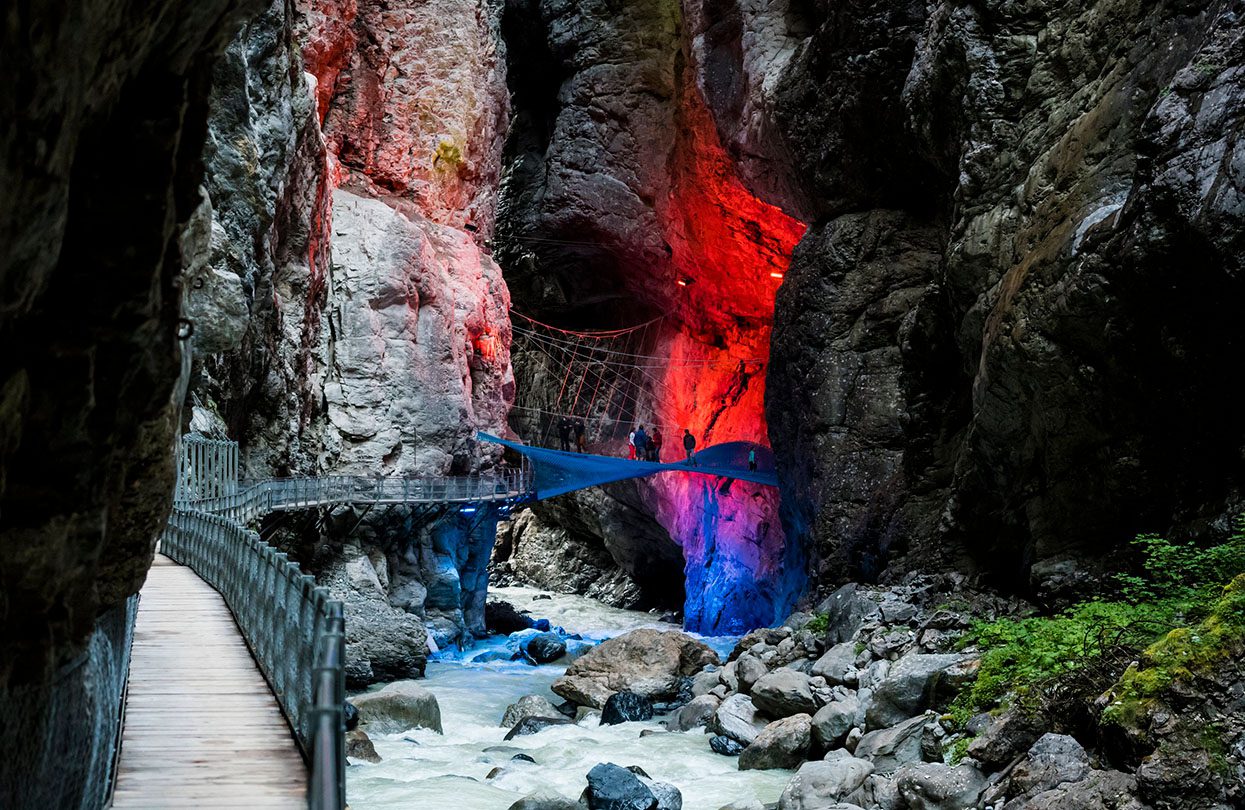
The Glacier Canyon Grindelwald, image copyright Jungfrau Region Tourismus AG
When looking for an outdoor adventure, the Jungfrau Region has plenty of activities to keep you busy, including world renowned trails for hiking and biking. With its stunning mountain views and variety of trails to explore, it’s no wonder the Jungfrau Region is a popular destination for hikers and outdoor enthusiasts alike. So what are you waiting for? Pack your bags and head to the Jungfrau Region for some unforgettable outdoor fun!
Best Places to Stay when in the Jungfrau Region
Schynige Platte – Mountain Hotel Schynige Platte
Grindelwald – Romantik Hotel Schweizerhof, Aspen Alpine Lifestyle Hotel, Boutique Hotel & Restaurant Glacier, and Hotel Bergwelt Grindelwald.
Interlaken – Victoria Jungfrau Grand Hotel & Spa, Hotel Royal St Georges Interlaken MGallery Hotel Collection*, Lindner Grand Hotel Beau Rivage and Carlton-Europe Hotel Vintage Adults Hotel.
Wengen – Beausite Park Hotel Wengen 
Subscribe to the latest edition now by clicking here.
© This article was first published online in July 2022 – World Travel Magazine.
The post Jungfrau Region: Outdoor Sports, Adventure And Fun first appeared on World Travel Magazine.
]]>The post 10 Incredible Experiences In Saudi Arabia For 2023 first appeared on World Travel Magazine.
]]>From beautiful coral reefs and desert rock formations to historical ones like Mada’In Saleh and old Jeddah – there is a treasure trove of discoveries to be had in the Middle East. Although the list of tourist places in Saudi Arabia and Arab wonders is extensive, here is World Travel Magazine’s selection of the ten most incredible experiences to be had in Saudi Arabia.
What are the 10 Incredible Experiences in Saudi Arabia?
1. Eve’s Tomb, Jeddah, Saudi Arabia
In the ancient city of Jeddah, the second-largest city in Saudi Arabia, is a cemetery known for the burial place of the first woman, Eve. So legendary is this tomb that the city it rests in has been named after the woman who rests there. Eve is widely considered the grandmother of humanity, and Jeddah means Grandmother in Arabic.
The tomb has been the stuff of legends since nearly the 12th century when Ibn Jubayr mentioned its presence in his travelogues. Eve Tomb is, obviously, one of the most famous places in Saudi Arabia. Unfortunately, a part of the cemetery was destroyed by Prince Faisal, the Viceroy of Hejaz, in 1928.
The prince did not want to promote idolatry, and in 1975, it was sealed with concrete by religious authorities. Nevertheless, the tomb is roughly 130m long, three metres wide, and six metres high before it was neglected to prevent idolatry. The tomb even finds mention in the original translations of the Book of One Thousand Nights and A Night.
Today located in one of the oldest cemeteries of the Al Balad district in Jeddah, Eve’s tomb is undoubtedly one of the top 10 places to visit when one wishes to experience Saudi Arabia.
2. Thee (Zee) Ain Ancient Village, Bidah Valley, Saudi Arabia
This historic village located in the Bidah Valley in Western Saudi Arabia is nothing short of an ancient paradise. The polished stone houses surrounded by mountains on three sides have remained mainly the same since the village was settled in the 8th century CE.
It had witnessed many a tribal battle in its time before King Abdul Aziz unified the Kingdom, and this makes it one of the only UNESCO World Heritage Sites on this list. This heritage village, named after a water spring that flows from the nearby mountains, is one of the best tourist places in Saudi Arabia.
Famous for its crops like bananas, Kadi, basil, lemon and palm, the Zee Ain village comprises 49 houses built on the Medamik wall system. Of these 49 houses, nine have only one floor, 19 have two floors, 11 have three floors, and 10 have four floors.
View this post on Instagram
Each house is roofed with Sider wood. Zee Ain is located 24 kilometres from Al-Baha. Visit Zee Ain’s heritage village to experience an extraordinary example of traditional architecture adaptive to the environment. The Thee Ain Village is one of the best places to visit in Saudi Arabia.
3. Dune Bashing in Qasim, Saudi Arabia
If Dune bashing Safari is not on your list of Arabian adventures to be had, perhaps you need a new list. Dune Bashing is a thrilling experience across the desert sands abundant in the region.
This is your chance to hop into a 4×4 and combine off-road mud and hill driving with a course guide. So sit back and enjoy your dandy (sandy) ride! It certainly is one of the top adventurous activities to do in the desert.
A winter sand dunes bashing adventure involves combing the 4×4 action with a bit of camping to embrace the tradition of Kashta. First, go camel riding, then sleep amongst the dunes under the soft glow of the winter starlight. Then, wake up to a nice cup of Arabic coffee to go sandboarding and dune bashing!
View this post on Instagram
Finally, wrap it up with a lovely firelit evening around a campfire with traditional food and drinks to keep you company. You could even visit one of the desert oases if you fancy.
Read More: Green Side Of The Desert
Read More: Red Sea & Saudi Arabia, The Next Buzzing Cruise Destination
4. The Al Wahbah Salt Crater, Saudi Arabia
Did watching the ‘Silent Sea’ on Netflix make you yearn to visit the moon? Was ‘2001: A Space Odyssey’ your go-to when you needed to feel some comfort? Well, the Al Wahbah crater is the spot to visit if you have a penchant for space adventures without leaving Earth. The crater makes the list of famous places in Saudi Arabia due to its lunar resemblance.
About 250 kilometres away from Ta’if, Al Wahbah is a volcanic salt crater about 780m deep and 6.9km in diameter. Al Wahbah is a maar crater formed due to volcanic activity underground (think magma meets subterranean water and cause a gigantic steam explosion) and is covered with white Sodium phosphate crystals at the bottom.
The local story of its creation is the stuff of legends. Before the crater, there used to be two mountains, Tamia and Cotton. One night, illuminated by a lightning flash, Cotton looked so beautiful that Tamia was instantly in love. She vowed to uproot herself in pursuit of her beloved, but before she could, her cousin Shelman struck her with an arrow. Where she fell, the crater was formed.
View this post on Instagram
Climbing down to this spot will take you about an hour, but climbing back up might take a bit longer. Either way, pack for a picnic. There are loads of picnic shelters at the rim where you can sit with your loved ones, enjoying the lunar landscape!
5. The Edge of the World – Jebel Fihrayn, Saudi Arabia
Think of the scene from ‘Pride and Prejudice’ when Lizzie Bennet stands at the edge of a cliff, contemplating her life. The ‘Edge of the World’ is the Saudi equivalent for your contemplations with a view of luscious golden desert sands.
This geological wonder is located in the northwest of Riyadh, the capital city, and is surrounded by the rocky desert. The view from the edge is what gives this location its name. Standing on the cliff gives you an uninterrupted view of the horizon. Visiting the ‘Edge of the World’ definitely tops Riyadh’s list of things to do as it is one of the top attractions in Saudi Arabia.
View this post on Instagram
You could even make a game out of it, spot the various dried river beds and fossils while making your way to the ‘window’. Here, climb down onto the lower plateau to go a little closer to the horizon, into the longer Tuwaiq Escarpment that drops down 1,000 feet into an ancient ocean bed.
Of course, the way to get to Jebel Fihrayn is via SUVs and careful driving. But once you’re at the edge of the world, lifetime contemplations will come to you organically.
6. Mada’In Saleh – Al Hijr, Saudi Arabia
Situated close to Al ula in the Medina Province is Mada’In Saleh, a city of ancient tombs carved into Sandstone. Mada’In Saleh was historically known as a Hegra by the Nabataean People, who carved these tombs – an archaeologists delight.
The community began as pastoral nomads who practiced oasis architecture and are believed to have come from the Hejaz region of northwest Saudi Arabia. The second UNESCO world heritage site on this list, Mada’In Saleh, consists of 131 monumental rock-cut tombs – ancient treasures of a world gone by.
The lesser-known cousin of Petra consists of tombs that are all finely carved facades with uniform styles. The tombs are also littered with various inscriptions that are the gateway to modern knowledge about Hegra. These silent historical artifacts and Al Ula earn Saudi Arabia points as a major tourist destination for history buffs.
View this post on Instagram
Finally, Qasr al-Farid is the stand-alone unfinished tomb that is representative of Mada’In Saleh. The city is known as ‘The Capital of Monuments’, and its extensive historical importance grants it a spot on the list of famous landmarks in Saudi Arabia.
7. Outdoor Activities in the Red Sea, Saudi Arabia
The Saudi government only completely opened its doors to foreign tourists in 2019. This means that the Saudi coastline along the Red Sea and the Persian Gulf coast is mainly uncharted for the international travel community and, as such, offers a wide variety of activities to do and new marine parks to explore.
Perhaps you could charter a boat at the Red Sea Marina. Go snorkelling or scuba-diving, maybe take a sunset cruise over the weekend to the middle of the sea. Really, the entire Red Sea is your oyster. You could even go seaside camping (with permission from the coastguard, of course) or kitesurf at beaches in Jeddah.
But the true spot on this list belongs to the deep-sea diving experiences in the Red Sea. Visit the underwater landmarks of Saudi. The first is at Abu Galawa, to witness the unexplored Galawa reefs. Here you can see schools of Barracuda and even have the odd encounter with hammerhead or tiger sharks.
View this post on Instagram
Next, visit the biggest shipwreck in the Jeddah area between two reefs. The Ann Ann sank in 1977 and now exists in perfect harmony with nature – its rudder is home to blue-spotted stingrays. Another shipwreck to visit is the Cable Wreck, which is the wreck of the Staphonos from 1978. Here you can see the guitarfish at this shipwreck.
Read More: Aman To Launch Its First 50-Suite Luxury Yacht In Arabia
8. The King Abdulaziz Falconry Festival, Saudi Arabia
Falconry refers to the hunting of wild animals utilizing trained birds of prey. It is a sport practised in many middle-eastern countries, and the Kingdom of Saudi Arabia is no exception.
The King Abdulaziz Festival of Falconry is an annual international festival organized by the Saudi Falcons Club. Participants at the festival include falcon owners from the Kingdome and the Gulf Cooperation Council.
It makes our list of the things to do in Saudi because of its cultural and international significance. This is the world’s largest falconry festival organized to promote and preserve Saudi Arabia’s rich cultural heritage.
View this post on Instagram
In the past, Falcons were trapped and trained by nomads to help in the hunt and feed their families. They were then released into the wild at the end of the season. This festival has set multiple world records and is a must during a winter visit to the Kingdom. Here, you can witness the true spirit and culture of Saudi Arabia.
9. Al Balad, Jeddah, Saudi Arabia
Al Balad is the centre of the historic city of Jeddah. The entire area of the old town is a UNESCO world heritage site, owing to its presence since the 7th century. From gorgeous mosques to traditional and historical houses, Al Balad is a living homage to Jeddah’s history.
The city is divided into various districts. The Al-Nassif House and the Al-Jamjoom House are some of the city’s most famous and oldest buildings. This trip down memory lane is one of the oldest and best landmarks of Saudi Arabia.
The old city is home to 600 heritage buildings nearly 500 years old, with more than 30 mosques and five souks – the shopping malls of yester years. Give yourself the chance to immerse in this gorgeous and colourful adventure as you venture through the narrow lanes, multi-storied mud-brick houses and stone buildings.
View this post on Instagram
For example, you could start at the village majlis near the replica of the Jeddah gate, then take a trip to the Saidi bakery that locals swear by for fresh bread. Next, visit the pilgrimage road to view the cylindrical rowshan and then make a detour to the Baeshen House to see the typical coral stone and wooden building common in Al Balad.
Read More: Exploring Tel Aviv & Jerusalem Through Food
10. The Judah Thumb and the Yellow Lake, Al-Ahsa, Saudi Arabia
The Devil’s Thumb or the Judah thumb is an exquisite rock formation that stands alone in the An Nafud region of the Arabian Desert. It is located about 160km from Dhahran, close to Judah (the town). The rock sticks out like a sore thumb in the expansive desert.
The trip can easily be made with an SUV, and around the thumb are various escapements that you can visit while making your trip to be wowed by rock formations and caves. Maybe, if you’re someone who enjoys desert camps and the gorgeous night sky, you could even camp out at night.
The Yellow Lake is located on the outskirts of Al Ahsa city and is an important wetland shallow lake formed from the runoff from the 22,000 farms that surround the region. Although it is fed from the runoff, the lake is a historical landmark known for its wildlife with various plant species and visits from migratory birds twice a year.
Rent an SUV and drive down to the lake for a picnic with the free sides of birdwatching and exploring the hills that overlook the lake!
View this post on Instagram
If you are looking for an unforgettable international holiday destination that still offers plenty of discoveries and new experiences, Saudi Arabia should be at the top of your list. With a wealth of landmarks both ancient and modern to explore, Saudi Arabia has been closed off to tourists for far too long – meaning there are plenty of surprises in store for visitors. 
Subscribe to the latest edition now by clicking here.
© This article was first published online in Jan 2022 – World Travel Magazine.
The post 10 Incredible Experiences In Saudi Arabia For 2023 first appeared on World Travel Magazine.
]]>The post Sail To Iceland With Ponant’s Luxury Expedition Ship Le Bellot In Style first appeared on World Travel Magazine.
]]>The French cruise operator Ponant, a world leader in luxury expeditions, is all set to resume cruising. Starting from July till August 2020, Ponant is launching a series of all-new expedition cruises circumnavigating Iceland. Each cruise will start and conclude in Reykjavik. The seven voyages will showcase the brand-new Explorer Class luxury expedition ship, Le Bellot – the fifth in a series of six new Explorer class ships.
The 180-guest Le Bellot will explore the coast and shoreline of Iceland during 7-night itineraries revealing the dramatic glaciers, fjords, waterfalls, and volcanoes of the mythic Nordic island nation.
Highlights of this Icelandic itinerary include Vatnajökull National Park, a UNESCO World Heritage Site, and crossing the Arctic Circle to observe whales, orcas, seals, and Atlantic puffins that make up some of the wildlife in this remote region.
A team of naturalist guides will be on board to share their knowledge of the fauna and flora of the regions visited. The expedition will also include zodiac outings, hikes, volcanic beaches, rugged cliffs, glaciers, icebergs, and natural warm water springs.
Realising the need to be ecologically responsible, Le Bellot represents a new generation of cruise ships featuring sophisticated technology and refined design. Le Bellot comes with only 92 staterooms and suites, all with a balcony or a private terrace.
Inspired by Jules Verne, the ship is equipped with a multisensory lounge that enables guests to comfortably experience the surrounding subaquatic world to enjoying a relaxed environment onboard, the luxurious ship offers a civilised way for guests to explore remarkably remote destinations in comfort and style.
Safety First: Sail with Confidence
To successfully prepare to sail back and resume services, Ponant has collaborated with the Institut Hospitalo-Universitaire (IHU) Méditerranée Infection of Marseilles, one of the world’s leading centres in the field of infectious diseases, as well as with the Battalion of Marine Firemen of Marseilles and Bureau Veritas, a world leader in testing, inspection and certification (TIC).
The fleet is equipped with high-level hospitals aboard the ships, made up of a state-of-the-art medical infrastructure (radiology, biology and even resuscitation devices, etc.) that goes beyond all current touristic standards. An expert medical team made up of at least one doctor and a nurse, available around the clock, are present in these hospitals.
Ponant relies on the provision and maintenance of a “Covid-Safe” area around its ships, a hermetic sanitary bubble, thanks to the rollout of three layers of shields: stringent onboard access conditions, rigorous sanitary protocols throughout the cruise as well as daily checks (guests, equipment, ships). It includes the implementation of a health check for 100% of the people on board (guests and crew members) and filtering and disinfection at boarding in a guest circuit that has been entirely redesigned for before, during and after the cruise.
In addition, upon arrival at the airport in Iceland, all passengers must take a PCR serology test and obtain a negative result to gain access to the vessel. 
Subscribe to the latest edition now by clicking here.
© This article was first published online in July 2020 – World Travel Magazine.
The post Sail To Iceland With Ponant’s Luxury Expedition Ship Le Bellot In Style first appeared on World Travel Magazine.
]]>The post Sail Away On A Catamaran Amidst Breathtaking Views Of Phuket first appeared on World Travel Magazine.
]]>Aboard the Blue Moon Catamaran in the middle of the pristine waters off Phuket, this is precisely how I felt as I embark on a day trip amongst the jiggered rock islands along the Eastern bounds of the Andaman Sea.
Escaping the hustle of Singapore in February, I blocked a quick weekend rendezvous in Phuket and cruised aboard this private catamaran with my family amongst the tiny, beautiful islands dotting around Phuket. Little did I know that it will be the last overseas trip I would undertake before the world moved into lockdown. This quiet, serene and refreshing getaway turned out to be a perfect opportunity for me to bond with my family, while in the company of stunning blue backdrops melting away to an orange sunset.
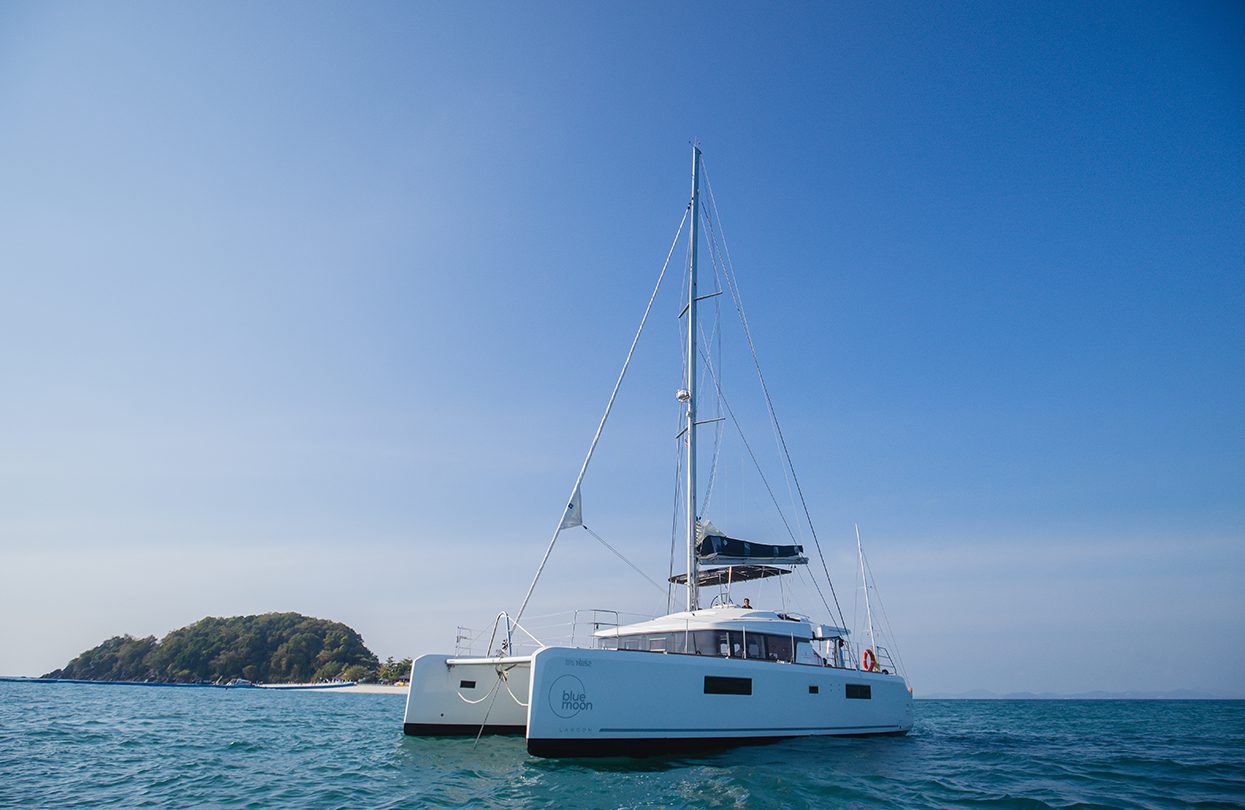
The Blue Moon, a 52 feet catamaran complete with 5 en-suite cabins, Photo – Wan Tse, Simpson Yacht Charter
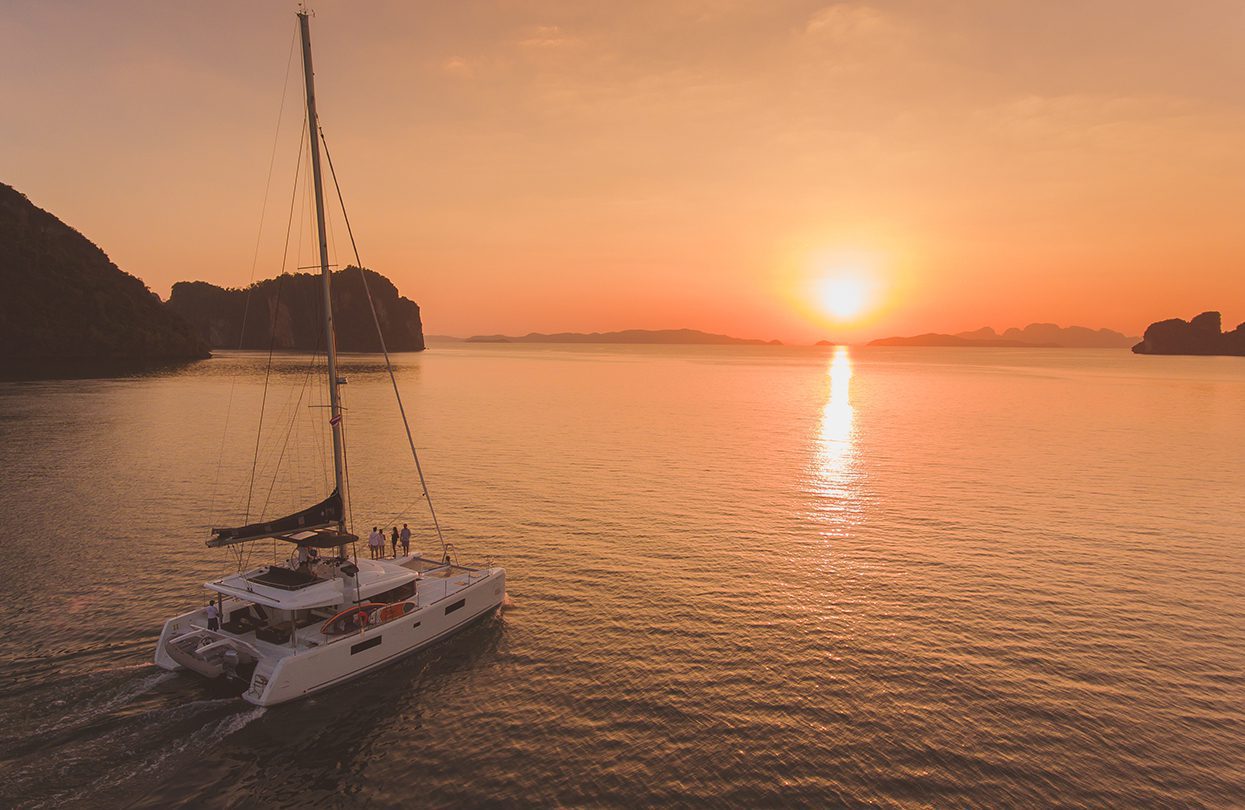
The Blue Moon catamaran sails into the dramatic sunset of Phuket, Photo – Wan Tse, Simpson Yacht Charter
Sailing from Ao Po Grand Marina in Phuket to Phang Nga Bay
We boarded the luxurious 52 feet long catamaran ‘Blue Moon’ early in the morning from the Ao Po Grand Marina located on the eastern edge of Phuket. Manned by a well-trained crew of two and complete with 5 en-suite cabins, an ample salon with panoramic views, good sized deck areas to relax with two large bow trampolines that doubled as hammocks for lounging, being on board this yacht felt more like travelling in a sleek apartment with the blue sea as companion. Our Andaman adventure had begun.
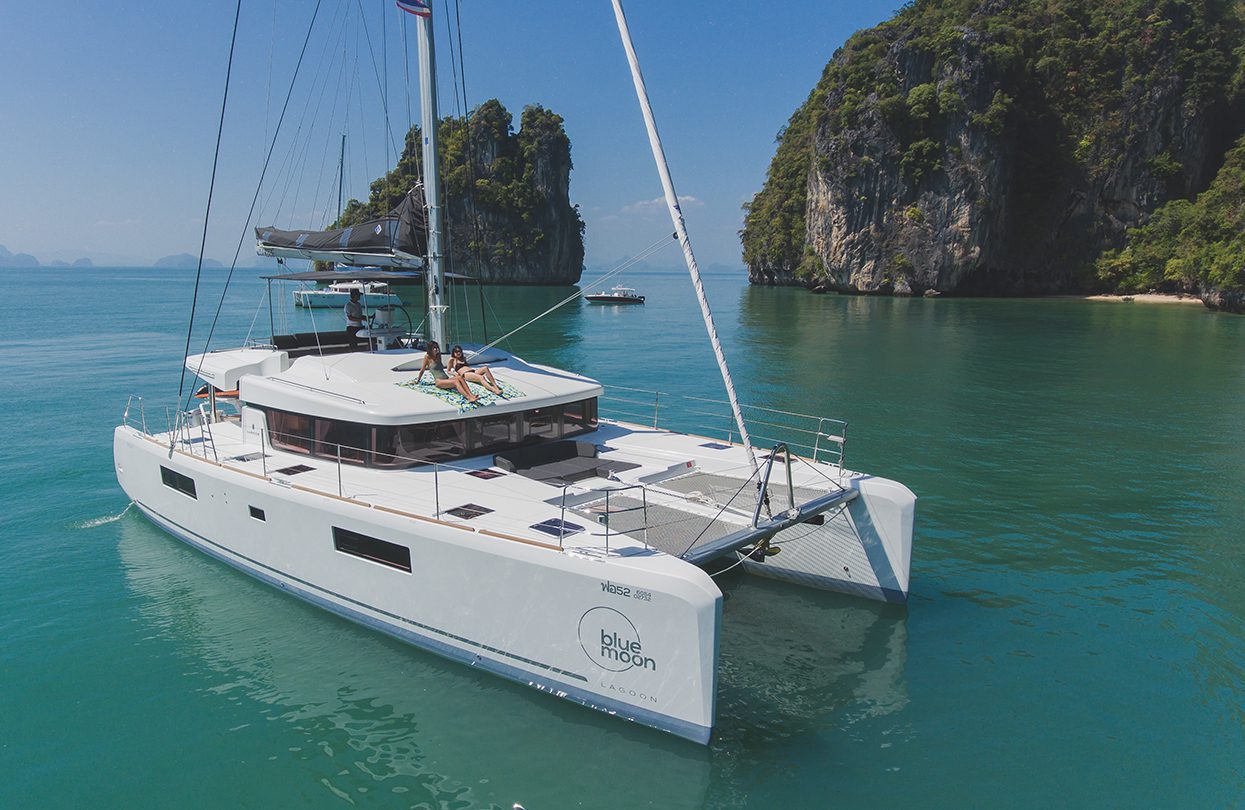
The luxurious 52 feet long catamaran ‘Blue Moon’, Photo – Wan Tse, Simpson Yacht Charter
Phang-nga is famous for spectacular scenery with limestone cliffs dramatically rising out of emerald green water. There are caves, secret lagoons and tiny secluded beaches, a few of which are still awaiting discovery. Phang Nga Bay is located 75 kilometres northeast of Phuket and is a national park surrounded by hundreds of unique limestone islands with names to match their shapes. In addition, there are magical stalactite caves and countless rocks and sea caves.
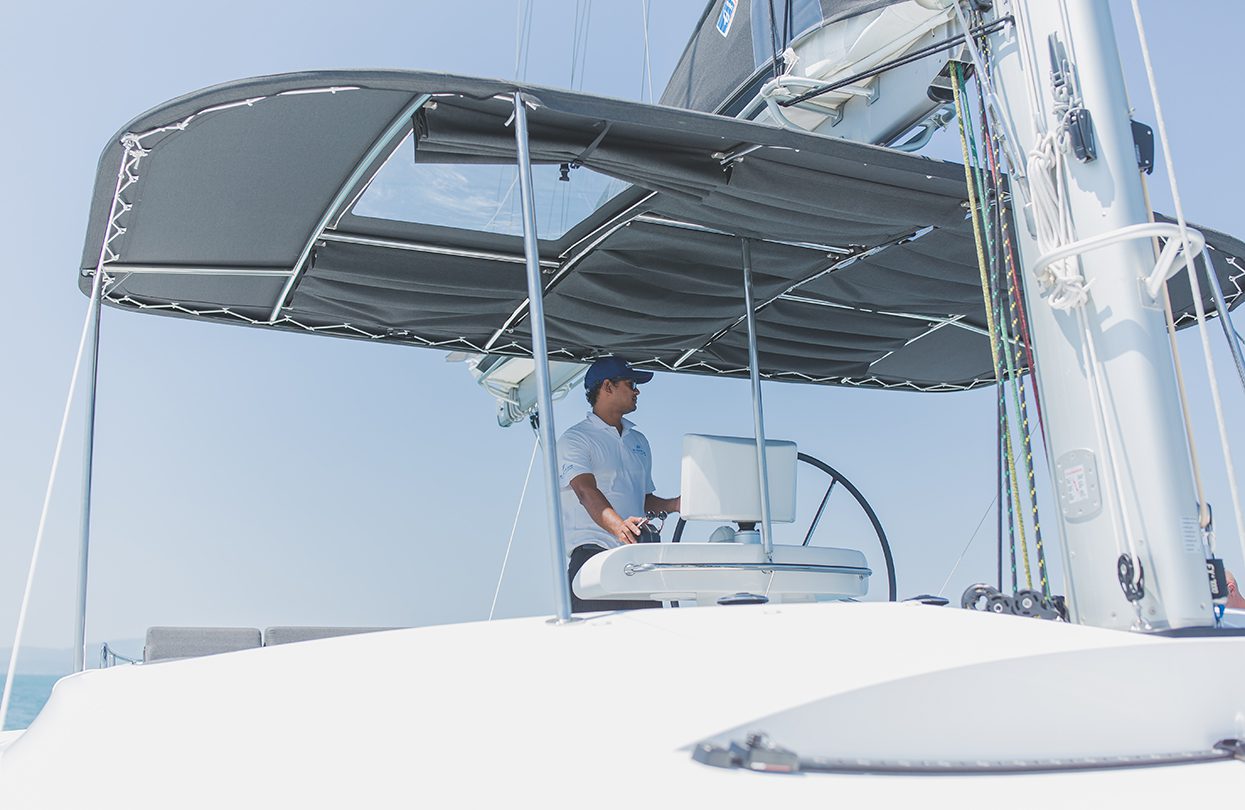
The Captain navigating the catamaran towards the Phang Nga Bay, Photo – Wan Tse, Simpson Yacht Charter
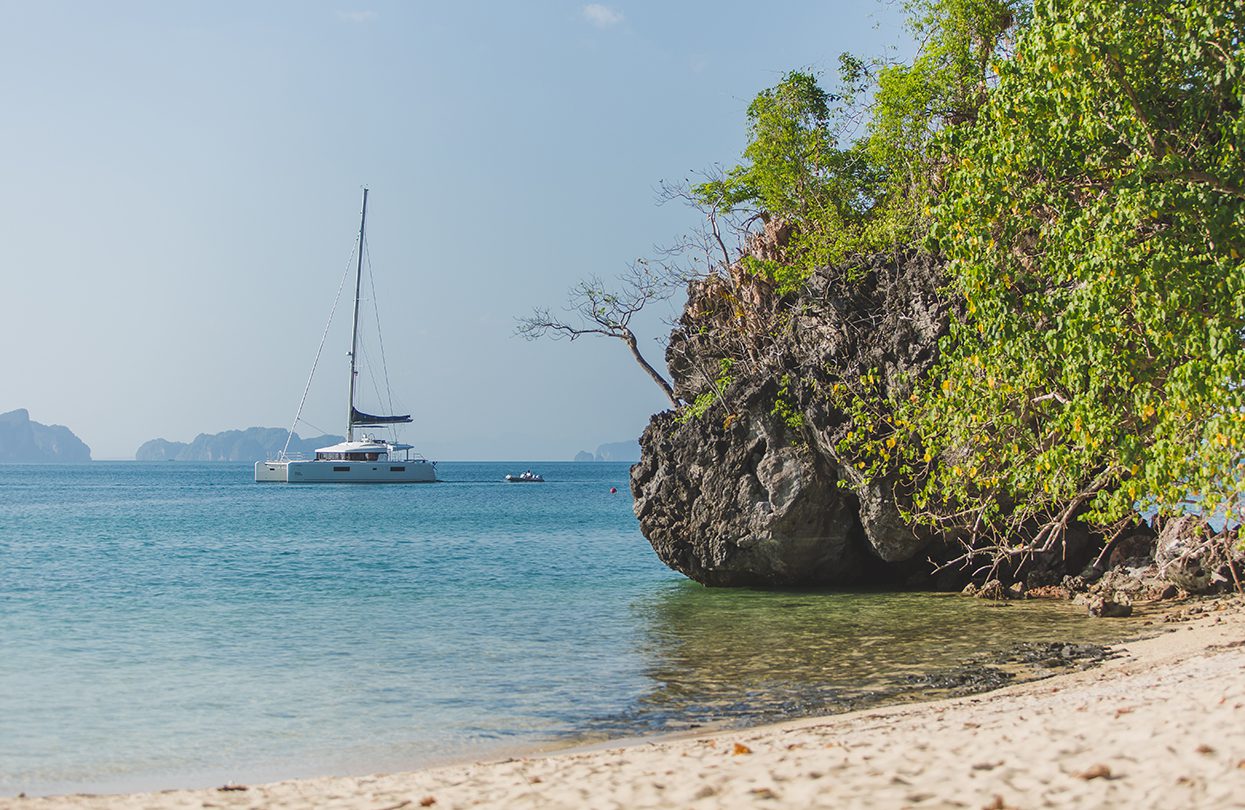
The shallow draft of the catamaran at 5 feet allows it to access remote locations, Photo – Wan Tse, Simpson Yacht Charter
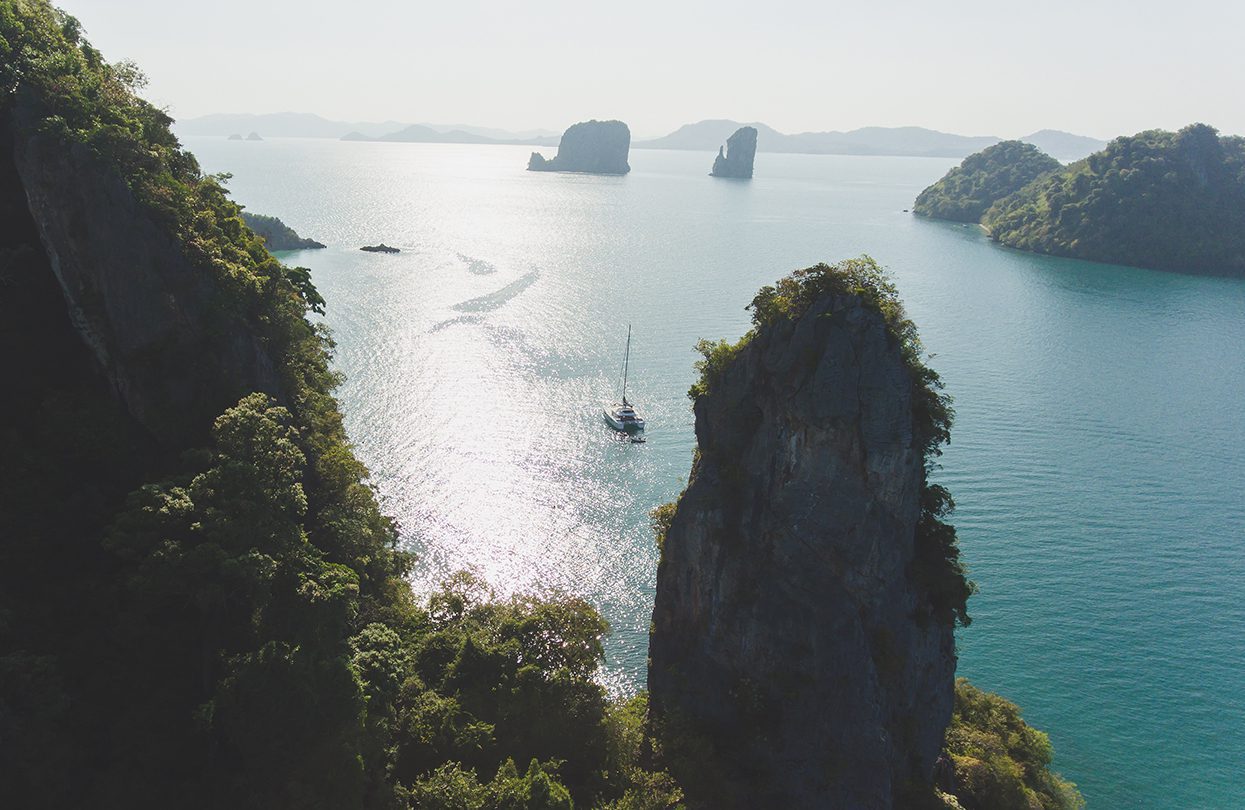
Phang-nga is famous for spectacular scenery with limestone cliffs dramatically rising out of emerald green water, Photo – Wan Tse, Simpson Yacht Charter
We were in awe of the beautiful island scapes surrounding Phuket and with a carefree agenda in mind, requested the Captain to explore the near-by islands at a leisurely speed, an advantage of sailing on your own yacht – there are no time tables to keep up with. Captain Jim knew exactly what we had in mind and set a gentle pace for the rest of the day. He suggested we explore the caves & secret lagoons at Koh Panak island, an experience, he promised, would take us up close and within the limestone towers.
Secret Lagoons and Sea Caves
Finding the entrance of sea caves within the base of limestone cliffs, exploring their dark pathways and finding oneself emerging into a hollow ‘hong’, a quiet and meditative sanctuary locked within a limestone karst island, with the sea cave the sole entrance and exit that ‘locks’ itself with high tide – this is an adventure best done with specialists on hand. Our brave Captain Jim, knowledgeable, experienced and well equipped, lead us – the fearful city dwellers – cautiously through dark winding pathways, littered with age old stalagmites and puddles of water on the rock floor. The only sound we could hear was water dripping from the ceiling of the cave, a constant reminder that the cave’s occupant – the tide – would be arriving soon.
A few minutes later, we emerged into the ‘hong’ – a large, secret opening enclosed by tall cliffs and the open blue sky for ceiling. No passing boat would have known that we were here. The sound of bird and the sight of a few mangrove trees and shrubs growing within the cracks of the cliff hinted of life in this stealthy hideaway. If imaginations were played out, this may have centuries ago, doubled as a villain’s lair or the ‘X’ on a pirate’s treasure map. Not in control of time nor tide, we hurried out back to the entrance, just in time to witness the water rise steadily by over half a meter and seal off the pathway and the cave entrance.
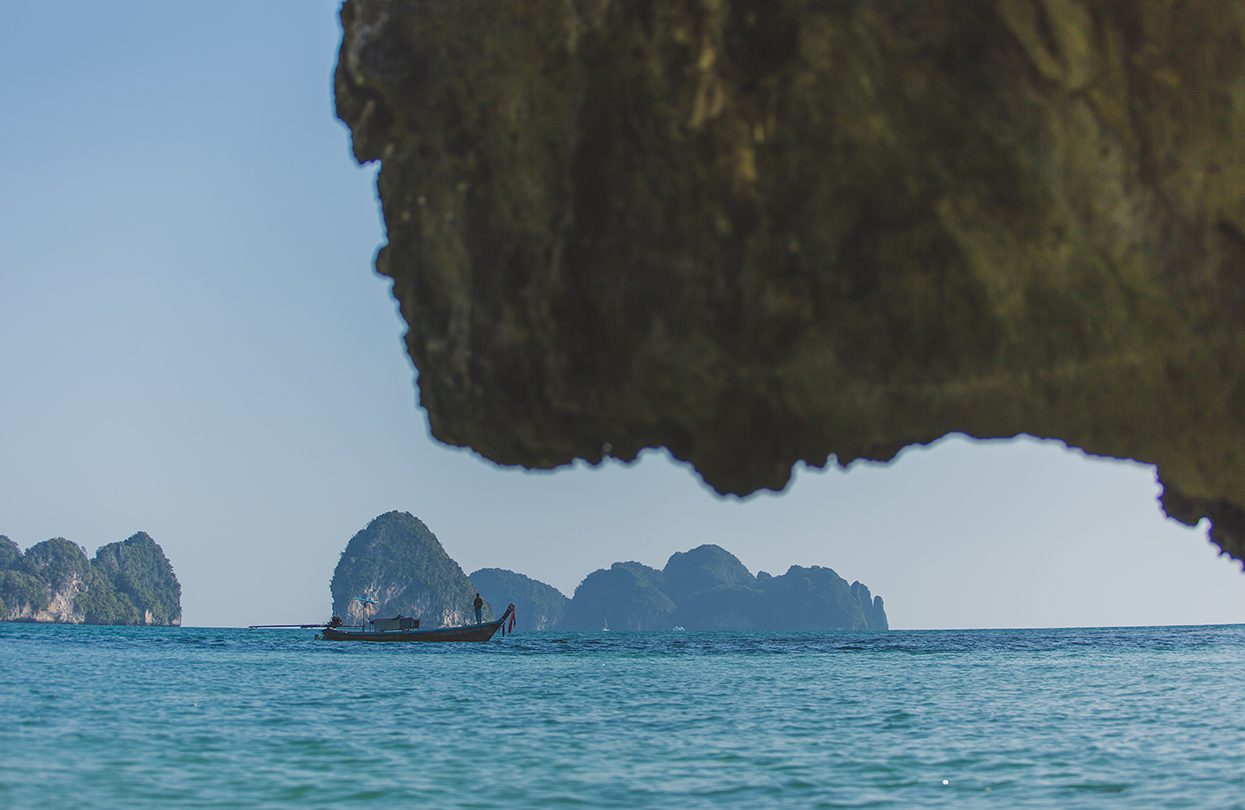
The protruding cliffs hanging precariously over the sea kept us amused as we relaxed on the two trampoline hammocks, Photo – Wan Tse, Simpson Yacht Charter
Ao Phang Nga National Park is home to many such caverns and caves, both discovered and those that have not been explored yet. We could have easily spent the entire day in this location, but such is the beauty of the surrounding jade-coloured water that called for us to continue exploring.
As Thailand opens its borders for tourists and a need for social distancing is in everyone’s mind, chartering a catamaran over the weekend is an excellent option to explore and unwind.
Back in the comfort of our luxurious catamaran, we refuelled and refreshed with Chef Nok at hand to treat us to a sumptuous feast of authentic vegetarian local cuisine. Our lazy day on board continued as Captain Jim charted our afternoon journey amidst the islands of Phang Nha Bay. We were at ease, playing hide and seek amongst the labyrinth of uninhibited rock islands. The protruding cliffs hanging precariously over the sea kept us amused as we relaxed on the two trampoline hammocks at the bow of the catamaran. With a canvas canopy sheltering us from the tropical sun and a strong breeze keeping everyone cool, our steady pace across the bay dissolved the afternoon into a sweet nothing – a ‘Dolce Vita’ moment experienced.
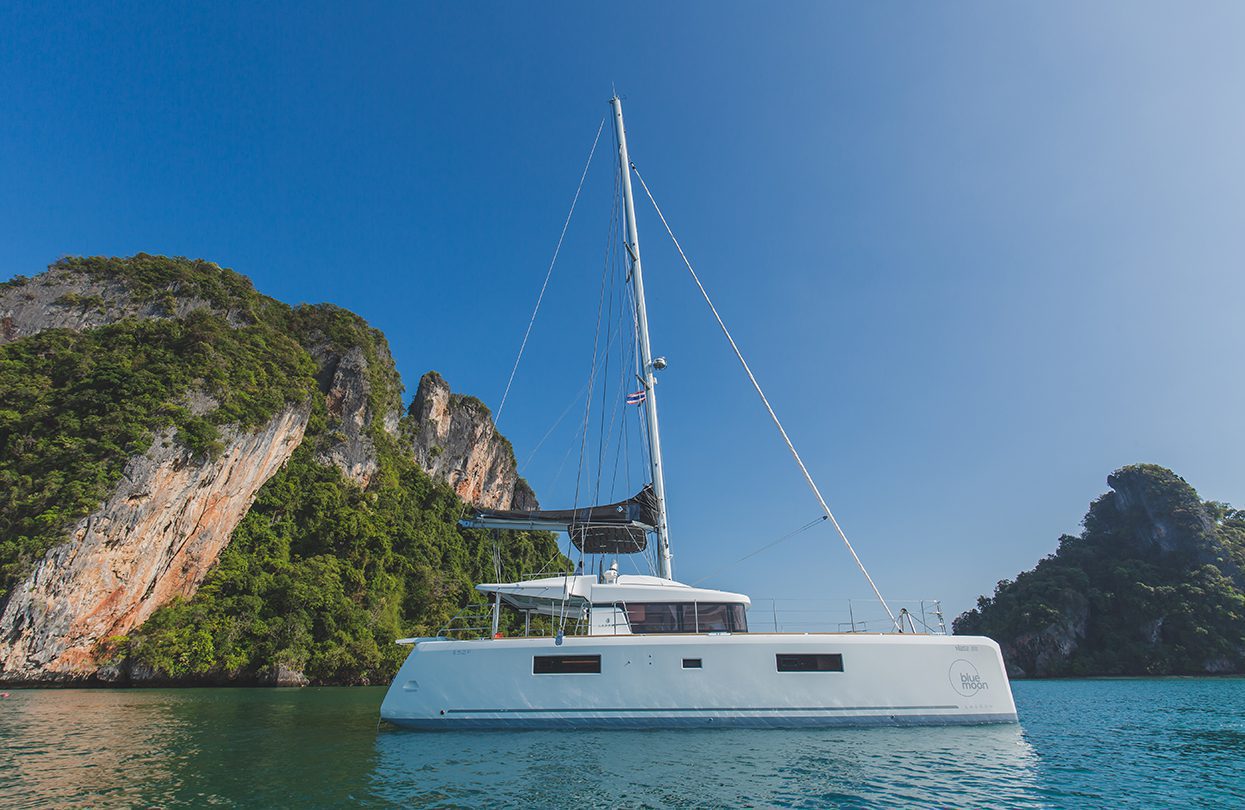
The Blue Moon catamaran at Phang-nga, Photo – Wan Tse, Simpson Yacht Charter

Chef Nok treated us to a sumptuous feast of authentic vegetarian local cuisine, Photo – Wan Tse, Simpson Yacht Charter

Chef Nok treated us to a sumptuous feast of authentic vegetarian local cuisine, Photo – Wan Tse, Simpson Yacht Charter
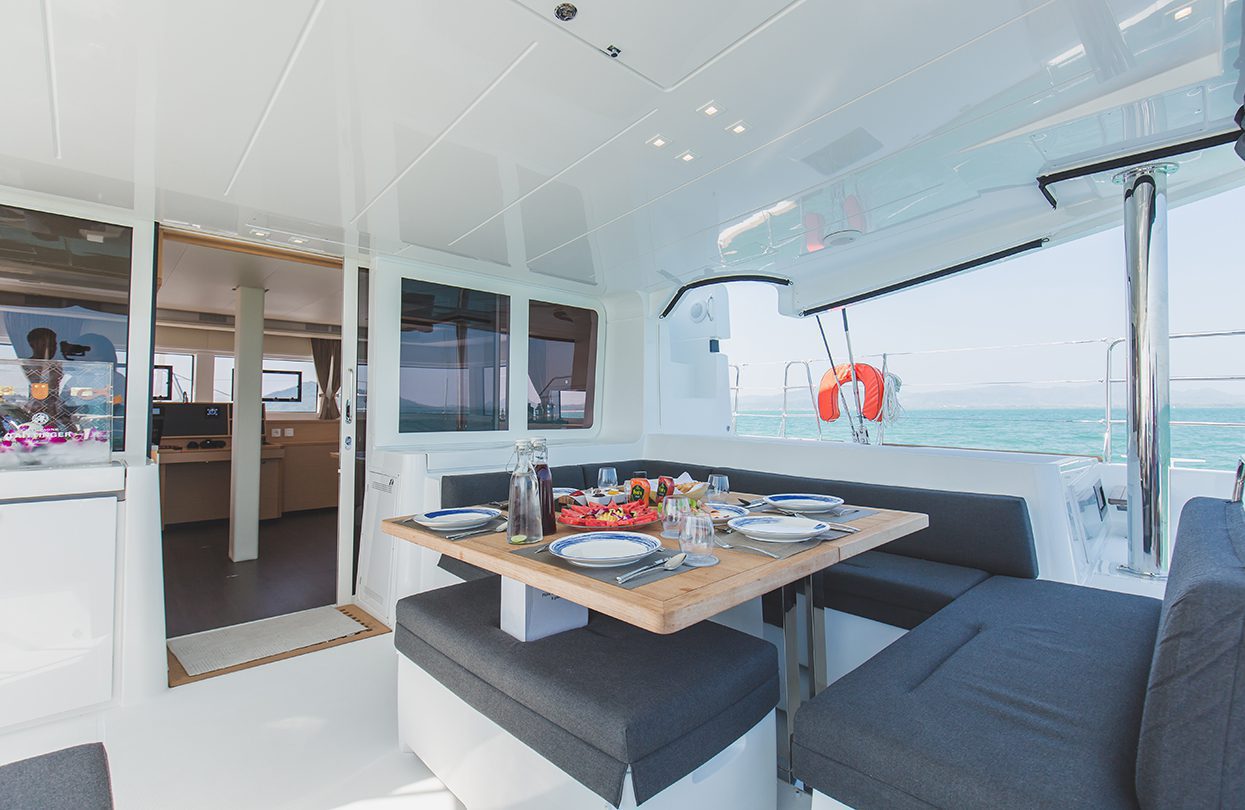
The open plan layout of Blue Moon is lively with a dining area, lounge seating, TV entertainment and galley, Photo – Wan Tse, Simpson Yacht Charter
Sailing in this luxurious catamaran, Blue Moon, comes with its advantages. Apart from an expert staff on hand that ensures peace of mind, security, local knowledge and expertise, the catamaran is well equipped with snorkelling gear (masks and fins) and kayaks to double the fun. Having a charter adds to the luxury of not following a schedule or a direction laid out in an itinerary. If the green spec of island on the far left with a tiny cove appeals to the senses, the Captain is on hand to oblige at a moment’s notice. The shallow draft of the catamaran at 5 feet allows it to access remote locations which an ordinary single-hull yacht or a tourist ferry would generally avoid.
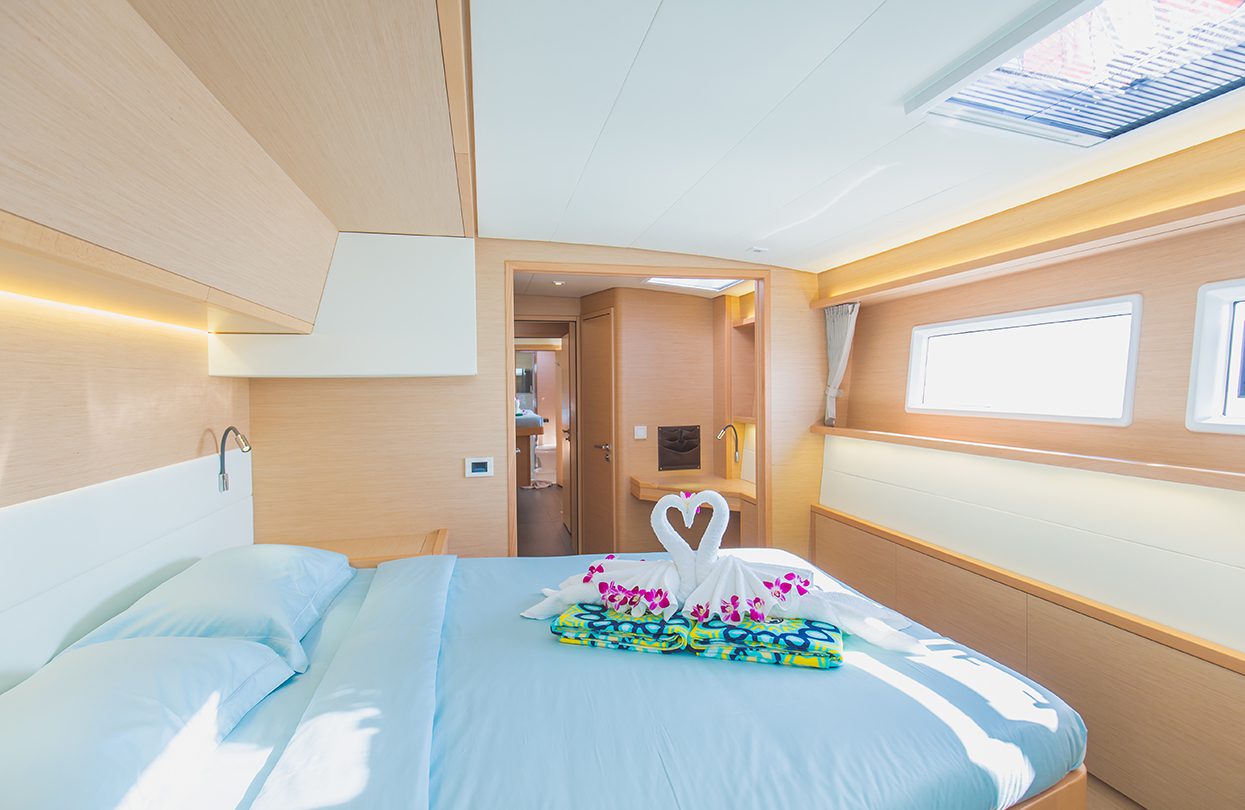
The Blue Moon has five ensuite luxurious cabins, four of which are fitted with queen size beds & one with two single bunks, Photo – Wan Tse, Simpson Yacht Charter
The interior of the catamaran comes with vertical windows in the salon which creates a spacious environment to lounge with a beautiful panoramic view of the sea. The open plan layout is lively with a dining area, lounge seating, TV entertainment and galley.
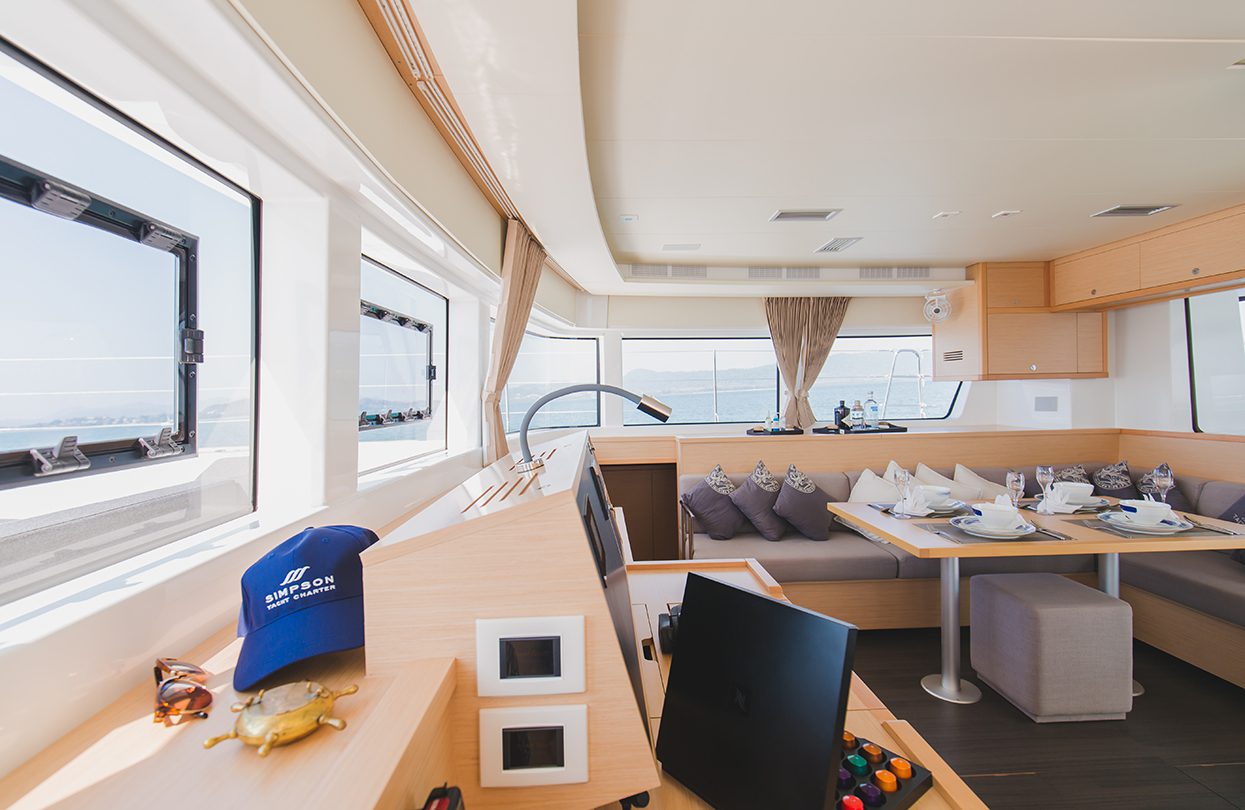
The interior of the Blue Moon catamaran comes with vertical windows in the salon which creates a spacious environment to lounge, Photo – Wan Tse, Simpson Yacht Charter
With five en-suite luxurious cabins, four of which are fitted with queen size beds & one with two single bunks and vast deck areas to enjoy, the Blue Moon catamaran is perfect for a family of ten. Blue Moon catamaran by Simpson Yacht Charter is a luxurious and a fun way to explore the islands that surround Phuket over either a day or a long weekend.
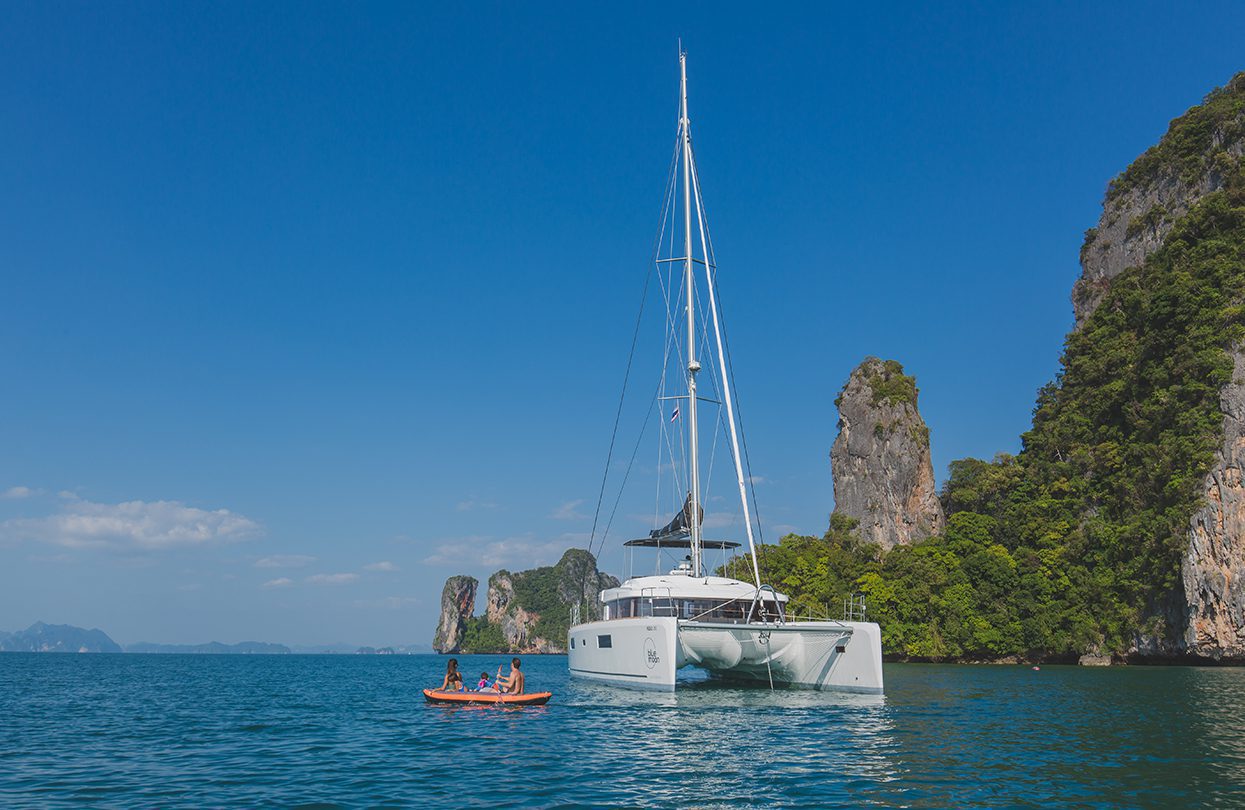
The Blue Moon catamaran is well equipped with snorkelling gear and kayaks to double the fun, Photo – Wan Tse, Simpson Yacht Charter
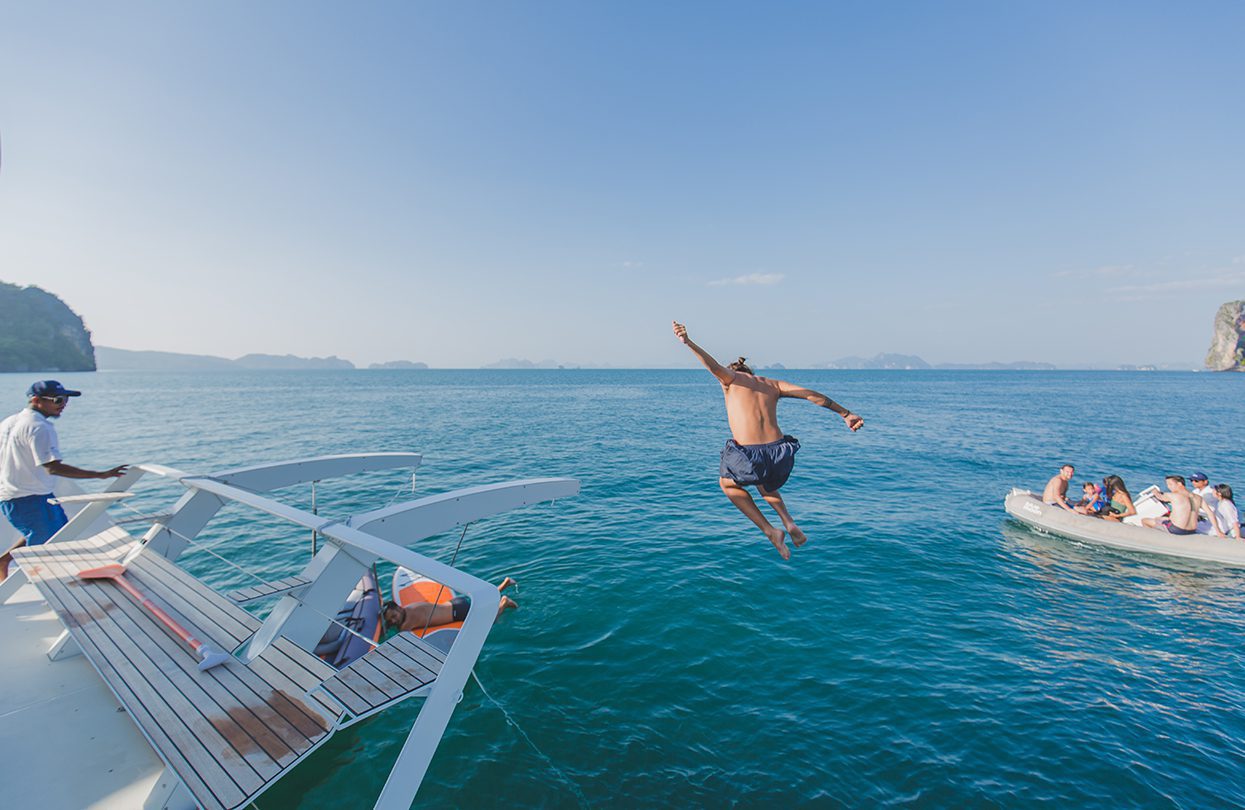
Plunging into the cool waters of Phuket to beat the heat, Photo – Wan Tse, Simpson Yacht Charter
With the need to ensure social distance is maintained and general guidelines to avoid crowds, I am of the opinion that exploring Phuket’s many islands and waterways on your own private yacht is a safer and far more appealing activity as compared to visiting the usual tourist zones within Phuket. To explore, unwind and refresh with scenery that’s agreeable for the 1974 Bond, you are in for a treat the moment you step onboard.
Apart from the day trips, Simpson Yacht Charter has designed many more luxurious itineraries with the Blue Moon catamaran in mind that ranges from a weekend trip to a 15-day adventure. For a long weekend getaway, you fly in to Phuket on a Thursday night with dinner at the marina and then drinks on the boat. The crew makes final preparations to sail on the Friday morning while is enjoying breakfast at the marina. Friday’s ‘hectic’ schedule has fun slated for every hour of the day. Sail and snorkel along the coral reefs of Phuket and head back to land for dinner. Head out to a quiet bay for after-dinner drinks on board in the company of stars overhead and gentle waves; the crew sets the mood with candles, wine & cheese and anything else one desires. Saturday is all about cruising the Andaman Sea making stops along the way as per the desire of the day – snorkel amongst the marine life in national parks or snooze on a hammock with a chilled Champagne close by. The catamaran’s WIFI ensures all the moments get captured on Instagram on the fly. Saturday’s leisure spills over to Sunday, with the catamaran heading back to the marina as per the flight schedule out of Phuket.
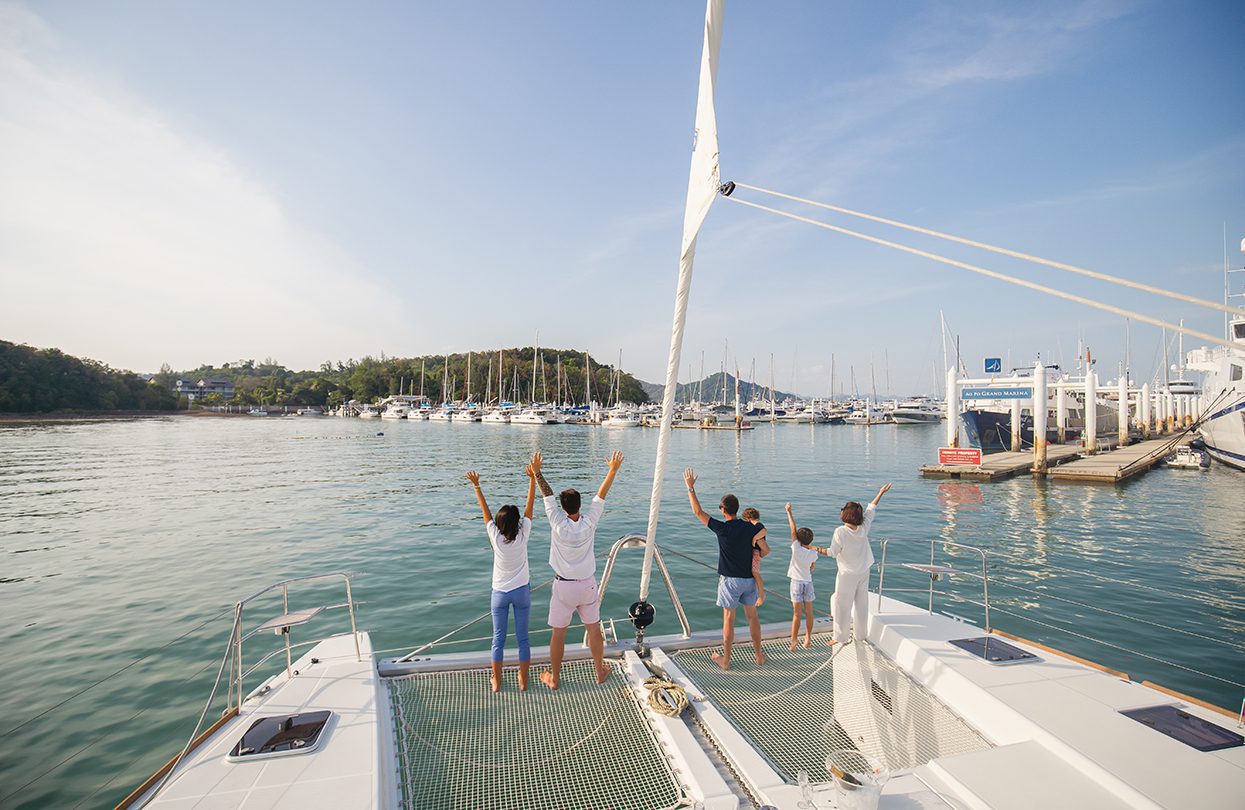
The luxurious 52 feet long catamaran Blue Moon returns to the Ao Po Grand Marina located on the eastern edge of Phuket, Photo – Wan Tse, Simpson Yacht Charter
The 15-day itinerary allows one to comprehensively cover the bay that includes Ko Racha Yaï, Ko Phi Phi, Ko Lanta, Ko Muk, Ko Rok Nok, Ko Ha Yaï and Ko Kaï where one can walk from one island to another during low tide. For getting to experience crossing international waters from Thailand to Malaysia, their 12 day Phuket to Langkawi itinerary covers islands and beaches such as Ko Lipe Butang archipelago that are far away from tourist tracks and include marine parks that are very much pristine and rated as among the best in the world.
A private cruise on board a luxurious yacht can become a case of ‘plan, experience and repeat’.
To learn more about the weekend itineraries visit www.simpsonyachtcharter.com or email to [email protected]. 
Subscribe to the latest edition now by clicking here.
© This article was first published online in July 2020 – World Travel Magazine.
The post Sail Away On A Catamaran Amidst Breathtaking Views Of Phuket first appeared on World Travel Magazine.
]]>